FINANCE
LOSS
JUST
ADAPTATION MITIGATION
COLLABORATION







FINANCE
LOSS
JUST
ADAPTATION MITIGATION
COLLABORATION







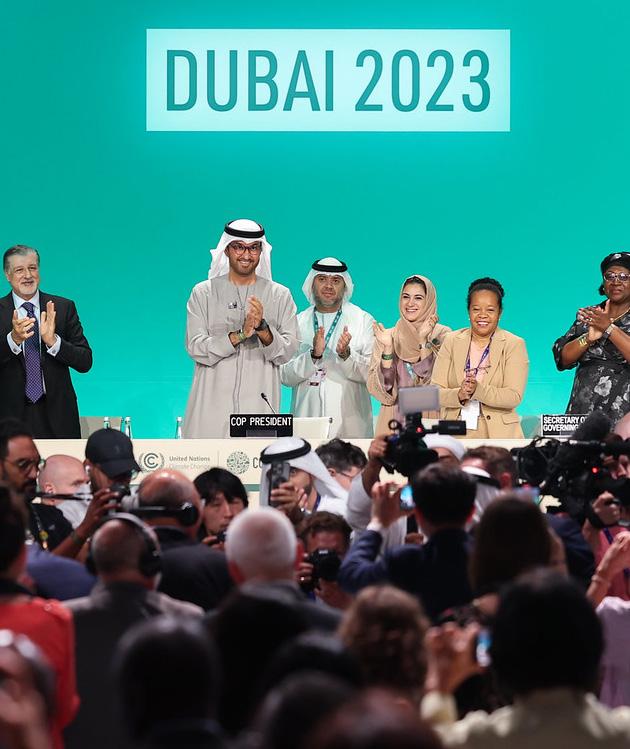
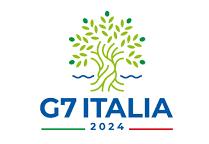



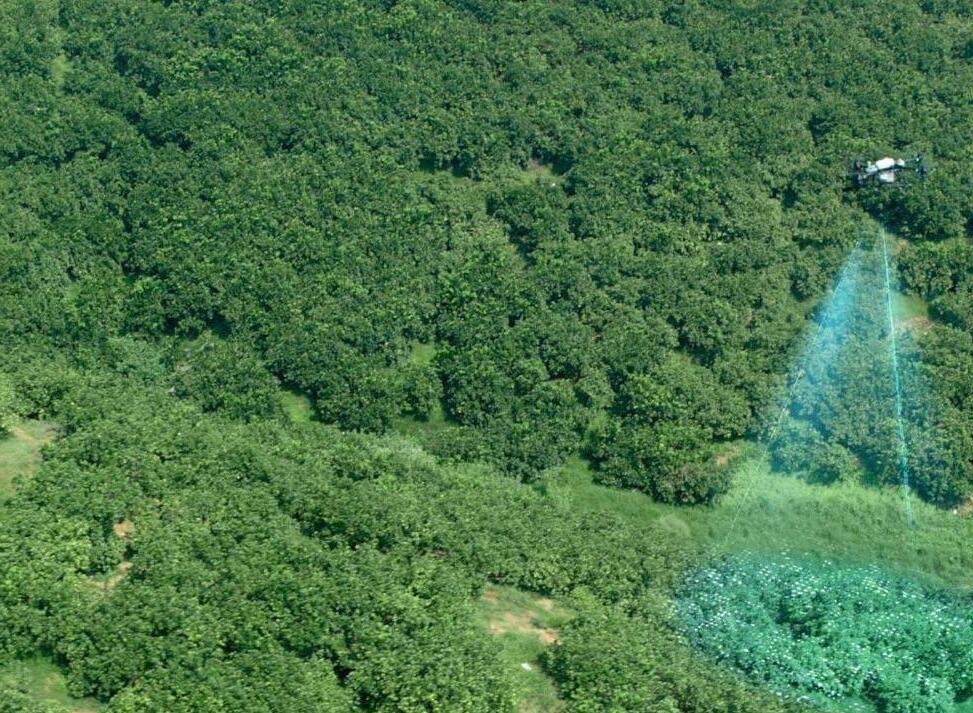
In the evolving battle against climate change, the integrity of carbon credit markets stands as a critical frontier. EcoSpera emerges as a visionary force, poised to redefine this landscape with its innovative solution that ensures unparalleled transparency, traceability, and integrity. Rooted in the lessons of past projects and aligned with the latest regulatory standards, including the Corporate Sustainability Reporting Directive (CSRD), European Sustainability Reporting Standards (ESRS), and the Voluntary Carbon Market Integrity Initiative (VCMI), EcoSpera’s mission goes beyond remediation to set a new benchmark in environmental accountability. Through its unique approach, combining blockchain technology with a cooperative governance model, EcoSpera is not just addressing the climate crisis but is leading the charge towards a sustainable future with high-integrity carbon credits.
The Kariba REDD+ project, once a beacon of hope for carbon offsetting, aimed to protect forests and wildlife on the Zimbabwe-Zambia border. Despite its ambitious goals for sustainability and carbon sequestration, it faced criticism for its shortcomings in verifiability and long-term environmental impact. This case underscores a broader issue within the carbon credit market—a pressing need for verifiable, sustainable projects that deliver on their promises.
The regulatory landscape is evolving to address these challenges. The CSRD/ ESRS requirements and the VCMI’s new guidelines for high-integrity carbon credits represent significant strides toward ensuring that carbon offset projects are both environmentally and socially beneficial. These regulations aim to establish clear, stringent standards for transparency, accountability, and the real-world impact of carbon credits, pushing the
market towards more reliable and impactful practices.
This backdrop of ambitious projects falling short and tightening regulations highlights the urgent necessity for innovative approaches like EcoSpera’s. By leveraging advanced technologies and adhering to the highest standards of integrity, EcoSpera is positioned to address these shortcomings, offering a new paradigm that meets and exceeds the evolving demands of the global carbon credit market.
EcoSpera’s Mission and innovative approach
EcoSpera’s mission transcends the traditional boundaries of the carbon credit market, championing a future where integrity, traceability, and transparency are not just ideals, but foundational pillars. At its core, EcoSpera leverages cutting-edge blockchain technology to ensure every carbon credit is verifiable and secure,
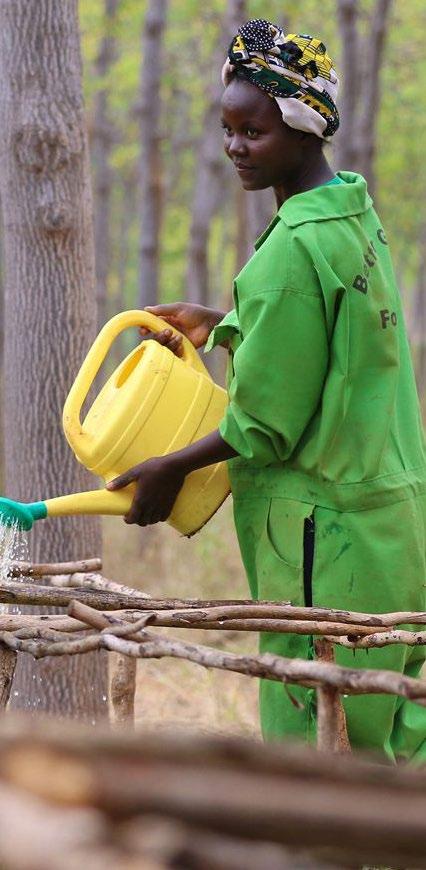
eliminating doubts about authenticity and impact. This technological backbone is complemented by EcoSpera’s governance through a Liechtenstein Venture Co-operative (LVC), a structure that combines the agility of a venture-backed entity with the ethical and participatory ethos of a cooperative. This innovative governance model ensures that all stakeholders have a voice in the direction and decisions of the initiative, enhancing accountability and aligning with global sustainabilitygoals.
The Decentralized Autonomous Organization (DAO) further democratizes EcoSpera’s operations, enabling community members from around the world to contribute to its mission. This approach not only fosters a broad sense of ownership and involvement but also ensures that a diverse range of perspectives and expertise shapes the future of EcoSpera. By integrating community governance with blockchain’s
ECOSPERA’S MISSION TRANSCENDS THE TRADITIONAL BOUNDARIES OF THE CARBON CREDIT MARKET, CHAMPIONING A FUTURE WHERE INTEGRITY, TRACEABILITY, AND TRANSPARENCY ARE NOT JUST IDEALS, BUT FOUNDATIONAL PILLARS.

transparency and the strategic framework of an LVC, EcoSpera is pioneering a holistic approach to carbon credit verification.
This model addresses the market’s critical need for projects that can be thoroughly audited and trusted.
EcoSpera’s platform offers an end-toend solution from the initial certification of a carbon credit to its final retirement, ensuring that each step in the process is recorded, transparent, and aligned with the highest standards of environmental integrity. Through this comprehensive approach, EcoSpera is not just contributing to the global fight against climate change but is also setting a new standard for how carbon credits are generated, traded, and retired. The ultimate goal is to inspire confidence among all stakeholders—investors, environmental groups, and regulatory bodies—that the carbon credits represent real, tangible environmental benefits.
The EcoSpera Ecosystem represents an integrated approach to carbon credit verification, ensuring every step from seed planting to credit retirement is transparent, traceable, and aligned with the highest standards of environmental integrity. By weaving together specialized
components like EcoAdvis, Trees4CO2, Better Globe Forestry, Nzatu Food Group, TraceX, and the Spera Impact Blockchain (SPIT), EcoSpera not only adheres to but also surpasses the stringent requirements set by CSRD, ESRS, and VCMI.
• Spera Impact Blockchain (SPIT) is the backbone of the EcoSpera ecosystem and enhances it’s traceability, offering an additional layer of security and verification for every transaction within the EcoSpera ecosystem. By making all data related to carbon credits readily available and indisputable, SPIT ensures the integrity of the credits and the projects they represent.
• EcoAdvis offers expert project management and compliance services, guiding projects to align with international sustainability standards, ensuring that each initiative within the EcoSpera ecosystem contributes positively to the environment and society while adheringto regulatory requirements.
• Trees4CO2 embodies the direct action of reforestation and afforestation, translating carbon credits into real-world environmental benefits. This initiative focuses on planting species like mahogany and moringa, which are known for their high carbon sequestration rates, directly combating climate change.
• Better Globe Forestry focuses on sustainable forestry practices that promote biodiversity, prevent desertification, and provide sustainable livelihoods for local communities. Its operations generate verifiable carbon credits by maintaining healthy forests that act as carbon sinks.
• Nzatu Food Group integrates sustainable agriculture practices, ensuring that projects support food security and socio-economic development, emphasizing the socialsustainability aspect of carbon credit projects.
• TraceX leverages blockchain technology to provide a transparent and unalterable record of carbon credit transactions, from the initial issuance to their final retirement. →
→ This ensures that all stakeholders can trust the authenticity and impact of the credits. This comprehensive ecosystem approach ensures that every carbon credit issued by EcoSpera is backed by real, verifiable environmental actions. By exceeding the standards set by CSRD, ESRS, and VCMI, EcoSpera not only contributes to the fight against climate change but also sets a new benchmark for transparency and integrity in the carbon credit market. Through this model, EcoSpera demonstrates how innovative technologies and cooperative governance can be harnessed to create a sustainable future, showcasing a scalable, replicable solution for global environmental challenges.
Addressing challenges and setting a new standard for carbon and biodiversity credits
Expanding the content to triple its length while maintaining the essence and introducing more depth:
EcoSpera’s strategic approach is deeply informed by the insights gained from the analysis of past carbon credit initiatives, such as the Kariba project. Recognizing the critical need for genuine sustainability, reliable verification processes, and meaningful community engagement, EcoSpera has engineered its model to transcend these historical pitfalls.
Central to its strategy is an unwavering commitment to the principles outlined by the Voluntary Carbon Market Integrity Initiative (VCMI). Through meticulous alignment with VCMI’s Monitoring, Reporting, and Assurance Framework, EcoSpera ensures each carbon credit’s journey from issuance to retirement is meticulously documented and verified, setting a precedent in the industry.
Further advancing the standard, EcoSpera embraces ‘Scope 3 Flexibility’ within its operational framework. This innovative approach allows for a more inclusive and comprehensive accounting of carbon credits, enhancing the scope and credibility of claims. By meticulously adhering to and expanding upon VCMI guidelines, EcoSpera is not merely participating in the market; it is actively redefining the paradigms of
accountability, transparency, and environmental stewardship.
EcoSpera’s holistic model, built on the lessons of past endeavors and the rigorous standards of current environmental integrity frameworks, positions it as a vanguard in the carbon credit market. The initiative’s forward-thinking approach—marrying technological innovation with stringent adherence to global sustainability standards—illustrates a blueprint for future projects. EcoSpera’s commitment to exceeding existing standards and setting new benchmarks reflects a broader mission: to cultivate a carbon credit market that is not only robust and reliable but also a true catalyst for global environmental change.
To fully articulate EcoSpera’s vision and its strategic direction for a sustainable future, it’s essential to highlight the initiative’s commitment to deepening its impact on the global carbon credit market through innovation, collaboration, and expansion. EcoSpera is poised to extend its reforestation and afforestation projects, incorporating a broader array of species and ecosystems, thus enriching biodiversity and EcoSpera exemplifies a revolutionary stride towards sustainability in the carbon credit market, setting new benchmarks for transparency, integrity, and environmental stewardship. Its comprehensive approach and innovative solutions underscore a commitment to addressing climate change, fostering biodiversity, and promoting sustainable development. As EcoSpera advances, its model of collective action, underpinned by cutting-edge technology, offers a beacon for global efforts towards a greener future. This initiative not only highlights the potential for impactful change but also inspires a broader movement towards sustainable practices worldwide, making EcoSpera a paragon for future endeavors in environmental conservation and carbon reduction.enhancing carbon sequestration capacities. The initiative’s expansion into new territories is strategically planned to ensure that
ECOSPERA STANDS AS A GROUNDBREAKING LEADER IN THE CARBON CREDIT MARKET, UNIQUELY OFFERING PLANT-LEVEL VERIFICATION AND CERTIFICATION WITH A DETAILED AUDIT TRAIL FROM SEED TO RETIREMENT. THIS UNPARALLELED APPROACH MARKS ECOSPERA AS NOT JUST A PARTICIPANT IN THE MARKET BUT AS THE VANGUARD OF A SUSTAINABILITY REVOLUTION.

each project aligns with local ecological conditions and community needs, fostering environmental resilience and sustainable development. Moreover, EcoSpera envisions leveraging its blockchain technology to further enhance the traceability and verification of carbon credits, setting new industry benchmarks for integrity and reliability. This technological advancement will enable EcoSpera to offer unparalleled transparency in its operations, reinforcing stakeholder confidence and driving the adoption

of high-integrity carbon credits globally. Through collaborative efforts with governments, NGOs, and local communities, EcoSpera aims to amplify its contribution to combating climate change, promoting sustainable land management practices, and supporting socio-economic development in underserved regions. This comprehensive approach underscores EcoSpera’s dedication to not just mitigating global carbon emissions but also to fostering a more equitable and sustainable world. ■
EcoSpera stands as a groundbreaking leader in the carbon credit market, uniquely offering plant-level verification and certification with a detailed audit trail from seed to retirement. This unparalleled approach marks EcoSpera as not just a participant in the market but as the vanguard of a sustainability revolution. By joining the EcoSpera’s 100% Together Community, members become integral to a movement setting new global standards for environmental integrity. This opportunity to be part of such a pioneering venture is a call to action for those looking to make a tangible impact on our planet’s future.
EcoSpera is not just inviting members; it’s inviting change-makers to be at the forefront of an environmental revolution, making a real difference in the fight against climate change.

In a world where environmental consciousness shapes consumer preferences, the hospitality industry stands at the forefront of a significant transformation. This sector, historically associated with luxury and comfort, now faces the urgent need to integrate sustainability into its core operations.
As travelers increasingly seek experiences that align with their values, embracing green practices becomes not just an ethical choice, but a competitive necessity.
This article delves into the industry’s journey towards sustainability, exploring the challenges, opportunities, and pioneering examples that highlight the potential for luxury and environmental stewardship to coexist harmoniously.
Over two decades in the sustainable hospitality sector reveal a landscape transformed by evolving consumer expectations and a profound
understanding of our environmental impact. This journey from traditional luxury to green luxury underscores an industry-wide shift towards practices that honor ecological stewardship without compromising on the quality of the guest experience.
The initial reluctance to adopt green practices stemmed from misconceptions about cost and guest satisfaction. However, pioneering establishments soon demonstrated that sustainable operations could reduce long-term expenses and enhance brand reputation. Innovations such as rainwater harvesting, solar energy, and zero-waste kitchens have set new benchmarks, proving sustainability’s viability and profitability.
One of the persistent challenges has been the significant initial investment required for sustainable technologies.
Yet, with advancements in green technology and increased availability of funding options, these hurdles are becoming surmountable. Operational disruptions, another major concern, are addressed through strategic planning and staff training, ensuring a seamless transition to greener practices.
Elevating consumer awareness has been crucial. Early on, the demand for sustainable options was limited, but today, informed travelers actively seek out eco-friendly accommodations. This shift has been driven by targeted marketing, transparent communication about sustainability efforts, and engaging guests in these initiatives.
Reflecting on the past twenty years, it’s clear the hospitality industry’s journey towards sustainability is not just about environmental responsibility but also about redefining luxury in the 21st
century. As we look to the future, the continuous evolution of sustainable practices will remain key to meeting the dynamic expectations of travelers and preserving our planet for generations to come.
Expanding the original article to include detailed insights on the Michelin Green Star and ISO 21401, alongside the implications of the EU’s Corporate Sustainability Reporting Directive (CSRD) and the European Sustainability Reporting Standards (ESRS), offers a holistic view of the sustainability trajectory in the hospitality sector. The updated narrative delves into the criteria and impact of these certifications and standards, providing a richer understanding of their role in promoting sustainable practices.
The hospitality industry is at a pivotal moment, where the convergence of regulatory frameworks and voluntary certifications is reshaping the landscape of sustainable operations. The integration of global sustainability goals into business practices is now a paramount objective, driven by consumer demand, environmental imperatives, and legislative mandates.
ISO 21401:
The Michelin Green Star represents the pinnacle of sustainable gastronomy, awarded to restaurants that demonstrate exemplary commitments to sustainability. Criteria for this prestigious recognition include the sourcing of ingredients, the use of seasonal produce, efficient waste management systems, and a strong commitment to ethical and environmental standards. Since its inception in 2020, the Michelin Green Star has highlighted the efforts of restaurants working closely with local producers, employing regenerative methods, and engaging in charitable and educational projects to promote sustainability(60†source)(61†source).
ISO 21401, on the other hand, provides a framework for sustainable management within the tourism sector, focusing on environmental, social, and economic
practices. It guides tourism accommodations on implementing sustainable practices that minimize their environmental impact while enhancing efficiency and stakeholder relationships.
The EU’s CSRD and ESRS are setting new precedents in sustainability reporting, requiring a broad array of companies to disclose their social and environmental impacts. These frameworks aim to bring sustainability reporting to the same standard as financial reporting, ensuring transparency and comparability.
The ESRS, in particular, emphasize the principle of double materiality, requiring disclosures on a wide range of topics following thorough materiality assessments. These standards are not only reshaping how companies report on sustainability but also how they integrate sustainable practices intotheir core operations(46†source) (47†source)(48†source).
For the hospitality industry, these developments signal a shift towards more rigorous sustainability practices and reporting. Adapting to the CSRD and ESRS will require businesses to assess and report on a range of environmental, social, and governance matters, from the governance of sustainability topics to the impacts, risks, and opportunities across their value chain. This aligns with the criteria set by the Michelin Green Star and ISO 21401, further emphasizing the industry’s move towards comprehensive sustainability.
The intersection of voluntary certifications like the Michelin Green Star and ISO 21401 with regulatory mandates such as the CSRD and ESRS is defining a new era for the hospitality industry. This convergence underscores a growing commitment to sustainability that transcends traditional boundaries, embodying a comprehensive approach to environmental stewardship, social

THE MICHELIN GREEN STAR REPRESENTS THE PINNACLE OF SUSTAINABLE GASTRONOMY, AWARDED TORESTAURANTS THAT DEMONSTRATE EXEMPLARY COMMITMENTS TO SUSTAINABILITY.
responsibility, and governance. As the industry continues to evolve, these frameworks will play a crucial role in shaping its sustainable future.
Nestled amidst the rolling hills of Tuscany, Villa Petriolo stands as a paragon of sustainable luxury, seamlessly blending the rich heritage of Italian agriturismo with cutting-edge environmental stewardship. This article explores the transformative journey of Villa Petriolo, showcasing its commitment to sustainability, the innovative practices it has adopted, and the broader implications of its success for the hospitality industry.
Embracing Sustainability with Tradition
Villa Petriolo, a centuries-old estate, has embarked on an ambitious quest to infuse sustainability into the fabric of its operations without sacrificing →
→ its historical essence. The estate’s approach is holistic, extending from the PS Ristorante, which champions a farm-to-table philosophy, to the SPA Mater, offering treatments with organically sourced products. The estate manager and key personnel have navigated the challenges of integrating modern eco-friendly technologies into the villa’s historic framework, achieving a harmonious balance between preserving tradition and embracing innovation. Initiatives include utilizing solar energy, water recycling systems, and organic farming practices that honor the villa’s legacy while safeguarding the environment.
The transition to sustainability was fraught with challenges, from integrating eco-friendly technologies into the villa’s historical architecture to managing the economic implications of such investments. However, Villa Petriolo turned these challenges into opportunities for growth and innovation, demonstrating that with patience, persistence, and community engagement, it is possible to achieve a sustainable business model that respects tradition while looking forward.
The Villa’s journey underscores several key lessons for the hospitality industry:
• Patience and Persistence: Transitioning to sustainable practices is a gradual process that requires time, effort, and adaptation.
• Community Engagement: Building strong relationships with local producers and the community is crucial for a sustainable business model.
• Balancing Tradition and Innovation: It is possible to preserve historical integrity while embracing modern sustainability practices.
Villa Petriolo’s sustainability initiatives have had profound environmental, social, and economic impacts:
• Environmental Impact: The adoption of solar power and sustainable farming practices has led to a significant
reduction in carbon emissions and water usage.
• Social Impact: Focusing on local sourcing and employment has bolstered the local economy, increased job satisfaction, and strengthened community ties.
• Economic Impact: Despite the high initial investments, the return on investment has been positive, with an increase in guest bookings attributed to the villa’s reputation as a sustainable luxury destination.
Villa Petriolo’s journey towards sustainability offers a compelling case study of how luxury and environmental stewardship can coexist. Through innovative solutions, a commitment to the community, and respect for tradition, Villa Petriolo has set a new benchmark for sustainable luxury in the hospitality industry. Its success story illustrates that embracing sustainability is not only beneficial for the environment but can also enhance guest experiences, support local communities, and contribute to the economic viability of luxury estates. Villa Petriolo stands as a beacon of inspiration, proving that with vision and dedication, it is possible to chart a sustainable future for luxury hospitality.
Concluding this article on sustainability in the hospitality industry, we reflect on the journey from the foundational challenges and opportunities outlined, through the evolving landscape of certifications and standards, to the inspiring case study of Villa Petriolo. This progression underscores a pivotal shift in the industry towards embracing and implementing sustainable practices at every level.
Villa Petriolo, with its commitment to sustainable agriculture, renewable energy, and community engagement, exemplifies the tangible impact that dedication to sustainability can have. It’s a testament to the hospitality industry’s potential to innovate and lead by example in the broader quest
VILLA PETRIOLO, WITH ITS COMMITMENT TO SUSTAINABLE AGRICULTURE, RENEWABLE ENERGY, AND COMMUNITY ENGAGEMENT, EXEMPLIFIES THE TANGIBLE IMPACT THAT DEDICATION TO SUSTAINABILITY CAN HAVE. IT’S A TESTAMENT TO THE HOSPITALITY INDUSTRY’S POTENTIAL TO INNOVATE AND LEAD BY EXAMPLE IN THE BROADER QUEST FOR ENVIRONMENTAL STEWARDSHIP AND SOCIAL RESPONSIBILITY.
for environmental stewardship and social responsibility.
As we look to the future, the insights gleaned from these discussions illuminate a path forward marked by increased transparency, accountability, and a deep-seated commitment to the planet and its people. The hospitality industry, with its global reach and influence, is uniquely positioned to drive meaningful change, leveraging certifications like the Michelin Green Star, adhering to comprehensive standards such as ISO 21401, and aligning with rigorous reporting directives like the CSRD and ESRS.
The journey towards sustainability is complex and ongoing, but through collective effort, innovation, and a shared vision, the hospitality industry can continue to evolve, setting new benchmarks for excellence and sustainability. Villa Petriolo stands as a testament to the hospitality industry’s potential for embracing ethical luxury while contributing positively to the environment and local communities. Their commitment serves as an inspiring model for others in the sector. For a deeper understanding of their sustainability journey, visit Villa Petriolo’s website.
A new project is rising as well in this heart of Italy, in the same area as the renaissance started in Firenze, we are now embarking on a journey with an

even higher standard, going further than ever. In Italian we call it Lusso Verde, or Green Luxury.
Lusso Verde - A new renaissance for hospitality and sustainability In the coming months the full Lusso Verde project will be revealed. It is setting new standards for hospitality and sustainability, going further than any certification or standards have gone, without compromise for nature and the environment.
Lusso Verde is a co-operative founded on the rich history of Italian hospitality, going all the way back to the year 990 when Archbishop Sigeric walked from Canterbury to Rome to speak with the
pope, on what’s called Via Francigena.
The first project under the Lusso Verde umbrella is rocking with one of the deepest things in Italian culture, the coffee. In Italy there are around 50.000 coffee bars and Italians consume on average almost 6 kg of coffee per year, or almost 2,5 cups every day, all year around.
This becomes almost 8 million tons of CO2 emissions and the Lusso Verde project on coffee has the ambition to compensate every single ton by 2030. It will demand new production methods and new ways to compensate for the emissions. You are invited to follow the development at lussoverde.it. ■


• Michelin Guide’s explanation of the Green Star criteria provides insight into the rigorous evaluation process focused on sustainability practices within the gastronomy sector(60†source)(61†source).
• ISO 21401:2018, which outlines the requirements and guidelines for sustainability management in tourist accommodations, enhancing their environmental, social, and economic impacts, you can refer to the official ISO website: ISO 21401:2018
• The European Commission details the CSRD’s scope and objectives, emphasizing the integration of sustainability reporting with financial reporting(46†source).
• KPMG and PwC offer analyses on the ESRS, highlighting the standards’ focus on double materiality and the broad range of topics covered(47†source)(48†source).
In the heart of every seed lies the potential for incredible growth. Just as the moringa seed holds the promise of nourishment and renewal, our platform lays the groundwork for a sustainable future.

With the world's first global standard for environmental credit, from plant to seed, we're not just planting seeds—we're nurturing the very foundation of environmental stewardship.
Join us in sowing the seeds of change, where every credit supports verified, tangible environmental regeneration. Together, we can cultivate a greener, more sustainable world. From the ground up, let's build a legacy of growth and resilience for generations to come.










The bloom of the moringa flower is a testament to what can be achieved when we commit to nurturing our environment. It symbolizes the flourishing beauty and tangible benefits that stem from our dedication to sustainability and regenerative practices.


Our platform is more than a bridge between intention and action; it's a catalyst for real-world change. Through our comprehensive audit trail, from seed to standard, we ensure that every environmental credit contributes to a healthier, more vibrant planet.

This is the power of transformation, visible in the vibrant petals of the moringa and felt through the positive impact of each credit. Embrace the beauty of making a difference. Together, we're not just growing flowers—we're cultivating a legacy of environmental regeneration and hope for future generations.
Start Your Journey with a Seed of Change
Read more: https://www.ecospera.com/join/

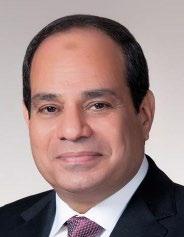 Abdel Fattah El-Sisi PRESIDENT OF EGYPT
Abdel Fattah El-Sisi PRESIDENT OF EGYPT
The hosting of COP27 in the green city of Sharm El-Sheikh this year marks the 30th anniversary of the adoption of the United Nations Framework Convention on Climate Change. In the thirty years since, the world has come a long way in the fight against climate change and its negative impacts on our planet; we are now able to better understand the science behind climate change, better assess its impacts, and better develop tools to address its causes and consequences.
Thirty years and twenty-six COPs later, we now have a much clearer understanding of the extent of the potential climate crisis and what needs to be done to address it effectively. The science is there and clearly shows the urgency with which we must act regarding rapidly reducing emissions of greenhouse gases, taking necessary steps to assist those in need of support to adapt to the negative impacts of climate change, and finding the appropriate formula that would ensure the availability of requisite means of implementation that are indispensable for developing countries in making their contributions to this global effort, especially in the midst of the successive international crises, including the ongoing food security crisis exacerbated by climate change, desertification and water scarcity, especially in Africa that suffers the most impacts.
In 2015, the world came together and showed the will to make the necessary compromises which led to the successful adoption of the Paris Agreement. Today and in light of the unmistakable messages in the recent IPCC reports, and following COP26 in Glasgow, we are once
again called upon to act rapidly if we are to really meet the 1.5-degree goal, build our resilience, and enhance our capacity to adapt. And while these are no doubt major undertakings, I sincerely believe that they can also become opportunities for transformation towards sustainability if we collectively think creatively and demonstrate the necessary political will.
With this in mind, Egypt and its people look forward to welcoming you all at COP27 in Sharm El-Sheikh, where we trust the world will come together, yet again, to reaffirm its commitment to the global climate agenda despite the difficulties and uncertainties of our time. I am positive that all parties and stakeholders will be coming to Sharm El-Sheikh with a stronger will and a higher ambition on mitigation, adaptation and climate finance, demonstrating actual success stories on implementing commitments and fulfilling pledges.
I deeply believe that COP27 is an opportunity to showcase unity against an existential threat that we can only overcome through concerted action and effective implementation. As incoming Presidency Egypt will spare no effort to ensure that COP27 becomes the moment when the world moved from negotiation to implementation and where words were translated to actions, and where we collectively embarked on a path towards sustainability, a just transition and eventually a greener future for coming generations.
Welcome to Sharm El-Sheikh. Welcome to COP27.
“In 2015, the world came together and showed the will to make the necessary compromises which led to the successful adoption of the Paris Agreement. Today and in light of the unmistakable messages in the recent IPCC reports, and following COP26 in Glasgow, we are once again called upon to act rapidly if we are to really meet the 1.5-degree goal, build our resilience, and enhance our capacity to adapt.”
 H.E. Dr. Sultan Ahmed Al Jaber PRESIDENT FOR COP28 UAE
H.E. Dr. Sultan Ahmed Al Jaber PRESIDENT FOR COP28 UAE
At COP21 in 2015, the world agreed to limit global warming to 1.5°C compared to pre-industrial levels by 2050. To remain on target, science tells us that emissions must be halved by 2030. We only have another seven years to meet that goal. COP28 UAE is a prime opportunity to rethink, reboot, and refocus the climate agenda.
Working with the UNFCCC Executive Secretary alongside the UN Climate Change High-Level Champion and the UAE Youth Climate Champion, I will strive to build consensus amongst parties to drive climate action. Together, we will prioritize efforts to accelerate emissions reductions through a pragmatic energy transition, reform land use, and transform food systems. We will work to mobilize solutions for vulnerable countries, operationalize loss and damage, and deliver the most inclusive Conference possible.
Dr. Al Jaber is the first CEO to ever serve as COP President and brings with him sound business acumen, a deep understanding of economics and leverages his decades-long experience in the energy sector, encompassing both renewable and traditional energies. During his double tenure as Special Envoy for Climate Change (2010- 2016, 2020-present), Dr. Al Jaber has played a seminal role in shaping the country’s clean energy path, including as founding CEO and currently the Chairman of Masdar, Abu Dhabi’s pioneering renewable energy initiative, that has since become a leading global clean energy player. Dr. Al Jaber has also been an outcomes-focused participant at over 11 COPs, including the historic Paris COP21 in 2015. Upon joining Abu Dhabi National Oil Company (ADNOC) as its CEO, Dr. Al Jaber has spearheaded a $15 billion decarbonization strategy and new low-carbon solutions business.
Addressing the climate crisis requires bold and rapid collective action
Egypt’s COP27 presidency vision is to move from negotiations and planning to implementation. Now is the time for action on the ground. It is therefore incumbent upon us to move rapidly towards full, timely, inclusive, and at-scale action on the ground. We need to harmonize our global efforts. If we are to meet our pledges and commitments words must be turned into action.
Globally, the increasing frequency and intensity of extreme weather events is impacting the lives and livelihoods of millions of people. Rising global average temperature and rapid global warming are causing alarming consequences on human beings and all other forms of life on earth.
In fact, the climate crisis will aggravate social, economic and environmental threats. Thus, urgent actions are needed to address the climate crisis and to strengthen the implementation of response with an aim to create a resilient planet.
Our collective efforts to combat the adverse impacts of climate change are necessary/crucial if we are to secure a sustainable future for all.
What’s COP27?
A defining moment in the fight against climate change. Science has established beyond doubt that the window for action is closing rapidly. In November 2022, Egypt will host the 27th Conference of the Parties of the UNFCCC (COP27) in Sharm El-Sheikh, with a view to building on previous successes and paving the way for future ambition.
A golden opportunity for all stakeholders to rise to the occasion and tackle effectively the global challenge of climate change facilitated by Egypt on the African continent.
It is the 2022 United Nations Climate Change Conference Egypt assumes the incoming Presidency of COP 27 with a clear recognition of the gravity of the global climate challenge and appreciation of the value of multilateral, collective and concerted action as the only means to address this truly global threat.
As we approach COP27, we are committed to support an inclusive, transparent and party-driven process to ensure timely and adequate action.
From Stockholm, Rio, Bali, Kyoto, Durban, Paris, Katowice, Glasgow to Sharm El-Sheikh Global political will, supported by science heading to a paradigm shift through just and ambitious transformation.
IPCC has provided the credible science, successive COP decisions laid out the collective governmental actions, The Convention and its agreements outlined the principles, legal obligations and guidelines for collective action.
Recent IPCC reports have highlighted the gravity of the climate crisis and the need for immediate and sustained political will, impactful action and effective cooperation. Building on Glasgow’s momentum, we seek to further enhance the scope of deliverables across the climate action agenda.
We believe there is a need for progress on the ground on all aspects of our work; mitigation, adaptation, finance, loss and damage.
We are aware of the challenges and the opportunities related to climate action, and the potentials and needs of all including those who are in vulnerable situations and the vulnerable communities and we stand ready to engage with all parties to accelerate climate action.
GLOBAL BRIEFING REPORT REVIEW
LEADERS & CEOs

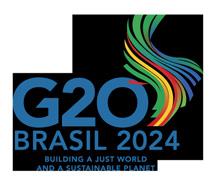
groupofnations COM

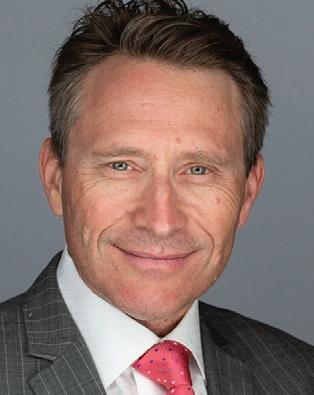
Dear COP Global Community,
As we present the COP27 and COP28 Group of Nations Global Briefing Report, we are reminded of the critical urgency and significance of these United Nations climate change conferences. These gatherings bring together world leaders, policymakers, scientists, and advocates to address one of the most pressing challenges of our time: the climate crisis.
This report aims to provide a comprehensive overview of the key discussions, agreements, and outcomes from COP27 and COP28. Our goal is to offer insights into the progress made and the challenges that lie ahead in the global effort to mitigate climate change and adapt to its impacts.
COP27 and COP28 marked an important milestone in the journey towards a sustainable future. The agreements reached, and the commitments made during this conferences set the stage for a stronger international response to the climate crisis.
We recognize the need for continued ambition, collaboration, and innovation to drive transformative change.
In this report, you will find analysis of the strategies and initiatives that emerged from these conferences, as well as perspectives from experts and stakeholders on the path forward. We explore the advancements in renewable energy, sustainable development, and climate resilience that are shaping a greener, more equitable world.
We are grateful to the leaders and participants of COP27 and COP28 for their dedication to this crucial cause. Their efforts inspire us to continue pushing for meaningful action on a global scale.
We hope this report serves as a valuable resource for policymakers, industry leaders, and individuals committed to combating climate change. Let us use the insights gained here to guide our collective journey towards a sustainable and resilient future. Thank you for being part of this important conversation.


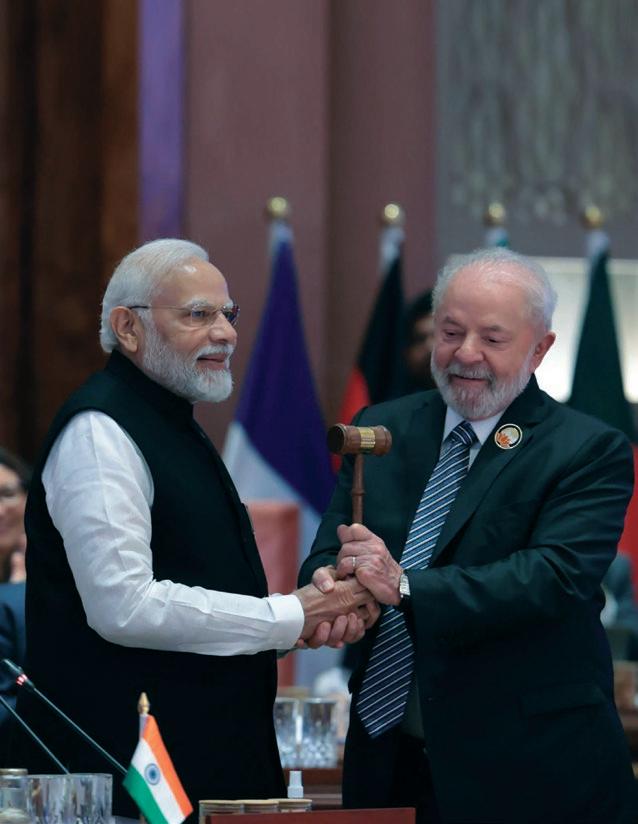

 Dr. Mostafa Madbouly PRIME MINISTER OF THE ARAB REPUBLIC OF EGYPT
Dr. Mostafa Madbouly PRIME MINISTER OF THE ARAB REPUBLIC OF EGYPT
Today more than ever, people across the globe expect action on the ground towards securing the 1.5C goal, and adapting to the negative impacts of climate change through the implementation of the provisions of the Paris Agreement, updating NDCs and fulfilling the broad array of pledges and commitments made in Glasgow by Governments and other entities. This effort will not bear fruit unless global concerted action is taken at all levels and by all actors. COP27 will be the right moment to seize the opportunity and further turn the climate challenge into an opportunity for sustainable development and economic prosperity through investing in a green future for people and planet.
At COP27, we trust that world leaders, negotiators and all stakeholders will be gathering once again to demonstrate their unwavering commitment to climate action on all fronts. Egypt is fully committed to hosting an inclusive Conference where all parties, youth, civil society and the private sector can showcase their action on implementation and delivery and further enhance their ambition towards a just transition based on the principles of equity and common but differentiated responsibilities. I wish you all a successful, fruitful and enjoyable conference and stay in Sharm El-Sheikh.
“COP27
intends to keep the 1.5 degrees alive and at the same time dedicate special efforts to bringing adaptation to the spotlight. COP27 will be the COP for Action! Nevertheless, a COP for implementation needs to devise solutions that are doable.”
 Dr. Sameh Shoukry MINISTER OF FOREIGN AFFAIRS OF THE ARAB REPUBLIC OF EGYPT
Dr. Sameh Shoukry MINISTER OF FOREIGN AFFAIRS OF THE ARAB REPUBLIC OF EGYPT
As we commemorate the 30th anniversary of the UNFCCC, it is indeed Egypt’s privilege to be hosting COP27 in Sharm El-Sheikh.
Climate change is no doubt the challenge of our times, and the international community is hence called upon to deal with this challenge collectively, effectively and rapidly.
In Glasgow we succeeded in concluding for the most part the extensive negotiations to operationalize the Paris Agreement, we must now set our attentions on the full implementation of the Agreement and on the delivery of the various commitments and pledges made. The most reliable science available in the form of the recently published IPCC reports paints a sobering picture, and highlights the urgent need to significantly raise our ambition with regard to emissions reduction, in tandem with the need to effectively adapt to the negative impacts of Climate change. The reports also reminded us of the need to provide and mobilize necessary financial support from public and private sources, along with other means of implementation in the form of technology and capacity building if we are to ensure that developing countries are in a position to make the necessary contribution to this global effort.
Nevertheless, we in Egypt truly believe that the political will demonstrated in Glasgow allowed us to successfully complete our work on the Paris Agreement Work Program, and to announce a
“It
broad range of commitments and pledges. We trust that this political will and genuine commitment will once again be on display in Sharm El-Sheikh and will facilitate making the progress we all aspire to.
And while many governments have stepped up their action and others will hopefully follow suit in the near future, the fact remains that this global effort requires contributions from and collaboration with all non-party stakeholders across the board.
With this in mind, we plan to organize around ten thematic days, and to launch a number of initiatives, and to hold a number of forums and side events all of which will bring governments and non-governmental stakeholders together working in concert towards a common objective. In addition, and cognizant of the indispensable role of youth organizations, we are working to ensure that their voices will be heard and that their views will be taken into consideration as we move towards implementing commitments and actions on the ground.
As incoming Presidency, we commit to all parties to exert all efforts to create an environment conducive to reaching consensus on negotiating texts. This in our view requires a less adversarial and more empathetic approach in dealing with issues at hand, and we trust that all parties will appreciate that our chances of success, collectively, are greatly enhanced when every country, group and community feels that their interests and concerns are taken on board.
is time to move on from negotiations and vows to a stage where execution is a priority. The bar of ambition for every country should also be raised on a par with their capabilities. I applaud every country that updated its nationally determined contributions, including Egypt. I hereby, representing all of you, urge all states to follow suit, especially since a recent evaluation of contributions indicated that they are not commensurate with thegoals of
[the Paris Agreement].”
 Dr. Yasmine Fouad MINISTER OF ENVIRONMENT OF THE ARAB REPUBLIC OF EGYPT
Dr. Yasmine Fouad MINISTER OF ENVIRONMENT OF THE ARAB REPUBLIC OF EGYPT
Climate change is the most challenging crisis of our century. Life as we know it will cease to exist as climate change threatens the balance of our one planet. Higher temperatures, severe storms, increased droughts, rising oceans and flash floods result in the loss of species, food insecurity, water scarcity, increased health risks and rising poverty and displacement. One might say the future is bleak…but humanity has survived diseases, wars and natural disasters throughout history, armed by knowledge, unity and hard work.
Those same ingredients are the only way to fight climate change. Yes, our world is changing and we need to change with it. We need to change the way we do business, we need to adopt new behaviors in our daily lives and we need to adapt the way we think and the way we make decisions. Humanity must adopt agility, innovative thinking, inclusivity and impactful actions.
Egypt has been leading Africa in the combat against climate change since the Paris Agreement. Examples of such efforts are the birth
of the African Renewable Energy Initiative and the African Adaptation Initiative. However, the world still needs to strike the balance between mitigation and adaptation. COP27 intends to keep the 1.5 degrees alive and at the same time dedicate special efforts to bringing adaptation to the spotlight. COP27 will be the COP for Action! Nevertheless, a COP for implementation needs to devise solutions that are doable. No action can be achieved without the necessary enabling tools, namely: finance and science. Bringing state representatives, civil society, youth, women, vulnerable groups and the private sector together in the magical city of Sharm El-Sheikh in November 2022, is the best catalyst to produce real, applicable and feasible outcomes. Sharm El-Sheikh is home to unique biodiversity environments such as the mangroves that demonstrate the importance of nature-based solutions in combating climate change.
The solution to climate change lies within our Earth, within our minds and within our capacities, so let’s come together to take tangible steps to prepare and respond to the greatest threat to humanity.
“COP27 intends to keep the 1.5 degrees alive and at the same time dedicate special efforts to bringing adaptation to the spotlight. COP27 will be the COP for Action! Nevertheless, a COP for implementation needs to devise solutions that are doable.”
 Patricia Espinosa FORMER EXECUTIVE SECRETARY
Patricia Espinosa FORMER EXECUTIVE SECRETARY
Today we mark our remarkable journey together.
We remember the big moments: the adoption of the Convention, the Kyoto Protocol, the Paris Agreement, the Glasgow Climate Pact, and more. But we also remember other moments — moments that do not make the headlines yet are central to our work. The quiet conversation with someone who lost a loved one due to a climate disaster.
Helping someone dedicated to moving a negotiation ahead, inch by inch, paragraph by paragraph, to achieve consensus on a given issue. Or maybe it’s one of the countless innovations, technologies or opportunities we’ve heard and seen from people throughout the world.
We know none of these things exist in isolation — they are part of an ongoing process — part of our ongoing climate journey together. But we’ve still got so far to go. Because despite all of our work, our memories and our successes, science makes one thing clear: nations are not currently on track to achieve their collective goals on climate change. Instead, they are on pace to more than double the Paris Agreement goal of limiting global temperature rise to 1.5°C by the end of this century.
As an organization based on science, this is the biggest fact we face. That’s why the most difficult and challenging part of our journey is not behind us, but ahead. Yet, because of our work, the world is in a better place than it was 30 years ago. We have the Paris Agreement, the rules
for its implementation, and we are focused on supporting everyone to take more climate action.
The key word is everyone — not just countries. We know collective success is only possible when the voices of individual people — people representing all genders, all generations, all sectors and all political stripes — are included in our efforts to address climate change. We are in this together. And UN Climate Change is fully dedicated to supporting all people through its policy of inclusive multilateralism. It’s also why today is about more than marking a date on a calendar: it’s a chance for us to talk about what must come next.
Why the 2020s must be a decade of climate action.
Why leaders must finally shake the comfortable bonds of incrementalism and ensure our collective climate action is both exponential and meaningful — fitting the global climate emergency we face. Tough decisions by all leaders, all sectors and all people are needed now. I believe that together we are up to the challenge.
I am extremely grateful for the incredible work undertaken by my predecessors. Thank you for your leadership. To people everywhere: I encourage you to redouble your efforts in this new decade and this new phase. We may not ultimately know the future of humanity on this planet, but we know it is our job to be responsible stewards of it while we are here.
“We know collective success is only possible when the voices of individual people — people representing all genders, all generations, all sectors and all political stripes — are included in our efforts to address climate change.”
Alok Sharma, President of COP 26 representing the United Kingdom, passed the baton officially to the new Egyptian President of COP 27, HE Sameh Shoukry, during the opening plenary.
During his speech, Mr. Sharma reiterated the achievements made during COP 26, such as finalizing the Paris Rulebook – the guidelines for delivering that Agreement –and making more substantial financial commitments.
He shared that the implementation of last year’s commitments must continue to achieve long-term goals and progress toward 1.5°C warming. He urged leaders to act, expressing, “As challenging as our current moment is, inaction is myopic and can only defer climate catastrophe, we must find the ability to focus on more than one thing at once.”
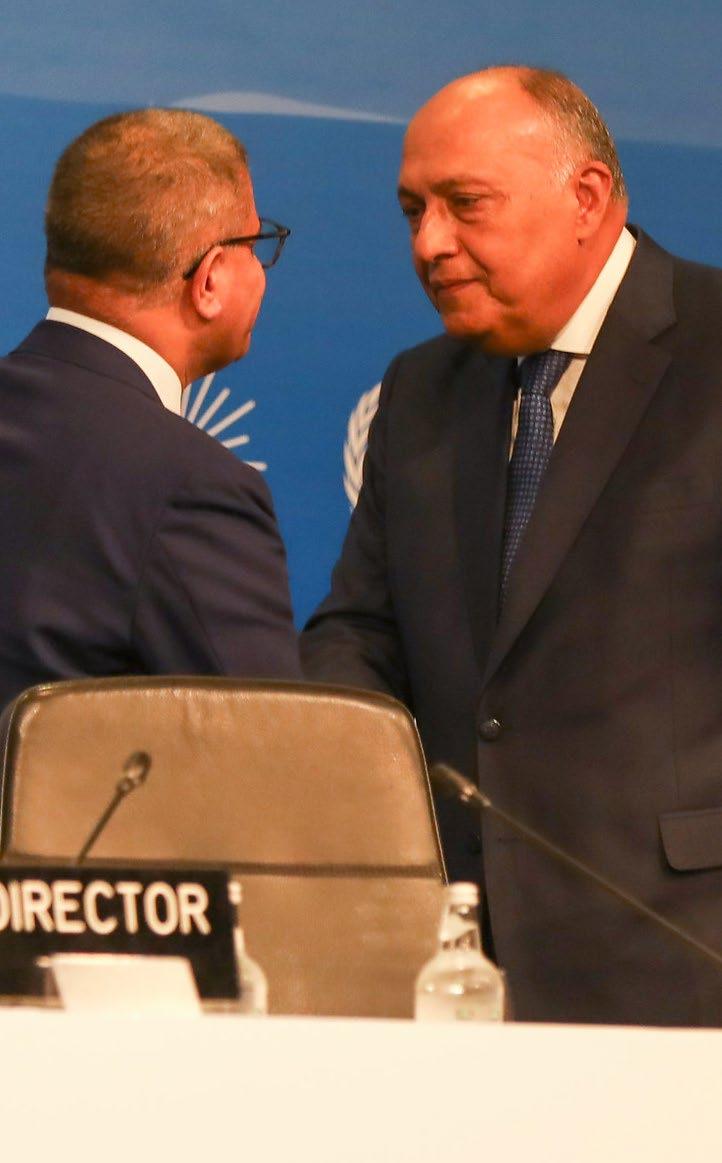
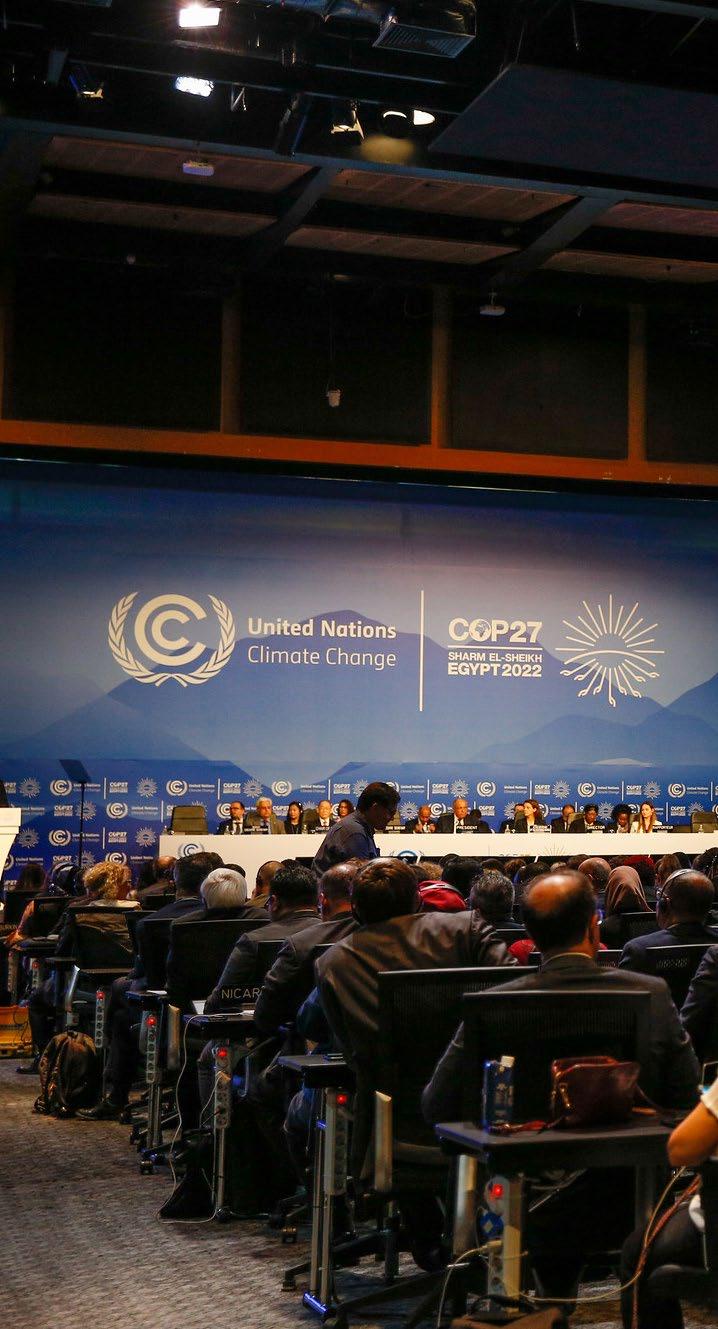
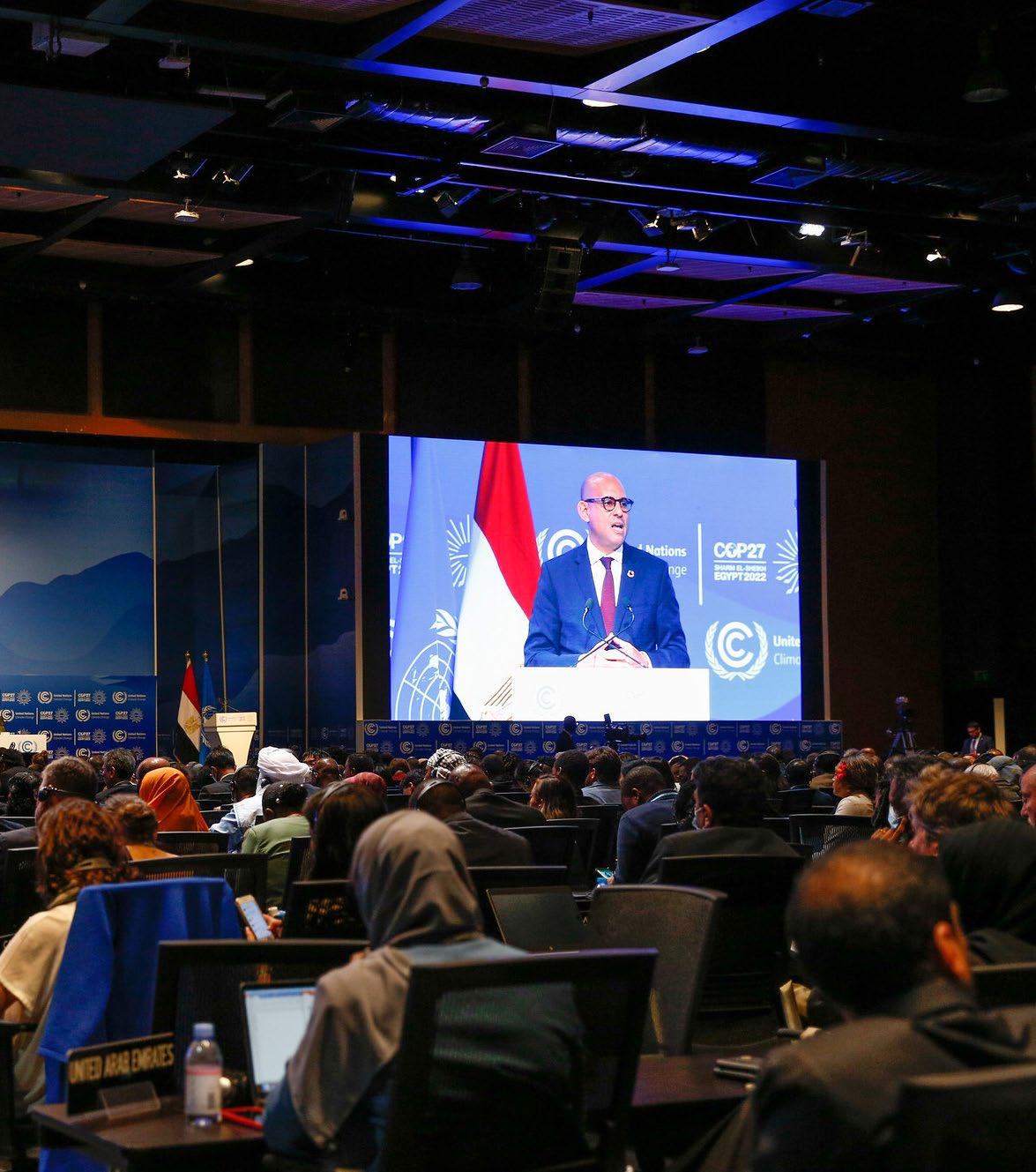

“It is time to move on
from
negotiations and vows to a stage where execution is a priority.”Sameh Shoukry, COP27 President
In his opening speech, COP 27 President Sameh Shoukry expressed his gratitude to the participants for choosing Egypt to host the event. Sharing that Egypt will make every effort to encourage the success of the events.
He highlighted what he believes are necessary actions to produce successful outcomes, “It is time to move on from negotiations and vows to a stage where execution is a priority. The bar of ambition for every country should also be raised on a par with their capabilities. I applaud every country that updated its nationally determined contributions, including Egypt. I hereby, representing all of you, urge all states to follow suit, especially since a recent evaluation of contributions indicated that they are not commensurate with the goals of [the Paris Agreement].”
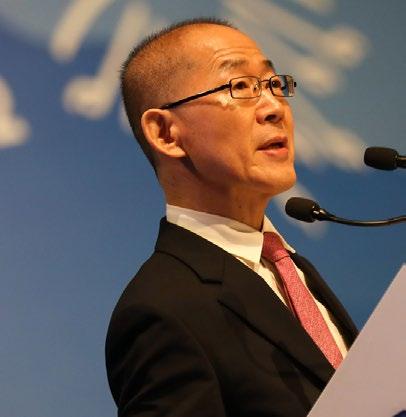
Chair of the Intergovernmental Panel on Climate Change (IPCC), Dr. Hoesung Lee, reiterated Sunday that financial inflows are insignificant compared to current climate dangers. He shared that the world is not on track to limit global warming to 1.5°C and that, according to the 2022 IPCC report, we have access to the technology and know-how to tackle climate change but are limited by the availability of financing models. Dr. Lee highlighted the severity of the issues, “With increasing warming, losses and damages will increase, and other human and natural systems will be pushed to adaptation limits. Therefore, ambitious mitigation to keep global warming within limits is a prerequisite to a successful adaptation.”
For the first time since the adoption of the UN climate convention, loss and damage arenow on the provisional agenda; with member parties agreeing that “matters relating to funding arrangements responding to loss and damage associated with the adverse effects of climate change, including a focus on addressing loss and damage,” was to be included.
The World Meteorological Organization launched its provisional ‘Global State of the Climate’ report for 2022; the final report will be published in April 2023. The annual report gives a comprehensive view of the current state of climate globally with regard to factors, such as key climate indicators, extreme events, and their consequences. Per the report, the last eight years are on track to be the eighth warmest on record due to rising greenhouse gas concentrations in the atmosphere. Extreme weather events, including heat waves, droughts, and floods, have affected millions and cost billions this year. The rate of sea level rise has doubled since 1993.

“Egypt hopes that pledges would turn into actions, after the conference, with concrete steps on the ground.”Abdel Fattah El Sisi, President of Egypt
Egyptian President Abdel Fattah El Sisi shared his anticipation for the inauguration of COP 27 activities in Sharm El Sheikh. He affirmed that: “Egypt hopes that pledges would turn into actions, after the conference, with concrete steps on the ground, thus building on the previous achievements, especially the outcomes of the Glasgow Summit and the Paris Agreement.” COP 27 President Speech

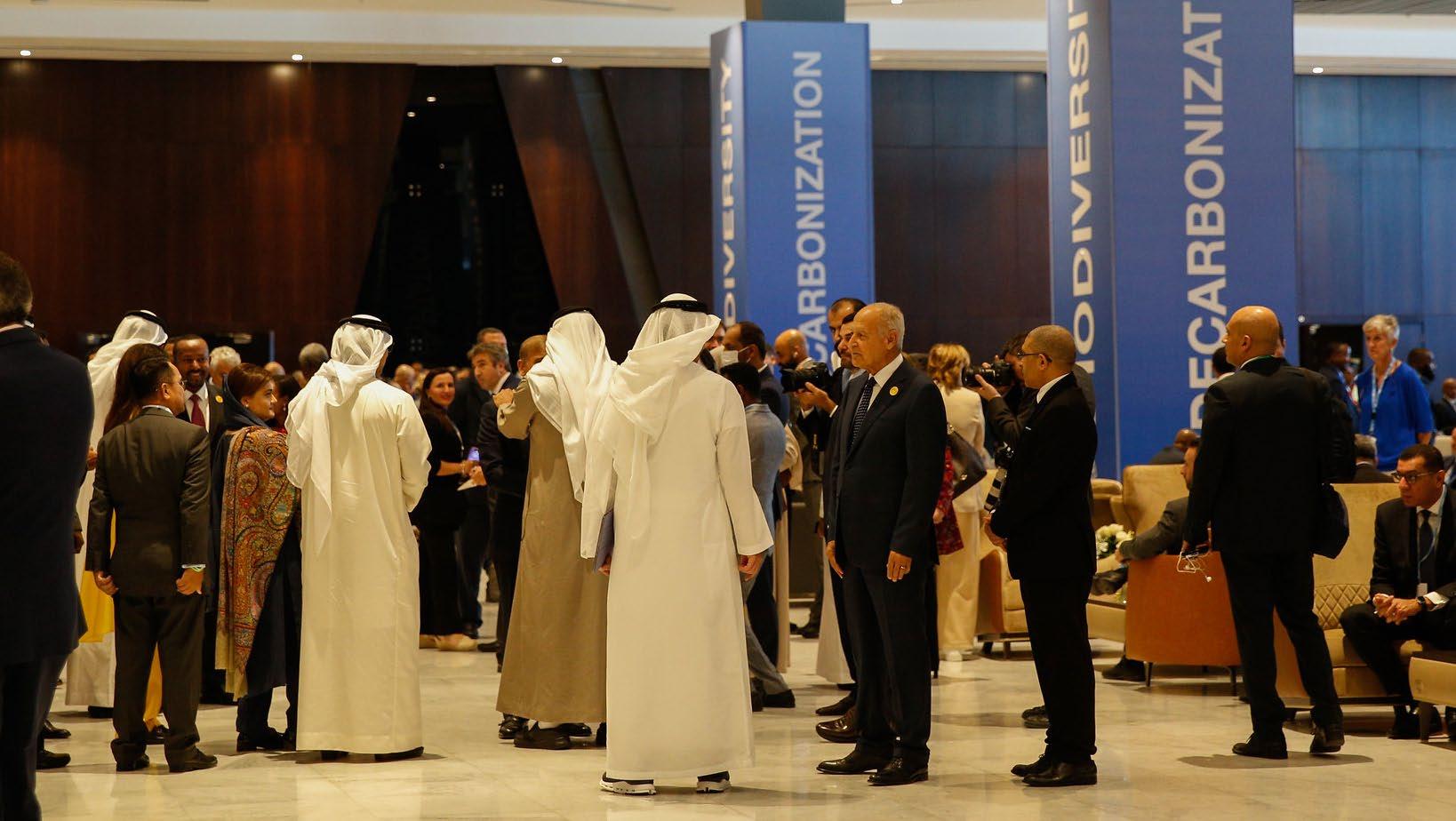
More than 100 world leaders gathered at COP27 in Sharm El-Sheikh, Egypt, to launch the Climate Implementation Summit and work toward putting existing climate agreements into practice.
President Abdel-Fattah El-Sisi of Egypt and Antonio Guterres, the UN Secretary-General, welcomed world leaders. The summit began with an inaugural plenary addressed by ElSisi, who was joined by a number of other prominent speakers, including heads of state and climate leaders,who emphasized the need for quick response to combat climate change.
The speech started with welcoming the world leaders and was followed by addressing crucial questions in regard to one of the most global pressing issues. Are we today closer to achieving our target? Have we been able to assume our responsibilities as world leaders toward the most serious issues of the century? And most importantly, does what we aspire to achieve fall under the scope of “Possible”?
The president highlighted that we are not here to answer these questions, but for taking more serious actions. That’s why Egypt was keen on calling the conference to be “The Implementation Summit”.
As the end of the decade is soon, the Egyptian president emphasized that world leaders need to have quick responses. Thus, the resilience of the attended negotiators is required to have solid outcomes at this conference.
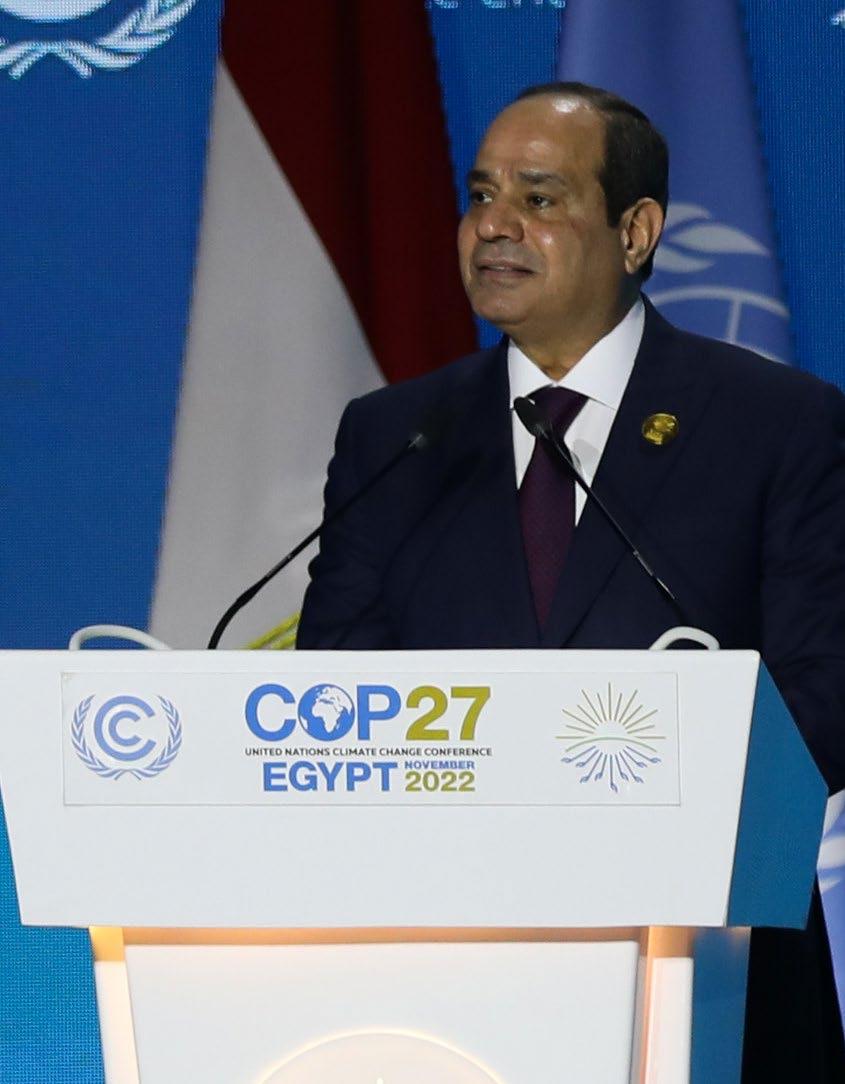
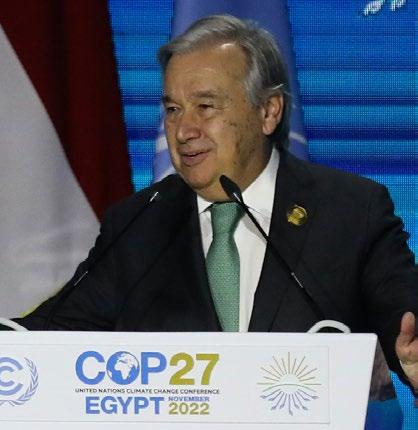
“Greenhouse gas emissions keep growing. Global temperatures keep rising. And our planet is fast approaching tipping points that will make climate chaosirreversible...”
AntónioGuterres, UN Secretary General
UN Secretary General António Guterres highlighted his intro by stating that “We are in the fight of our lives, and we are losing. Greenhouse gas emissions keep growing. Global temperatures keep rising. And our planet is fast approaching tipping points that will make climate chaos irreversible. We are on a highway to climate hell with our foot still on the accelerator.”
Guterres emphasized the role of developed countries leading in this decade. “This COP must agree on a clear, time-bound roadmap reflective of the scale and urgency of the challenge. This roadmap must deliver effective institutional arrangements for financing and getting concrete results on “loss and damage” is a litmus test of the commitment of the governments to the success of COP27”, he said outlining that Adaptation needs are set to grow to more than $300 billion dollars a year by 2030.
António Guterres highlighted that the road with financial and technological tools is clear, and that the only need is the unity of nations for implementation. He also mentioned that the war in Ukraine, and other conflicts, have caused so much bloodshed and violence and have had dramatic impacts all over the world. Nations must work together to reach peace. His talk ended by emphasizing that the global climate fight will be won or lost in this crucial decade – on our watch.

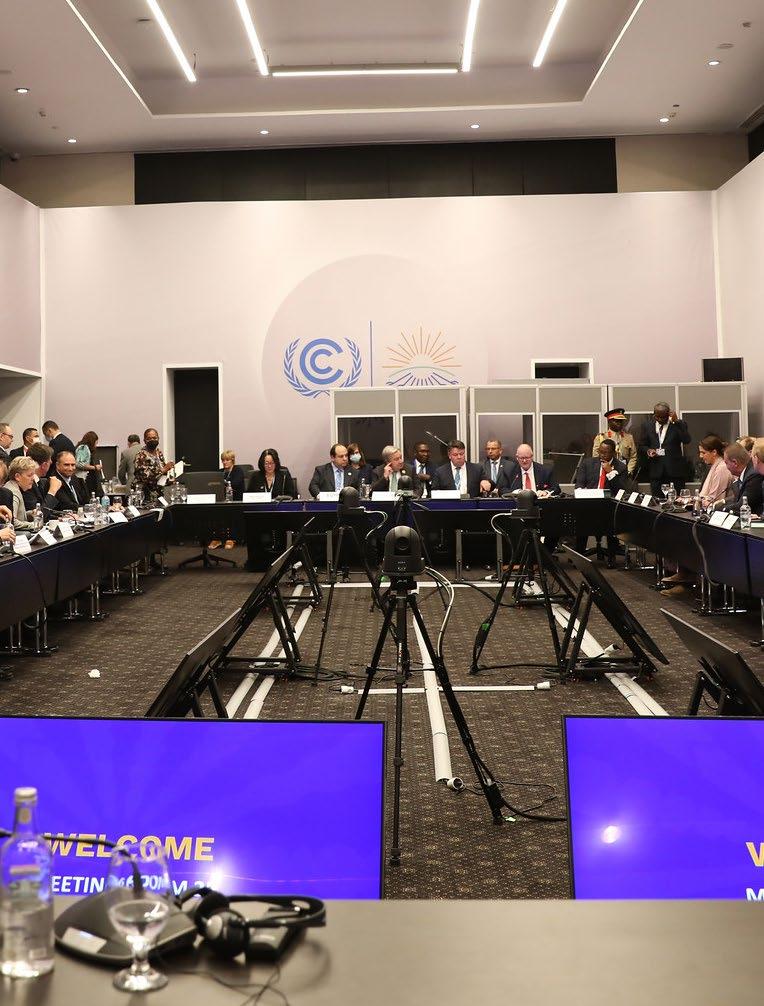
Following the opening plenary, there were three roundtable sessions with world leaders to discuss a range of pertinent climate change issues including Just Transition, Food Security, and Innovative Finance for Climate and Development.
The Just Transition Roundtable was geared toward fostering dialogue between developing nations, contributing countries, UN entities, financial institutions, the private sector, and philanthropies.
The Food Security Roundtable targeted the initiation of a platform for countries with different national contexts and priorities to identify ways of coming together to collectively tackle the present and future of food security worldwide. Developed countries could share views on how to encourage more balanced diets and minimize emissions per calorie, delivering successes in enhancing agriculture resilience, and reducing food losses. Developing countries that are suffering the most discussed the needed support for scaling resilient agriculture projects and enhancing livelihoods (e.g., regenerative agriculture). Relevant International organizations could pinpoint ways to unlock more funds for resilience projects in developing countries, with a contribution from financial institutions and the private sector on the technical solutions to do so.
The Innovative Finance Roundtable gathered representatives from contributing countries and recipient countries, together with International Financial Institutions, MDBs, and actors from the private sector. Developed countries have elaborated on the barriers hindering the acceleration of investment into climate action (e.g., the need for more investment-ready projects presented by recipient countries). Developing countries discussed various challenges related to obtaining financing for climate projects (e.g., the difficulty of identifying bankable projects without knowing whether financing will be accessible, and complex granting procedures…), and showcased some success stories on reducing the cost of green financing.
Prime Minister Mostafa Madbouly inaugurated the Green Zone, in the presence of Dr. Yasmine, Minister of Environment, Ministerial Coordinator and Envoy of the Climate Summit, and Mr. Sameh Shoukry, COP 27 president, and in the presence of a group of government ministers.

The Executive Action Plan for the “Early Warnings for All” initiative calls for initial new targeted investments of $ 3.1 billion between 2023 and 2027, equivalent to a cost of just 50 cents per person per year. UN Secretary Guterres announced the plan at the COP27 climate change conference, underway in Sharm El-Sheikh, Egypt, during a meeting of government and UN leaders, financing agencies, ‘Big Tech’ companies, and the private sector.
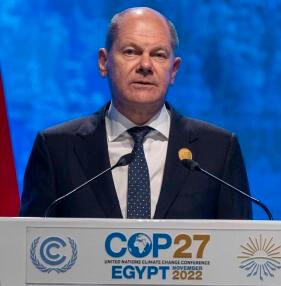
“We will stop using fossil fuels, no ifs or buts! There must not be a global renaissance of fossil fuels.”Olaf Scholz, German Chancellor
UN Secretary General António Guterres highlighted his intro by stating that “We are in the fight of our lives, and we are losing. Greenhouse gas emissions keep growing. Global temperatures keep rising. And our planet is fast approaching tipping points that will make climate chaos irreversible. We are on a highway to climate hell with our foot still on the accelerator.”
Guterres emphasized the role of developed countries leading in this decade. “This COP must agree on a clear, time-bound roadmap reflective of the scale and urgency of the challenge. This roadmap must deliver effective institutional arrangements for financing and getting concrete results on “loss and damage” is a litmus test of the commitment of the governments to the success of COP27”, he said outlining that Adaptation needs are set to grow to more than $300 billion dollars a year by 2030.
António Guterres highlighted that the road with financial and technological tools is clear, and that the only need is the unity of nations for implementation. He also mentioned that the war in Ukraine, and other conflicts, have caused so much bloodshed and violence and have had dramatic impacts all over the world. Nations must work together to reach peace. His talk ended by emphasizing that the global climate fight will be won or lost in this crucial decade – on our watch.
“We will stop using fossil fuels, no ifs or buts! There must not be a global renaissance of fossil fuels,” he said, though Germany has asked energy firms to delay the closure of coal plants as the Ukraine war disrupted energy supplies.
“Resolute deeds must follow our resolute promises towards climate protection,” he said. Meanwhile, Italy’s new prime minister Giorgia Meloni said that Italy remained “strongly committed” to pursuing its decarbonization pathway in line with the Paris Agreement.
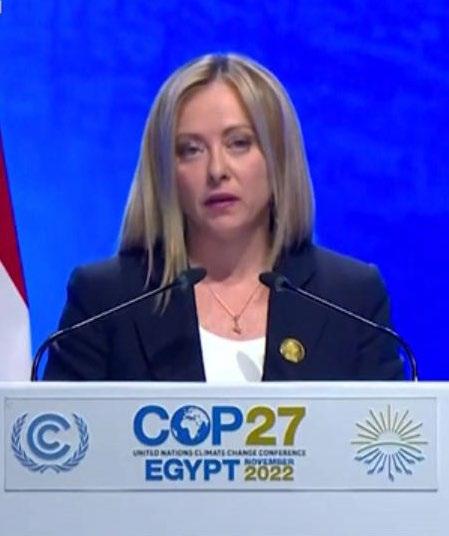
“We intend to pursue a just transition to support the affected communities and leave no one behind”.
Giorgia Meloni, Italy Prime Minister
In response to the devastating impacts of climate change affecting vulnerable people worldwide, COP27 Presidency launched the Sharm-El-Sheikh Adaptation Agenda in partnership with the High-Level Champions and the Marrakech Partnership.
COP27 President Sameh Shoukry announced the Sharm El Sheik Adaptation Agenda to enhance resilience for 4 billion people living in the most climate-vulnerable communities by 2030. The Adaptation Agenda is the first comprehensive global plan to rally both States and non-State actors behind a shared set of 30 Adaptation Outcomes that are required by the end of this decade across five impact systems: food and agriculture, water and nature, coastal and oceans, human settlements and infrastructure, and including enablingsolutions for planning and finance.
In his comments, Dr. Mahmoud Mohieldin the UN Climate Change High-Level Champion for COP27 stated:
“The Outcomes were identified jointly with a broad range of active stakeholders, reflecting existing and new global targets based on science and local knowledge and initiatives. The Outcome targets will continue to be refined and expanded by the High-Level Champions with inputs from State and non-State actors to support their operationalization. At the core of the Outcomes is the recognition that adaptation is often locally driven and globally relevant while simultaneously needing to address equity, diversity, and justice. This agenda will accelerate the Race to Resilience’s global goal of making 4 billion vulnerable people more resilient by 2030”

“The Sharm el-Sheikh Adaptation Agenda firmly puts fundamental human needs at its core, along with concrete, specific action on the ground to build resilience to climate change. The Adaptation Agenda outlines multiple actions and combines the commitments of governments and nonParty stakeholders into a joint vision and plan. As the growing number of global climate emergencies clearly shows, focusing on adaptation is crucial.
We need all stakeholders on board to deal with climate change’s current and future impacts, and this is a prime example of how that can happen”.

The High-Level Champions published their Yearbook of Global Climate Action 2022. Itoutlines what is needed to accelerate sectoral systems transformation, features case studies of real-world climate action projects, highlights some critical global climate action topics – particularly regionalization and accountability – and presents the UN Climate Change HighLevel Champions’ contribution to these issues. It also highlights what needs to be achieved in 2023, particularly with regard to the Global Stocktake and the work being done on implementing the improved Marrakech Partnership.
Action by businesses, investors, cities, states, regions, and civil societies continues to increase, with 34 Race to Resilience partners from 139 countries taking action to build the resilience of 2.9 billion people, while 26 Race to Zero partners have mobilized more than 11,000 non-State actors. The Global Climate Action Portal, recording a jump of 78% in actors from Asia-Pacific and 67% from Africa, is evidence that climate action is becoming better distributed across the globe.
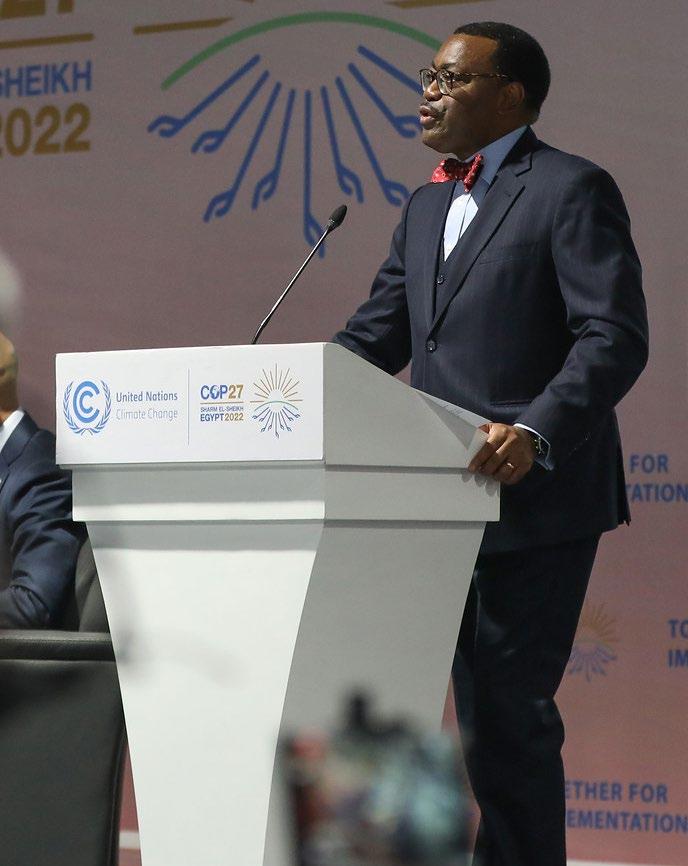
President Abdel Fattah Al-Sisi and Norway Prime Minister Jonas Gahr Støre announced the launch of Phase One of the First Green Hydrogen Plant in the Suez Canal Economic Zone (SCZone), on the sidelines of COP27.During the event, President Sisi said that the green transformation represents a promising opportunity to achieve development in all fields. He added that Egypt is moving forward toward being an energy bridge between Africa and Europe, pointing out that Egypt is keen to overcome any investment obstacles, especially in the green transformation sectors.
Al-Sisi further added that the giant project to produce green hydrogen is located in the economic zone of the Suez Canal, to facilitate the export to Europe and other continents. He also highlighted that green hydrogen has the potential to play a significant role in decarbonizing hard-to-abate sectors, such as heavy industries, power, and global shipping, and to provide affordable, accessible, and sustainable energy security for future generations.

ACMI announced a bold ambition for the continent—to reach 300 million credits produced annually by 2030. This production level would unlock 6 billion in income and support 30 million jobs. By 2050, ACMI is targeting over 1.5 billion credits produced annually in Africa, leveraging over $120 billion and supporting over 110 million jobs.
Commenting on ACMI’s ambition, Damilola Ogunbiyi, the CEO of SEforALL and a member of the ACMI’s steering committee, said, “The current scale of financing available for Africa’s energy transition is nowhere close to what is required. Achieving Africa Carbon Markets Initiative targets will provide much-needed financing that will be transformative for the continent.”
ACMI aims to expand Africa’s participation in voluntary carbon markets by setting an ambition for the continent and developing a roadmap of action programs that will be implemented over the next few years to meet that ambition. The UN Climate Change High-Level Champions are supporting partners in this initiative.
Setting the scene for the Finance Day, Prime Minister Mostafa Madbouly kickstarted the Finance Day, organized by the Egyptian Ministry of Finance in the COP27 Blue Zone by highlighting that cooperation between governments, civil society, the UN, and international organizations is the shortest way to ensuring success in combating climate change.
Later on, Prime Minister Mostafa Madbouly and the Green Climate Fund (GCF) launched Egypt’s Climate Investment Plan to accelerate the country’s climate action through investment planning. The strategy is a twin scheme meant to support a stronger and greener economy with an eye on renewable energy, transportation, agriculture, and water resources.
President of the World Bank David Malpass, IMF Managing Director Kristalina Georgieva, President of the European Bank for Reconstruction and Development (EBRD) Odile Renaud-Basso, Executive Director of the GCF Yannick Glemarec and other high-level officials attended the side event.
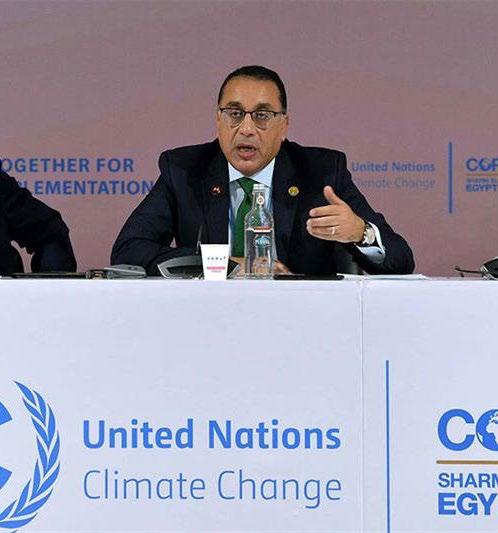
President El-Sisi and Belgian Prime Minister Alexander De Croo jointly launched a global renewable hydrogen forum during a high-level roundtable on “Investing in the Future of Energy: Green Hydrogen”, held on the sidelines of COP27.
“The forum aims to facilitate the production and use of renewable hydrogen to reduce carbon emissions, accelerating a just transition to renewable energy”, El-Sisi said during the launch. “The forum also seeks todetermine the best tools for contributing to boosting the trade of green hydrogen between developing countries rich in renewable energy and developed countries”, the president added.
The dialogue’s main objective is to coordinate policies and procedures and create paths for trade and investment in hydrogen, thus contributing to accelerating the pace of the just transition we aspire to have.
Prime Minister Mostafa Madbouly launched the voluntary carbon markets platform at COP27’s Egyptian pavilion. The platform was launched with the participation of the Egyptian Exchange Stock. The launch ceremony was attended by Planning Minister Hala Saeed, Environment Minister Yasmine Fouad, and Board Chairman of the Financial Regulatory Authority Mohamed Farid. Minister Fouad underlined the importance of the event, which she said will offer greater chances for the private sector to commit to confronting climate change within the framework of the updated
national contribution plan. The market, which was launched during the COP27 climate summit hosted in Egypt, would boost “financing African climate projects to achieve net zero”, the exchange said.
$2.24B
The Ministry of International Cooperation announced the signing of $2.24 billion in concessional development funding. The ministry stated that this came in the light of multilateral cooperation efforts to support the State’s development vision to implement a number of development projects and develop sustainable infrastructure that stimulate private sector participation with a number of development partners in transport, housing, electricity, renewable energy, food security and the environment in the Egyptian pavilion of the COP27 Climate Conference.
The report highlights that an ongoing commitment to climate action can transform these risks into opportunities and help Egypt to achieve its climate and development goals together. The report identifies policy actions and investment opportunities that, if implemented within five years, could make the use and allocation of natural resources more efficient, reduce the impacts of climate change on people and businesses,and enhance Egypt’s competitiveness in global markets.
“Our CCDRs are shifting the discussion from distant impacts into immediate and actionable recommendations for decision makers today. The recommendations in this report are designed to build the foundation for a low-carbon growth model for Egypt with greater competitiveness in the global scene and reduced vulnerabilities of the people and the economy to climate shocks,” said David Malpass, World Bank Group President.


President Biden pledged that the United States would do its part to avert a “climate hell.” President Biden attempted to assure that the United States is dedicated to addressing the issue. Still, impoverished nations resisted the sizeable U.S. delegation in attendance and demanded that the world’s wealthiest nations pay more to assist.
[1] During his speech, Biden apologized for the U.S. withdrawal from the Paris Climate Accord under former President Donald Trump.
A deal to support Egypt’s transition to renewable energy was one of the highlights of the U.S. president’s day trip to Sharm
Elsheikh, which was intended to “showcase” American leadership on the issue of climate change. Along with other actions, the U.S. recently unveiled new methane regulations to crack down on “super emitters”.[3] In his speech, President Biden highlighted the Inflation Reduction Act, one of several domestic climate efforts, a significant tax and climate legislation that allocates $369 billion to renewable energy programs.[4] Biden assured that good climate policy is good economic policy and that the United States of America will meet its emissions targets by 2030 since the U.S. has pledged to cut its greenhouse gas emissions between 50 and 52% by 2030.
Negotiations, sharing solutions to curb emissions by the world’s biggest-polluting industries,and continued calls for climate justice and finance for hard-hit developing countries werein the spotlight on Friday.
“To meet the Paris Agreement’s goals and prevent the climate crisis’s worst impacts, the world must abandon fossil fuels as quickly as possible, Selwin Hart, Special Adviser to the Secretary-General on Climate Action, told U.N. News today”.

Participants representing Africa at the COP27 called on those who cause GHG emissionsand the problems that led to climate change to bear the bill for this matter. In a session entitled “Protecting People on the move in the Midst of the Climate crisis”, keynote speaker Namira Negm, Director of the African Migration Observatory in Morocco, said: “Here in COP27, we must not deviate from this goal,” and “We hope to see the human face and the suffering of peoples due to climate change on the agenda of the summit”. Addressing those she considered responsible for this suffering, she believes they must bear the resulting burdens, and pay the bill for their actions to achieve development.
“We have to listen to those most affected by the climate crises”, U.S. House Speaker Nancy Pelosi said Friday during a press conference on the sidelines of her participation in COP27.
She added that President Joe Biden assured that when the U.S. starts working on climate change issues, the U.S. must do it correctly and listen to the most affected, such as vulnerable countries or vulnerable people”. “60 billion dollars have been earmarked to diversify the economic landscape and improve inclusion. In addition, there is also legislation for extra investment in the domains of education, research, and work on inclusion”, she noted.
This year, the U.S. House of Representatives has budgeted more than $3 billion to assist activities in the field of climate change, and she emphasized that the United States will continue to follow all its international obligations to fight climate change.
Speakers at a session on “The Decarbonization Challenge” underscored the importance of investing in the decarbonization of the highest emitting sectors and identifying new technologies to streamline the process further.
The session included Egyptian Minister of Petroleum and Mineral Resources Tarek El- Molla, US Special Presidential Envoy for the Climate John Kerry and the Head of Programs of Third World Network Meena Raman.
Egypt’s COP27 Presidency and the Food and Agriculture Organization (FAO) launched the Food and Agriculture for Sustainable Transformation or FAST, at COP27 today. The new initiative will increase climate finance contributions for agriculture and food systems to support the most vulnerable communities.
FAST will reimagine agrifood systems to deliver triple wins for people, climate action, and nature. It will be supported by countries through its multi-stakeholder partnerships that will ensure food systems are reinforced through climate policies that contribute to concrete actions in support of adaptation and maintain a 1.5-degree pathway for food and economic security. FAST will focus on three priorities for action:
Access to Finance:
Enhancing countries’ capacities to identify and increase access to climate finance and investment.
Knowledge and Capacity:
Providing the necessary analyses, developing voluntary guidelines, and supporting capacity development
Policy Support and Dialogue:
Ensuring agrifood systems are fully embedded in climate change policies, such as Nationally Determined Contributions (NDC), National Adaptation Plans (NAP), or Long-term Low Emissions and Development Strategies (LT-LEDS).
Ad-hoc technical advisory groups for ensuring responsiveness and efficiency, and for the timely delivery ofmutually agreed high-quality outputs.
Relevant to the topic
COP27 President Sameh Shoukry stated, “The impact of climate change is disproportionately impacting vulnerable communities around the world. To address this imbalance, we need to develop sustainable farming and food systems and meet the urgent needs of food-importing developing countries. Through the FAST initiative, we will be mobilizing the world to unlock finance flows to increase climate resilience and implement urgently needed transformation across agrifood systems.”
Deputy Director General FAO Maria Helena Semedo commented that, “Bold transformative actions are needed to boost Agrifood system transformation, support countries, and ensure that resources reach food producers across the value chain”.
Minister of State, Department for Food, Rural Affairs and Environment, United Kingdom, Lord Benyon said, “The challenges we continue to face are vast. The only way we can overcome them is through collaboration and innovation. We are committed to taking this forward: through the Policy Dialogue, Agriculture Breakthrough, and in collaboration with the new FAST initiative. We fully support the FAST initiative, spotlighting access to finance, capacity strengthening, and policy dialogue. I’m sure that it will bring a major push on food and agricultural transformation”.
The FAO, in collaboration with other UN agencies, will play the role of a neutral facilitator, providing objectivity, independence, and credibility that are prerequisites for the success of the initiative. A set of guiding principles for implementation aims to ensure the effective delivery of agreed outputs, with initial principles identified through a series of multi-stakeholder consultations and in partnership with the COP27 Presidency High- Level Champions under the Marrakech Partnership.
The UAE has laid out a pathway to achieving net zero greenhouse gas (GHG) emissions by 2050 that implies an even deeper reduction in emissions by 2030 than envisaged under the updated Nationally Determined Contribution (NDC) released in September. Theupdate envisioned a 31pc reduction in the country’s GHG emissions by 2030, versus a 2016 baseline, up from a targeted 23pc cut in the country’s original NDC.
In volume terms, this would have involved a reduction in emissions of 93.3 MM tons of carbon dioxide equivalent (CO2e) to 207.7 MM tons of CO2e versus the UAE’s “business as usual” forecast, which anticipated emissions of 301MM tons of CO2e in 2030 assuming a “moderate annual economic growth rate based on historical trends.”
Based on the new net zero roadmaps presented at the Cop 27, the UAE Climate Change and Environment Ministry stated that the UAE is aiming to reduce emissions by 49pc by 2030 and by 60pc by 2040. Moreover, these targets are based on 2019 rather than a 2016 baseline and imply even lower outright emissions in 2030 of 178MM tons CO2e than under the September NDC update. The net-zero plan also foresees emissions falling to 87MM tons CO2e by 2040, before the country reaches its net-zero goal in 2050.
The UAE has previously said it plans to reach net zero emissions by boosting clean energy production from sources such as solar and green hydrogen, as well as via waste management, energy efficiency, and green mobility. The country will also look at carbon capture utilization and storage (CCUS) and small modular nuclear reactors to achieve its goals.

Women remain underrepresented in climate governance and decision-making s tructures. The Gender Thematic Day was aimed at bringing the issue to the forefront and providing a platform to look into sound policies, best practices, and effective solutions. The sessions of the day shared success stories from around the world with a view of promoting gender-sensitive and highly responsive policies, strategies, and actions.
During the opening session for the Day, the African Women’s Climate Adaptive Priorities (AWCAP) initiative was announced and launched by the President of the National Council of Women of Egypt, Dr Maya Morsy. This initiative stems from a key insight that in the wake of disasters, ~80% of women and children are in need of assistance, while poor women in rural areas are 14 times more likely to die during a natural disaster.

Women and Climate Change Finance at COP27 considered the role of women in society and business and how addressing inequalities could lead to different outcomes when it comes to climate finance, thus the need for ensuring sufficient, appropriate and accessible climate finance that is sensitive and responsive to the needs and priorities of women is required.
The European Union has long been one of climate diplomacy’s most important players. The bloc has arguably gone further than any other large emitter in actually implementing the goal of reaching climate neutrality by the middle of the century. In just the last month, it agreed on crucial bits of its landmark green deal regulation, including phasing out new combustion engines by 2035.
But at this year’s COP27 summit, the EU’s role as a climate vanguard has been complicatedby the region’s energy crisis and the need to replace Russian gas supplies as quickly as possible.
Europe’s member states have increased consumption of coal, the most harmful fossil fuel, and sought new gas supply contracts in the US, the Middle East and Africa, raising concern that it will lock-in fossil fuel production for decades to come. When German Chancellor Olaf Scholz arrived in Sharm el-Sheikh last week, campaigners accused him of “energy colonialism” after looking for gas from Senegal.
Ursula von der Leyen, Commission President, told delegates in Sharm el-Sheikh last weekthat “The global fossil fuel crisis must be a game changer”.
The Commission has called to boost its renewable and energy efficiency targets by the end of the decade and proposed plans to drastically cut permitting times for wind and solar, which can take as long as a decade.
The test will be whether new direction from the top filters down into Europe’s 27 member states. As this year’s COP enters its second week and the serious horse-trading to get an agreement everyone can sign, the EU delegation will feel added pressure to play a constructive role.
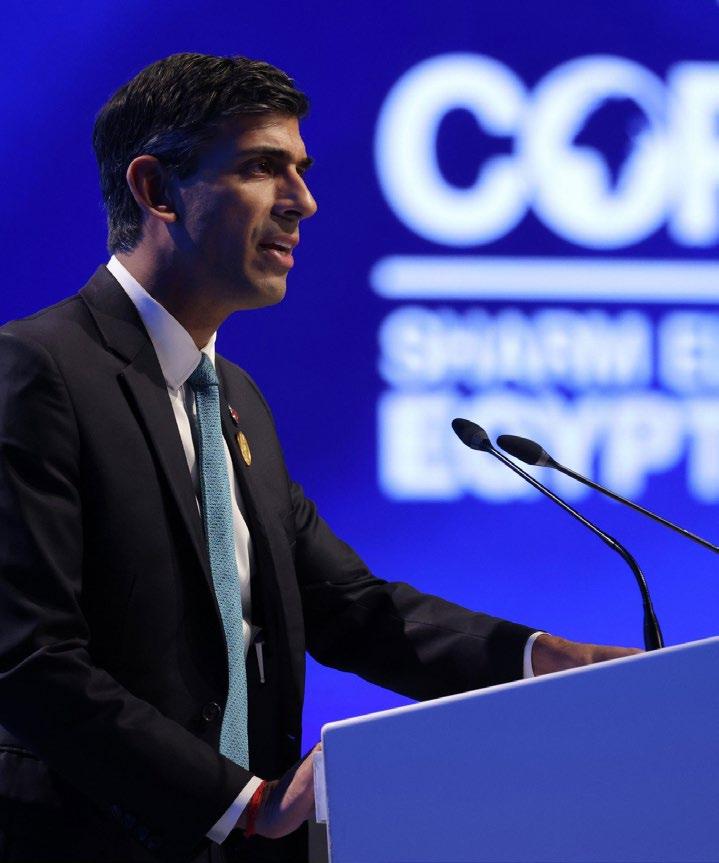
India’s push to add a call for the phase down of all fossil fuels into the agreement at COP27 gained momentum as the European Union, small island states and the UK are expected to support the move.
The coalition of some of the world’s biggest emitters — as well as the Alliance of Small Island States, some of countries hit hardest by climate change — will put pressure on the Egyptian presidency of the summit to include the language in the first draft of its cover decision, which is expected early this week. It is likely to face heavy push back from oil and gas producers as well as China. Saudi Arabia’s energy minister, Prince Abdulaziz bin Salman, said in an interview last week that the kingdom would be very unlikely to support an agreement that included the phase down of oil.
Indian negotiators led the push for a decision on phasing down all fossil fuels on Saturday. While its strategy stems largely from the coal-dependent country’s desire to not be singled out for its dependence on dirty fossil fuel, others are seeing it as an opportunity to push for more ambition.
The Presidency convened the fifth HighLevel Ministerial Dialogue on Long-Term Climate Finance on the progress and fulfillment of the goal of mobilizing jointly USD 100 billion per year by 2020, in the context of meaningful mitigation action and transparency on implementation.
This round-table dialogue follows previous dialogues at COP20, COP22, COP24, and COP26. The HLMD will be informed by the fifth Biennial Assessment and Overview of Climate Finance Flow and the report on progress towards achieving the goal of mobilizing jointly USD 100 billion per year by the Standing Committee on Finance.
Minister of Foreign Affairs and President of COP27, Sameh Shoukry, participated on Monday in the ministerial roundtable on mitigating the effects of climate change before 2030, with the participation of Simon Steel, Executive Secretary of the UN Framework Convention on Climate Change (UNFCCC), and delegations of UNFCCC member states. In this regard, Shoukry highlighted the importance of mitigating the effects of climate change, in light of the international scientific reports indicating the need to move quickly in this regard to maintain global temperatures at safe rates. In this regard, he noted the content of the IPCC report on greenhouse gas emissions, which highlights the importance of sending a message through COP27 that reflects the political will of Parties to strengthen their efforts to mitigate the effects of climate change by increasing their efforts to reduce emissions and providing clear guarantees in this regard, in a manner that contributes to the fulfillment of the provisions of the Paris Agreement.
Important progress on sustainable forest management and conservation has been made at the UN Climate Change Conference COP27 in Sharm el-Sheikh with the launch of the Forest and Climate Leaders’ Partnership (FCLP), which aims to unite action by governments, businesses and community leaders.
The Partnership aims to boost action to implement a commitment made by over 140 countries at COP26 in Glasgow last year to halt forest loss and land degradation by 2030 and to convert ambition into results on the ground. Only by stepping up efforts to reduce deforestation and implementing other mitigation activities in the forest sector can the Paris Agreement goal of limiting global average temperature rise to 1.5 degrees above pre-industrial levels be reached. Twenty-seven countries, representing over 60% of global GDP and 33% of the world’s forests, have already joined the new partnership and are committed to leading by example one or more of the FCLP’s action areas. These include mobilizing public and donor finance to support implementation, supporting Indigenous Peoples’ and local communities’ initiatives, and incentivizing the conservation of highintegrity forests.
“This alliance is an opportunity to implement solutions that reduce deforestation, that increase forest restoration and strengthen the livelihoods of people living in forest areas,” said Gustavo Manrique Miranda, Minister of the Environment and Water, Ecuador. The renewed political and financial commitment towards forest climate action shown at COP27 is creating new momentum for REDD+. REDD+ provides a holistic framework for forest climate action, including providing results-based payments for emission reductions achieved in the forestry sector.
Two weeks of transparency events kicked off at COP27 in Egypt last week under the banner “Together4Transparency”. With discussions ranging from the need for reliable greenhouse gas emissions estimates accessible to all to the role, that information plays in reducing risks and uncertainties in order to attract financial support for action, the series of events address the full range of actors and issues related to transparency. “Together4Transparency” aims to unite stakeholders involved in supporting the transition toward the Enhanced Transparency Framework of the Paris Agreement.
“But to ensure that, we need to have reliable climate data and information. The reporting, review and consideration of this climate data and information is referred to as ‘transparency’. Without it, we are left to act blindly, without knowledge of our circumstances and our impacts. This is why transparency is at the very core of the Paris Agreement, and everything we do here”, said Sarmad.
Global Climate Ambassador and CEO of the Caribbean Climate Smart Accelerator Racquel Moses defined transparency as “a carrot, not a stick”. In her view, transparency challenges climate actors to do more, to do better, and in identifying leaders, it helps us all to all learn from those who are blazing the trail. In this way, Moses says transparency is both a “tool and an opportunity, citing examples of how transparent data have helped to guide Jamaica’s energy sector transformation, Barbados’s adoption of solar water heaters, and Bermuda’s advances in water security.
Government ministers attending the roundtable delivered a collective call to urgently ramp up ambition across the board, with many developing countries stressing the need for support and sustained financial flows. Most ministers agreed the 1.5°C temperature limit is a “red line” that cannot be crossed.
Mr. Stiell called for an ambitious mitigation work program that would reduce emissions faster, catalyze impactful action, and secure assurances from key countries that they have to take immediate action to raise ambition and keep us on the path towards 1.5°C.
Dr. Jim Skea, the IPCC’s Working Group III Co-Chair, added a sense of hope to the roundtable discussions by illustrating the availability of solutions in all sectors that can be deployed immediately to close the gap by 2030.
According to the IPCC, the available mitigation solutions have the potential to halve emissions from 2019 levels by 2030 and cost less than USD 100 per ton of carbon dioxide equivalent. Marking the vast potential in the energy sector, for example, Dr. Skea pointed out that the costs of wind and solar solutions have dropped dramatically in recent years. He also highlighted the huge potential of emission reductions in agriculture, land use, and forestry, including better soil management and ecosystem restoration. “We know how to do this, it’s as if we’ve laid out all our tools on the tool bench but have yet to pick them up,” said Dr. Skea.
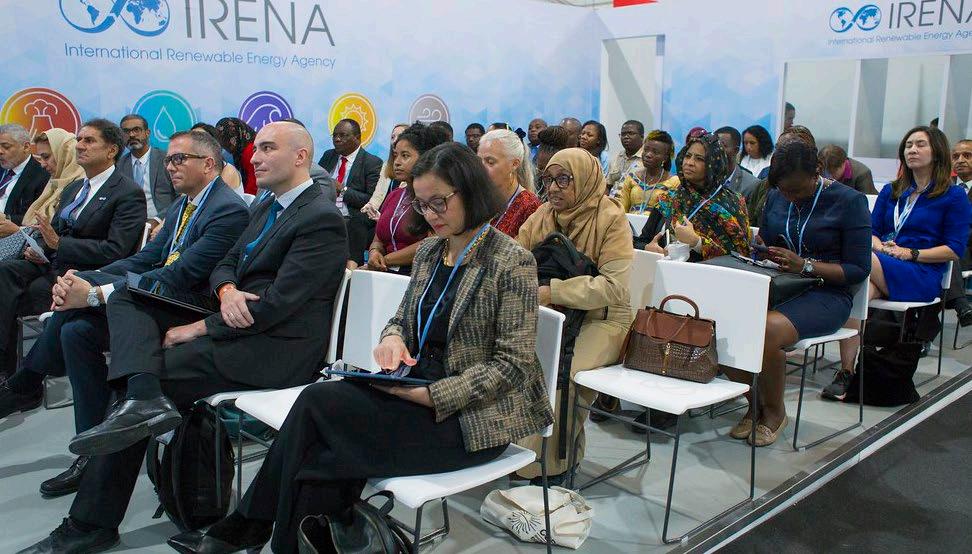
IRENA’s global finance platform ETAF just recently managed to close in on USD 1 billion to advance project funding in developing markets. IRENA is also closely working with the Egyptian COP27 Presidency. Under the Marrakech Partnership, IRENA is coordinating the Energy Action Day with partners from countries, regions, cities, and companies. It is encouraging to see that net zero commitments are steadily growing, inside and outside the NDC process and beyond the 2030 time horizon. Surveys show that 35% of the 2,000 largest publicly traded companies globally have or are considering a net zero target.
Announcing a total of $105.6 million in new funding, Denmark, Finland, Germany, Ireland, Slovenia, Sweden, Switzerland, and the Walloon Region of Belgium, stressed the need for even more support for the Global Environment Facility funds targeting the immediate climate adaptation needs of low-lying and low-income states. The GEF programming strategy for the next four years anticipates that the LDCF will provide between $1 billion and $1.3 billion for Least Developed Countries and that the SCCF will provide between $200 million to $400 million for Small Island Developing States and other climate-vulnerable developing states. Global Environment Facility (GEF) announced the allocation of 70.6 million USD to the Least Developed Countries Fund (LDCF) and 35.0 million USD to the Special Climate Change Fund (SCCF). Additional countries expressed their strong political support to the two funds, with several in the process of securing resources.
The COP27 Presidency initiative to present pathways for an Africa Just and Affordable Energy Transition Initiative (AJAETI) was launched at Energy Day. The initiative focuses on solutions to help Africa overcome the energy transition dilemma by identifying risks, and opportunities, and empower the critical enablers that are required to succeed. Commenting on Energy Day, COP27
President Mr. Shoukry said: “Energy is one of the most carbon-intensive sectors in any given economy, making it one of the most important areas to effect meaningful mitigation measures that contribute to addressing climate change and transitioning to a green economy for the future.
Science is clear: global emissions need to be reduced by half by 2030, reaching netzero by 2050. To achieve this, we need to invest in new sources of energy that are clean, affordable, accessible, sustainable, and reliable”. The COP27 Presidency launched the Africa Just & Affordable Energy Transition Initiative (AJAETI) during the opening session of COP27’s Energy thematic day. AJAETI aims to focus on three key objectives:
1. Consolidate and facilitate technical and policy support that will make just and affordable energy transitions in all African countries financially viable, securing access to affordable energy by 2027 for at least 300 million Africans, and contributing to SDG 7.1 target of universal access by 2030.
2. Transition 300 million out of the 970 million, who do not have access to clean cooking fuels and technologies, towards clean cooking by 2027, contributing to the SDG 7.1 target of universal access by 2030.
3. Transition towards green energy by increasing the share of renewable electricity generation by 25 percentage points by 2027 and obtaining a power sector based on renewables by 2063, in line with the “Africa We Want” agenda.
The two bodies of the Technology Mechanism under the UNFCCC and Paris Agreement; the Technology Executive Committee (TEC) and Climate Technology Centre and Network (CTCN), launched their joint work program to accelerate the deployment of transformative climate technologies that are urgently required to tackle climate change. The United States announced today a contribution of USD 3 million to support the implementation of theJoint Work Programme.
The European Commission declared that it would continue its support by providing anew EUR 2 million contribution to the Climate and Technology Centre and Network.”. Parliamentary State Secretary at the Federal Ministry for Economic Affairs and Climate Action Stefan Wenzel underlined Germany’s support and announced a voluntary contribution of EUR 1.5 million to CTCN and EUR 500,000 to TEC in 2022. In addition, the Canadian government has confirmed a CAD 6 million grant to the CTCN.
The representing team of China at CoP 27 summit declared that China’s plan to add its world-leading fleet of coal power plants is a short-term Band-Aid to address energy security concerns and doesn’t represent a shift in emissions policies.
The US will make announcements on howit will assist African nations in setting upearly-warning weather systems at the COP27 climate summit in Egypt in November, the country’s special presidential envoy for climate, John Kerry, said. The funding will come through the President’s Emergency Plan for Adaptation and Resilience, or PREPARE, launched by Joe Biden, the US president, atCOP26 in Glasgow last year, Kerry said.

The president of COP27 is optimistic that a deal on loss and damage can be reached thisweek, despite disagreements over who should pay for destruction caused by climate change. Mr. Shoukry said “I certainly will work to reach that landing zone” in a way that’s satisfactory.
Almost a year after the initial launch of the Global Methane Pledge at COP26. The meeting highlighted the crucial efforts needed to address methane emissions. The Global Methane Pledge Energy Pathway provides an important platform for countries that have signed up to the pledge to share experiences and best practices, showcase commitments, and benefit from enhanced access to finance and technical support through bilateral and multilateral arrangements.

The initiative was led by Egypt’s Ministry of Planning and Economic Development and supported by the United Nations Development Programme (UNDP). The main aim of this initiative was shaping the process of planning and designing the economic policies in a special way not only considering the impact of climate change, but also quantifying the efforts made in mitigation and adaptation, identifying the gaps and support needed, and proposing a set of essential guidelines, criteria, and policy advice, to expedite the implementation of the UNFCCC, Paris Agreement and the NDCs. During the meeting, discussions regarding the need to re-define economic policies around factors that impact climate change, mitigation, and adaptation toke place.
Pakistan’s Minister of Planning, Development and Special Initiatives Ahsan Iqbal stated that promoting green investment in Pakistan was a top priority of the government to tackle the growing environmental issues. He stated that Pakistan was contributing with less than 1% to global warming but still, it was among the top seven countries which were vulnerable to climate change risks. This took place during the panel discussion at the launching of “Friends of Greening National Investment Plans in Africa and Developing Countries Initiative” on “Solutions Day” hosted by Minister for Planning and Economic Development Egypt Hala El-Said on the margins of COP27 Climate Conference in Sharm El-Sheikh. The minister said the government was taking steps to promote various sources of renewable energy including solar energy and it would discourage the use of fossil fuels for electricity production.

Climate negotiators are on track to reject a proposal for a more sweeping plan to phase down fossil fuels, snuffing efforts by India and key developed nations to target oil and gas as well as coal in an overarching deal at COP27. The Egyptian presidency published the first draft of its so-called “cover decision” and largely kept last year’s pledge made at Glasgow to “accelerate measures towards the phase down of unabated coal power” and phase out fossil fuel subsidies.
The draft, which is still subject to revision during the rest of the week, will come as a disappointment for countries who want a phase down of all fossil fuels, not just coal. India led the push, but received backing from the US, European Union and the UK.

The Draft emphasizes the urgent need for Parties to reduce global greenhouse gas emissions immediately, deeply, rapidly, and sustainably across all sectors, particularly through increased renewable energy, equitable energy transition partnerships, andother cooperative initiatives.
In addition, the draft recognizes that the unprecedented global energy crisis highlights the need for quick changes to energy systems to make them more dependable, secure, and resilient during this crucial decade of action. It also emphasizes the importance ofincreasing the proportion of renewable energy in the energy mix at all levels as part of diversifying energy mixes and systems, in keeping with national conditions and recognizing the need for support towards equitable transitions.
In order to keep global warming to 1.5 °C, greenhouse gas emissions must be rapidly, significantly, and sustainably reduced.
According to the Draft, net global emissions must drop by 43% by 2030 compared to levels in 2019. The Parties recognize that this calls for expedited action that is based on equity and best scientific knowledge, reflecting respective capabilities and common but differentiated responsibilities in light of various national circumstances, as well as efforts to eradicate poverty and promote sustainable development.
Countries note with grave concern the finding in the most recent synthesis report on nationally determined contributions that, taking into account implementation of all most recent nationally determined contributions, the total global greenhouse gas emission level in 2030 is estimated to be 0.3% below the level in 2019, which is not consistent with least-cost scenarios for keeping global temperature rise to 2 or 1.5 °C. The Draft notes the importance of aligning nationally determined contributions with long-term low greenhouse gas emission development strategies. “Calls upon Parties to accelerate the development, deployment
and dissemination of technologies, and the adoption of policies, to transition towards low-emission energy systems, including by rapidly scaling up the deployment of clean power generation and energy efficiency measures, including accelerating efforts towards the phasedown of unabated coal power and phase-out of inefficient fossil fuel subsidies, while providing targeted support to the poorest and most vulnerable in line with national circumstances and recognizing the need for support towards a just transition”.
Furthermore, The Draft emphasizes the importance of protecting, conserving and restoring nature and ecosystems to achieve the Paris Agreement temperature goal, including forests and other terrestrial and marine ecosystems acting as sinks and reservoirs of greenhouse gases and by protecting biodiversity, while ensuring social and environmental safeguards.
Finally, The Document emphasizes Article 4, paragraph 5, of the Paris Agreement which provides that support shall be provided to developing countries for the implementation of Article 4 of the Paris Agreement, in accordance with Articles 9, 10, and 11, and recognizes that enhanced support for developing countries will allow for higher ambition in their actions.
The Draft notes with serious concern the existing gap between current levels of adaptation and levels needed to respond to the adverse effect of climate change and urges Parties to adopt a transformational approach to enhancing adaptive capacity, strengthening resilience, and reducing vulnerability to climate change.
In addition, it also urges developed countries to scale up their provision of climate finance urgently and significantly, as well as their technology transfer and capacitybuilding for adaptation to respond to the needs of developing countries as part of a global effort, including the formulation and implementation of national adaptation plansand adaptation communications. The Parties stress the urgency to fulfil the mandate of having a clear global goal on adaptation to guide the effective
implementation of Article 7 of the Paris Agreement. Furthermore, the Draft recognizes the centrality of the role of the Adaptation Fund in the climate finance architecture, welcomes the new pledges made at the session, urges all contributors to fulfil their pledges in a timely manner and invites the contributors to ensure the sustainability of the resources of the fund. It also highlights the role of the Least Developed Countries Fund and the Special Climate Chance Fund in supporting actions by developing countries to address climate change, welcomes the pledges made to the two funds and invites developed countries to further contribute to the two funds.
The Draft requests the Standing Committee on Finance to prepare a report on the doubling of adaptation finance, in line with paragraph 18 of decision 1/CMA.3 for consideration by the Conference of the Parties serving as the meeting of the Parties to the Paris Agreement at its fifth session. Furthermore, it emphasizes the importance of protecting, conserving and restoring water and water-related ecosystems, including river basins, aquifers and lakes, and urges Parties to further integrate water into adaptation efforts.
The Draft notes with grave concern, according to information in the contributions of Working Groups II and III to the Sixth Assessment Report of the Intergovernmental Panel on Climate Change, the growing gravity, scope and frequency in all regions of loss and damage associated with the adverse effects of climate change, resulting in devastating economic and non-economic losses, including forced displacement and impacts on cultural heritage, human mobility and the lives and livelihoods of local communities, and underlines the importance of an adequate and effective response to loss and damage.
In addition, it expresses deep concern regarding the significant financial costs associated with loss and damage for developing countries, resulting in a growing debt burden and impairing the realization of the Sustainable Development Goals; therefore, welcomes the consideration,
for the first time, of matters relating to funding arrangements responding to loss and damage associated with the adverse effects of climate change, including a focus on addressing loss and damage, under the Conference of the Parties and the Conference of the Parties serving as the meeting of the Parties to the Paris Agreement and also welcomes the adoption of decisions -/CP.2719 and -/CMA.4,20 on matters relating to funding arrangements responding to loss and damage associated with the adverse effects of climate change.
The Draft further welcomes the adoption of decisions -/CP.2721 and -/CMA.4,22 establishing the institutional arrangements of the Santiago network for averting, minimizing and addressing loss and damage associated with the adverse effects of climate change to enable its full operationalization, including supporting its mandated role in catalyzing technical assistance for the implementation of the relevant approaches at the local, national and regional level in developing countries that are particularly vulnerable to the adverse effects of climate change, and affirms its determination to select the host of the secretariat of the Santiago network by 2023 through a selection process conducted in an open, transparent, fair and neutral manner in accordance with the process outlined in paragraphs 17–18 of decisions -/CMA.423 and -/CP.27;
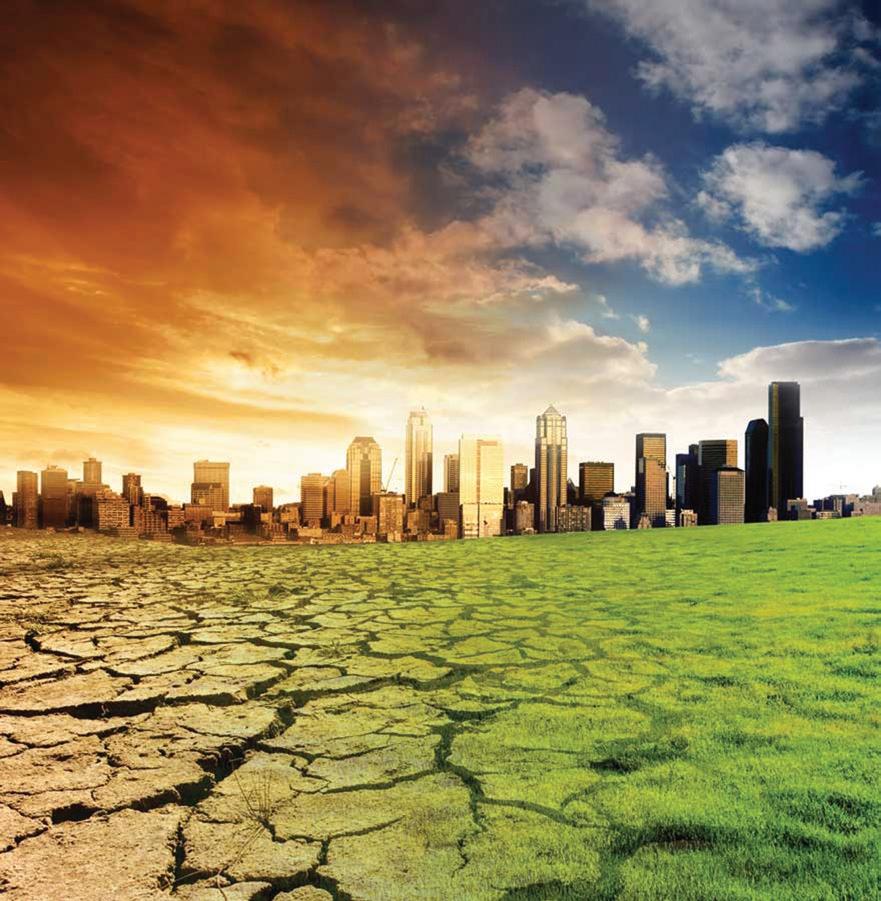
The Draft reiterates Articles 2, 4 and 9 of the Paris Agreement and highlights that about USD 4 trillion per year needs to be invested in renewable energy up until 2030 to be able to reach net zero emissions by 2050, and that, furthermore, a global transformation to a low-carbon economy is expected to require investment of at least USD 4–6 trillion per year. Also highlights that delivering such funding will require a transformation of the financial system and its structures and processes, engaging governments, central banks, commercial banks, institutional investors, and other financial actors.
The Draft notes with concern the growing gap between the needs of developing countries, in particular those due to the increasing impacts of climate change and their increased indebtedness, and the support provided and mobilized for their efforts to implement their nationally determined contributions, highlighting that such needs are currently estimated at USD 5.6 trillion27 for the pre-2030 period. It also expresses serious concern that the goal of developed countries to mobilize USD 100 billion per year by 2020 has not yet been met and urges developed countries to meet the goal. The document emphasizes that accelerated financial support for developing countries from developed countries and other sources is critical to enhancing mitigation action and addressing inequities in access to finance, including its costs, terms and conditions, and economic vulnerability to climate change for developing countries, and that scaledup public grants for mitigation and adaptation for vulnerable regions would be costeffective and have high social returns in terms of access to basic energy.
Furthermore, The Draft notes that global climate finance flows are small relative to the overall needs of developing countries, with such flows in 2019–2020 estimated to be USD 803 billion, which is 31–32 per cent of the annual investment needed to keep the global temperature rise well below 2 °C or at 1.5 °C , and also below what would be expected in the light of the investment opportunities identified and the cost of failure to meet climate stabilization targets.
The Draft urges developed countrieses to provide enhanced support, including through financial resources, technology transfer and capacity-building, to assist developing countries with respect to both mitigation and adaptation, in continuation of their existing obligations under the Convention, and encourages other Parties to provide or continue to provide such support voluntarily. It also calls on multilateral development banks and international financial institutions to reform their practices and priorities, align and scale up funding, ensure simplified access and mobilize climate finance from various sources and encourages multilateral development banks to define a new vision and commensurate operational model, channels and instruments that are fit for the purpose of adequately addressing theglobal climate emergency, including deploying a full suite of instruments from grants to guarantees and non-debt instruments, without exacerbating debt burdens, and to address the conservative appetite for risk and limited scale of capitalization with a view to increasing their deployment of climate finance three fold up until 2025.
Finally, The Document calls on multilateral development banks to contribute to significantly increasing climate ambition using the breadth of their policy and financial instruments for greater results, including on private capital mobilization, and to ensure higher financial efficiency and maximize use of existing concessional and risk capital vehicles to drive innovation and accelerate impact.

The Agreement highlighted the launch of the Sharm el-Sheikh dialogue between Parties, relevant organizations and stakeholders to exchange views on and enhance understanding of the scope of Article 2, paragraph 1(c), of the Paris Agreement and its complementarity with Article 9 of the Paris Agreement, and requests the secretariat, under the guidance of the Presidency of the twenty-seventh session of the Conference of the Parties to organize wo workshops in 2023 in this regard and to prepare a report on the deliberations of these workshops.
The Parties welcome with appreciation the first joint work program of the Technology Executive Committee and the Climate Technology Centre and Network for 2023–2027 which will facilitate the transformational change needed to achieve the goals of the Convention and the Paris Agreement, invite stakeholders to cooperate and engage with the Technology Executive Committee and the Climate Technology Centre and Network to support the implementation of the joint work program activities, including on technology needs assessments, action plans and road maps, acknowledge the findings in the final report on the first periodic assessment of the effectiveness and adequacy of the support provided to the Technology Mechanism in supporting the implementation of the Paris Agreement, and decides that the main challenges identified therein should be considered under the global stock take.
Post COP27: Despite the several successes that emerged from COP27, it’s crucial to note that more work is still required to keep things moving forward. The agreements and successes act as key components for a unified objective. COP28 will bring nations back to the negotiation table to implement additional measures and monitor performance.


www.globusrelief.org www.inc-world.info
The scientific community is critical to the fight against climate change yet universities, the sector that trains climate scientists and produces the most cutting-edge research in climate science, tend to remain left out of the agenda of the United Nations Climate Conference. At its latest iteration, COP27, held in Sharm El-Sheik, Egypt last November, international university network leaders addressed this absence and lobbied for researchers’ involvement in international climate conversations during a panel on
Universities as Key Solutions Providers: Leveraging our Local and Global Networks for Innovation, co-convened by the U7+ Alliance of World Universities under the leadership of the University of Toronto and Northwestern University, Worldwide Universities Network, Italian University Network for Sustainable Development (RUS), and Universities Climate Change Coalition (UC3). Together, panelists represented more than 150 institutions from both the Global South and Global North, which are collaborating amongst
themselves as well as with governments, local communities and industries to develop transformative climate solutions.
Universities as leaders and solution providers in climate science
Panelists discussed the kind of expertise, knowledge and solutions universities can contribute to addressing climate change, and many of the social issues stemming from it. They shared examples of scientific, technological and policy innovations universities are developing with a broad

range of local and global partners, from ambitious plans to reduce the carbon emissions of their campuses, build smart energy grids and develop green energy technologies to recent scientific breakthroughs, including new chemical processes designed to break down “forever chemicals” and so-called “unrecyclable” plastics. Panelists attributed these and other breakthroughs, in part, to universities’ ability to connect dots and foster collaboration among experts in the basic sciences, social sciences, arts and humanities, who so often operate within silos.
Also, the range of problems climate change brings about at the regional and local levels makes it difficult to engineer one-size-fits-all global solutions. This is precisely where universities are stepping in to provide solutions and can have a measurable impact. Member institutions of the U7+ Alliance of World Universities, for example, have committed to reducing greenhouse gas emissions stemming from their operations by 2030 in line with the United Nations Sustainable Development Goals. The University of Toronto is funding a Climate Positive Energy research project that will collect data on travel behavior to and from campus to assess the travel patterns in the university community and estimate the greenhouse gas emissions of the trips. The project will provide insights into how Toronto’s transportation infrastructure is meeting the needs of the campus community, and where spatial and social inequities in emissions exist. With this information, the community will be able to design interventions for more sustainable travel. The project also contributes directly to the city of Toronto’s ambitious strategy to reduce community-wide greenhouse gas (GHG) emissions to net zero by 2040, one of the most ambitious GHG-reducing goals in North America.
The collaborations universities are fostering in addressing the climate crisis locally also generate knowledge and models that can be shared and adapted across borders. The University of TorontoNorthwestern Decarbonization Alliance, for example, is creating a model for large scale societal decarbonization. The model aims to tackle the complexity of implementing decarbonization, which requires a series of precise steps to reduce carbon dependency across industries and
economic sectors without disrupting the normal functioning of vital activities such as global food production, transportation, construction, and chemical manufacturing.
With a vibrant ecosystem, and an array of flora and fauna, the Sargasso Sea has been referred to as the “Golden Rainforest”. Because of its important biodiversity, the Sargasso Sea is protected by the Hamilton Declaration and overseen by the Sargasso Sea Commission.
Universities create meaningful partnerships for change
Universities are also partnering with local citizens and communities to define priorities for climate research initiatives. These collaborations are serving as “living laboratories” for experimenting with new ways to pursue sustainability. The Université Côte d’Azur’s Observatoire de la Transition Ecologique et Citoyenne Côte d’Azur (OTECCA), for example, allows local authorities and representatives of civil society such as neighborhood associations, student organizations, and local farming collectives to exchange knowledge with scientists, co-create research questions, and gather data. In 2020, OTECCA partnered with a farming group that produces organic food through collective labor. Applying an interdisciplinary social science approach that involved phycologists and political scientists, OTECCA modeled the characteristics of the group that made them successful,
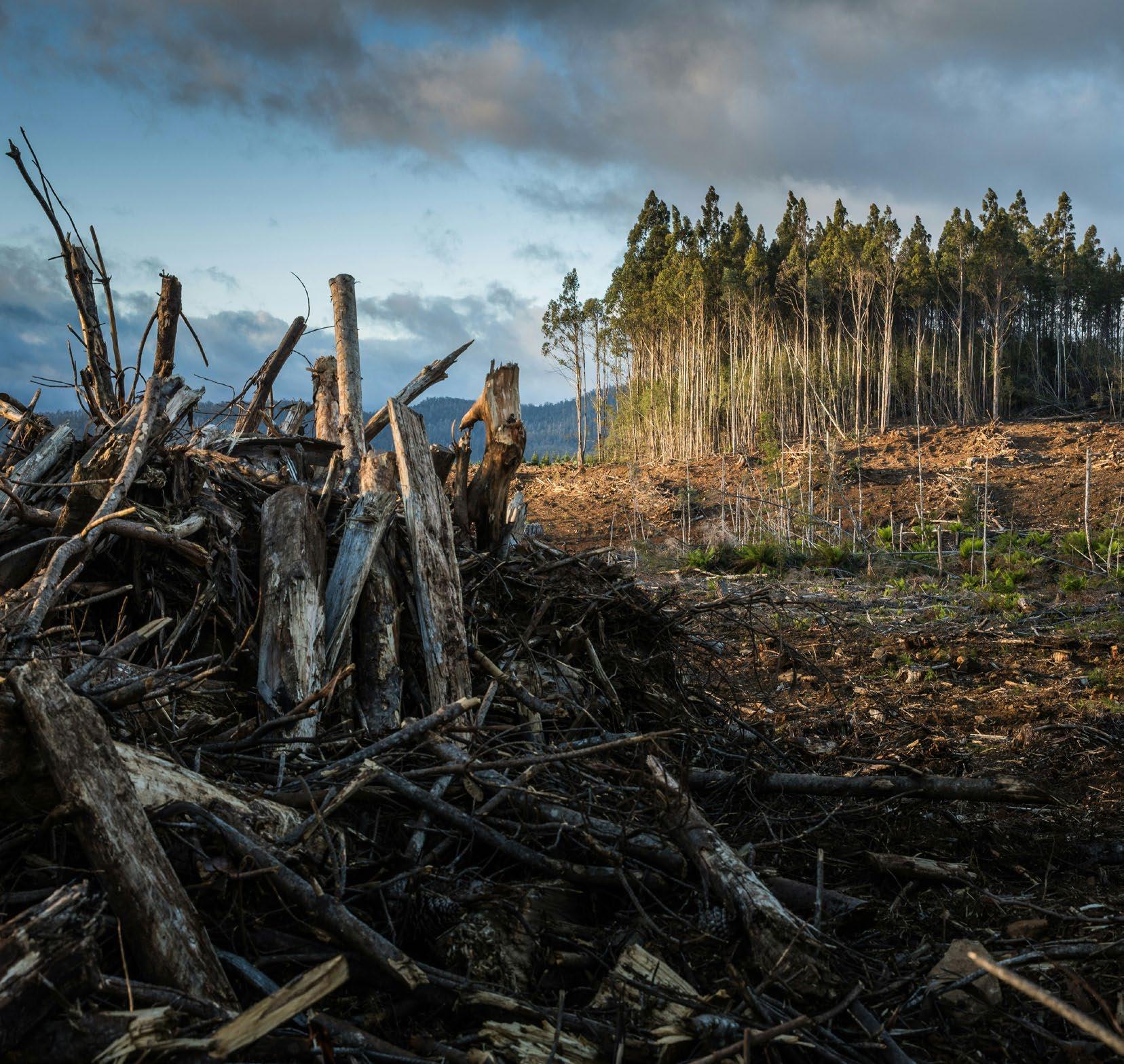

hoping to identify how this initiative could be replicated elsewhere.
Community collaborations are necessary if cities and territories are to meet the sustainability goals they have set for themselves for the next two decades. During the panel, Patrizia Lombardi, a sustainable development expert at the Polytechnic University of Turin, reminded everyone how important it is for cities and local communities to partner with universities in current decarbonization efforts and to invite universities to play an active role in multilevel governance: “There is a need for cities to speed up the transition to achieve [carbon] neutrality by 2050. But statistics say they will not be able to do so unless there are collaborative efforts.”
Universities train the next generation of leaders
One of the most crucial contributions of universities to the global fight against climate change is their role in training the next generation of global leaders, scientists and climate activists. Universities offer students opportunities to explore sustainability from a broad range of academic and practical perspectives, and
One of the most crucial contributions of universities to the global fight against climate change is their role in training the next generation of global leaders, scientists and climate activists.
a next generation of higher energy density, more sustainable batteries. These are only a handful of examples of student projects shaping the future of climate change solutions within the university networks participating in the panel.
he results were visible at COP27, where university networks put student-led climate action projects on display. For example, university students around the world are developing new tree planting methods to offset carbon emissions and promote biodiversity, broadening accessibility to public transportation, minimizing the degradation of drinking water systems, raising awareness about mercury pollution, creating thermal electric generators that produce energy from heat that would otherwise be lost, and designing capsule materials for lithium sulfur batteries—
The event concluded with a lively discussion on some of the challenges facing universities engaged in work to address climate change: the need to divest their economic activities from those of fossil fuel companies, tackle Scope 3 emissions stemming from their procurement of travel, food, and waste management services, and establish best practices for partnering with industries currently contributing to climate change but working to generate climate solutions. By the end of the panel, attendees expressed hope and optimism that, moving forward, universities can increasingly participate in multilateral climate conversations such as COP. With their diversity of expertise, resources for research and innovation, relationships with local governments and communities, and convening power, universities’ ability to spur societal change and contribute to addressing the climate crisis is not to be underestimated.



























COP28 was designed to be different. A COP firmly rooted in inclusion. A COP that delivers the highest ambition response to the Global Stocktake, that builds a prosperous world for all and leaves no one behind. Together, we are working for this to be the COP that changed the game. Day seven of COP28 represents the half-way point between the agreements made in Paris and 2030. It is a day to celebrate all the hard work by dedicated people around the world from then until now, culminating in a record number of new global pledges and commitments at COP28, signaling a shift in the real economy, as well as historic actions made by the Parties to rapidly adopt the agenda and come together on the loss and damage decision. Week one of COP28 has created a new sense of optimism and hope, based on a collective spirit of near-term action and delivery. But the job is not done. During week two we must continue to raise ambition and commit to further actions, results, and solidarity. Parties have been called upon to collectively rise to the occasion and match this spirt and unity of week one with the highest ambition response to the GST in the final decision.
During the World Climate Action Summit (WCAS), on 1 and 2 December, UAE welcomed 156 Heads of State and Government, 22 International leaders, and 784 Ministers to launch a new era of climate action on the road to 2030. Throughout the week, participants engaged in hundreds of events, discussions and pledging conferences to build momentum to unite, act and deliver.
The COP28 Presidency has a clear north star: Keeping 1.5OC within reach and focusing on near-term action to close the mitigation, adaptation and finance gaps to meet 2030 targets. World leaders, delegates, civil society, business, indigenous peoples, youth, philanthropy, and international organizations responded.
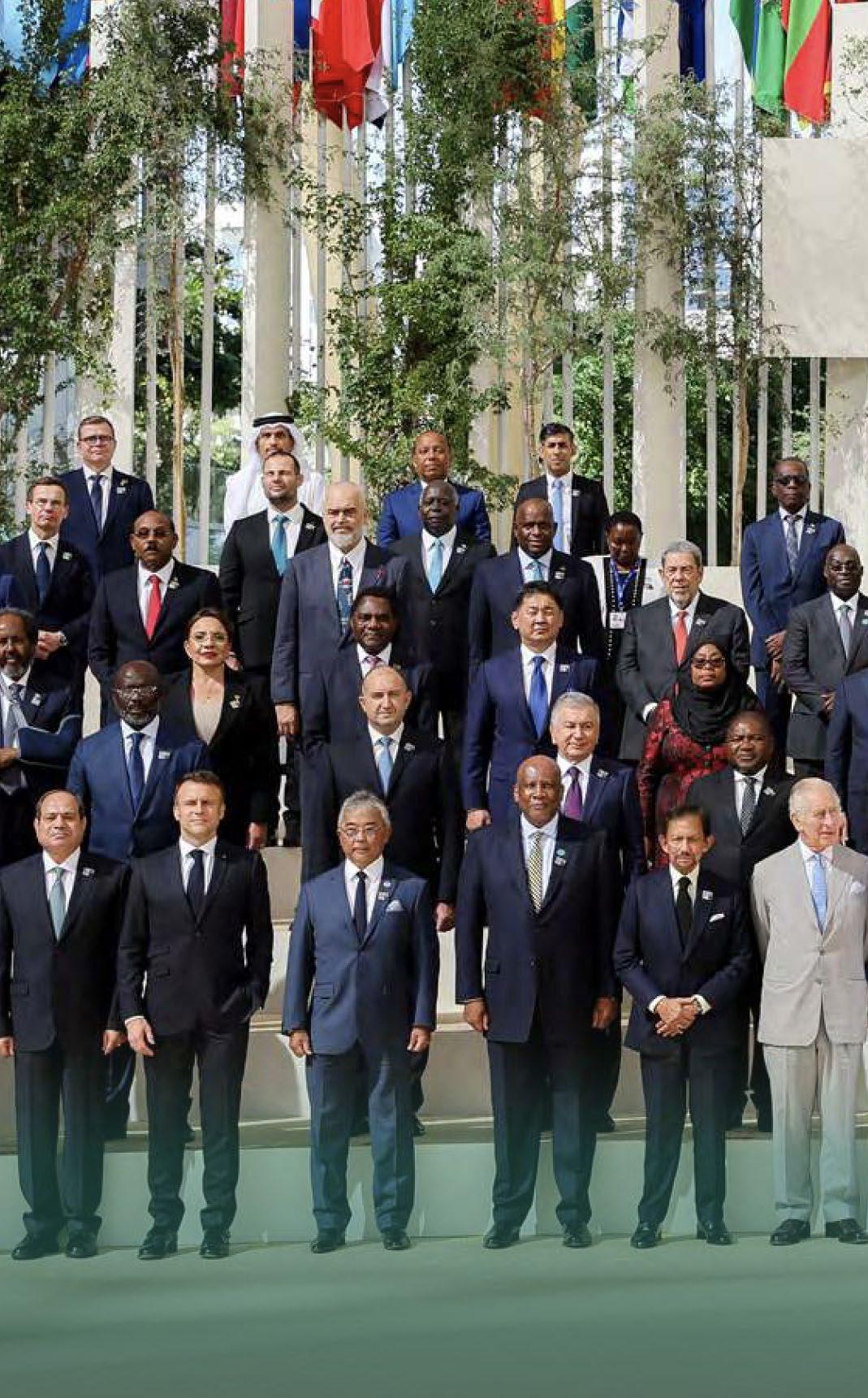
Setting a high benchmark of ambition from day one, Parties defied expectation and successfully adopted the agenda and the loss and damage decision. 19 countries took a further step to demonstrate the spirit of
international solidarity and made commitments totaling $726M towards the fund and funding arrangements related to loss and damage, including $100M from the UAE.

Across the WCAS, and the thematic days of week one on Health, Relief, Recovery & Peace (3 December), Finance, Trade, Gender Equality and Accountability (4 December), Energy, Industry & Just
Transition, Indigenous Peoples (5 December) and Multilevel Action, Urbanization & Built Environment and Transport (6 December), ambitious commitments were made to mobilize real world action across the COP
Presidency’s four paradigm shifts to keep the Paris goals within reach.

On Energy, in parallel to the Negotiations efforts, the COP28 Presidency unveiled plans to reduce emissions in energy systems of today, while building the energy system of the future. The COP28 Presidency launched with multiple partners the Global Decarbonization Accelerator (GDA), a comprehensive, cross-sectoral package to slash emissions to accelerate a just, equitable and orderly energy transition with the following three pillars.
On methane, the COP28 Presidency held the COP28 Summit on Methane and other Non-GHG Gases together with the US and China on 2 December, followed by a deep-dive session on 5 December. In total, $1.2BN was mobilized to support the reduction of methane and other non-CO2 GHG across sectors. Participants of the
Summit reiterated the call for whole-ofeconomy NDCs encompassing all GHG. Governments, as well as national and international oil companies discussed effective pathways to zero methane emissions by 2030. The World Bank announced that it will support 15 countries with national programs to slash methane emissions of up to 10 million tons over the next five to seven years from rice production, livestock, and waste.
On methane, the COP28 Presidency held the COP28 Summit on Methane and other Non GHG Gases together with the US and China on 2 December, followed by a deep-dive session on 5 December. In total, $1.2BN were mobilized to support the reduction of methane and other non-CO2 GHG across sectors. Participants of the Summit reiterated the call for whole-ofeconomy NDCs encompassing all GHG.
Governments, as well as national and international oil companies, discussed effective pathways to zero methane emissions by 2030. The World Bank announced that it will support 15 countries with national programs to slash methane emissions of up to 10 million tons over the next five to seven years from rice production, livestock, and waste.
The Oil & Gas Decarbonization Charter (OGDC) was endorsed by 52 companies across all continents, including 32 national oil companies. Endorsers cover 40% of global oil & gas production, and 35 committed to near zero methane emissions for the first time. Endorsing CEOs detailed their plans to support the target to reach net zero emissions by 2050 or before.
On heavy emitting sectors, the Industrial Transition Accelerator (ITA) was on 2 December. A roundtable was held on 5 December to detail how the 38 endorsing companies and 6 industry associations will accelerate global decarbonization in heavy emitting sectors and transport. Further action included the launch of the Emirates Breakthroughs and a private-public green demand session where countries and companies pledged to procure lowcarbon materials.
Opportunities for advancing the energy transition through sustainable urban development were recognized on 6 December with the launches of the Buildings and Cement Breakthroughs, which garnered support from over 30 countries to advance the decarbonization of the buildings and construction sector by 2030. The UAE Ministry of Climate Change and Environment also launched the Waste to Zero coalition, a first-of-its-kind effort to bring together all levels of government, NGOs and business to decarbonize the waste sector and accelerate the shift towards circular and regenerative modes of industry and production.
The COP28 Presidency further highlighted the critical role that the private sector plays in global decarbonization through a showcase awards event. The Energy Transition Changemakers recognized a total of 39 companies across Renewables & Clean Power, Energy Efficiency, Heavy Emitting Sectors and Low-carbon Hydrogen.
The COP28 Presidency also held a session in which Governments iterated the need for increased finance and policy to ensure a just and managed energy transition away from coal. Some examples include the Coal Transition Accelerator, an initiative to encourage the transition from coal, and the Powering Past Coal Alliance (PPCA) which announced new signatories.
Spotlight was put on building the energy system of the future. 124 countries endorsed the Global Renewables and Energy Efficiency Pledge, committing to tripling renewables and doubling annual energy efficiency improvements by 2030. $5BN was mobilized to facilitate the implementation of the pledge globally, including to support deployment of renewables in the global
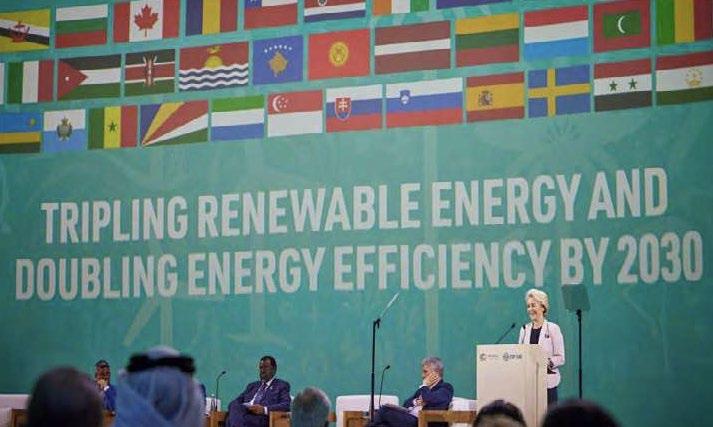
Together with the COP28 Presidency, representatives from multiple countries and organizations took part in the launch of the Global electric Cooking Coalition “GeCCo”, which is set to mobilize finance and accelerate electric cooking use.
South. On 5 December, an inaugural ledge Ministerial brought together over 40 Ministers and Deputy Ministers, representing all regions including Global South and Indigenous Peoples, to discuss the implementation of the pledge.
37 governments declared their intent to pursue the mutual recognition of certification schemes for hydrogen and its derivatives, accelerating over 80% of future low-carbon and renewable hydrogen cross-border trade. The COP28 Presidency also hosted the first-ever Ministerial-CEO roundtable on hydrogen.
The Global Cooling Pledge, launched together with UNEP, was endorsed by 65 countries. All commit to reducing coolingrelated emissions across all sectors by at least 68% by 2050 vs. 2022 levels, to ratify the Kigali Amendment by 2024, supporting HFC phase-down and HCFC phase-out and expanding access to sustainable cooling by 2030, among others. A $25M fund was announced towards sustainable cooling. Together with the COP28 Presidency, representatives from multiple countries and organizations took part in the launch of the Global electric Cooking Coalition “GeCCo”, which is set to mobilize finance and accelerate electric cooking use. More than $30M were announced in support of
electrifying cooking, in addition to the World Bank’s announcement of $5BN IDA financing to help 100 million people access electricity and 20 million people access clean cooking in Eastern and Southern Africa by 2030.
30+ countries also came together for the first time under the COP28 Presidency to discuss carbon management, in a session joined by HE John Kerry, United States Special Presidential Envoy for Climate and Xie Zhenhua, China Special Envoy for Climate Change.
During their interventions throughout the World Climate Action Summit and Energy Day, leaders and ministers were clear in their ambition. They highlighted the opportunities to cut emissions in every sector and to accelerate policy action and technology innovation to address scope 3 emissions, as well as the phase down of fossil fuels in support of a transition consistent with limiting warming to 1.5OC. Leaders particularly stressed the importance of the urgency of action, whilst recognizing the need to accelerate the mobilization of finance. They highlighted the critical need in developing countries where finance and technology are prerequisites for a just energy transition that responds to increased energy demand. ■

Progress on climate finance has been gridlocked in recent years, with a gap in the trillions between flows and investment needs in emerging markets and developing economies. The objective for this COP was clear: Ensure finance for climate action becomes more available, accessible, and affordable. This COP also aimed to change the narrative from climate investment as a burden to climate investments as the economic opportunity of a lifetime. In the first week, Governments, International Financial Institutions and the private sector took significant leaps towards that goal in Dubai.
During the WCAS, 12 leading countries on finance reform launched a new vision for climate finance through the COP28 UAE Declaration of Leaders on a Global Climate Finance Framework, which summarizes the need for collective action, opportunity for
all, and delivering at scale(1). The UAE also announced a Finance Forum to be held in 2024 to track progress against commitments made at COP28 and to report back on the implementation of the global climate finance framework.
Significant progress was made on delivering commitments and moving ahead with collective action through confirmation that the overdue $100BN goal looks likely to have been met this year, pledges to the Green Climate Fund that took this year’s replenishment total to a historic $12.8BN, and cumulative contributions of $295M to the Adaptation Fund and Least Developed Countries Fund. Unprecedented early action was taken on loss and damage with a landmark adoption of an agreement on Loss and Damage, and almost $726M pledged to the fund and funding arrangements.
A host of innovative financing
mechanisms were announced to support vulnerable countries in the context of high debt burdens, particularly through pledges to the IMF Resilience and Sustainability Trust, commitments to channel Special Drawing Rights (SDRs) to the African Development Bank, and wide adoption of climate-resilient debt clauses which pause a country’s debt when it is hit by a natural disaster. The four biggest multilateral climate funds issued an unprecedented joint statement committing to harmonize their standards and work complimentarily to increase access to climate finance.
Multilateral Development Banks signaled a step change in their ambition, announcing over $180BN in additional climate finance commitments through multi-year programs. The World Bank committed to increase its climate finance target to 45% by 2025, unlocking an additional $9BN a year,

while the Inter-American Development Bank (IDB) announced a target of tripling its direct climate finance and mobilizing up to $150BN over the next decade. The World Bank also announced $5BN to support 100 million people in Africa with clean energy access in the next seven years, and the IDB announced $5BN to sustainable development projects in the Amazon, as well as $1BN in incentives for countries to meet their climate and nature targets.
Other commitments included $10BN by Asian Development Bank (ADB) in climate finance to the Philippines, and $1BN by Islamic Development Bank (IsDB) to support adaptation in conflict affected countries. IMF, ADB, World Bank, AIIB, EIB and other international financial institutions, in collaboration with the Government of Bangladesh, announced a country platform for climate and development in Bangladesh,
Multilateral Development
Banks signaled a step change in their ambition, announcing over $180BN in additional climate finance commitments through multi-year programs.
committing to generate a robust project pipeline integrated with a financing strategy to enhance the nation’s ability to mitigate and adapt to the effects of climate change. EBRD, EIB, and other partners in collaboration with North Macedonia, announced a country platform for just energy transition in North Macedonia to support investments, policy and technical assistance to accelerate clean energy deployment. In their joint statement, MDBs committed to continue working through country platforms, develop a common approach for reporting climate impact, launch a Long-Term Strategy facility to support countries with strategies for decarbonization and climate resilience, and launch common principles for tracking nature-positive finance.
To deliver on shared prosperity for all, African leaders came together for →

→ the launch of the Africa Green Industrialization Initiative. This initiative aims to harness Africa’s vast and high-quality resources to expand clean energy access and economic growth through country-owned strategies, with over $4BN worth of projects announced under this initiative at COP28. It will work closely with UAE’s $4.5BN Africa Green Investment Initiative, announced at the Africa Climate Summit, which has already deployed $2.6BN in clean energy projects in Africa. Global and African partners also came together to pledge $175M to the Alliance for Green Infrastructure in Africa, which will work to create a robust project pipeline and catalyze private finance.
Eight leading export credit agencies came together with other partners to launch the UN-convened Net-Zero Export Credit Agencies Alliance (NZECA), the first net-zero alliance comprising public finance institutions globally, to help decarbonize global trade.
Finally, COP28 saw groundbreaking levels of engagement through the private sector to deliver climate finance at scale. The UAE launched the $30BN catalytic climate fund ALTERRA, equipped with a special $5BN risk mitigation facility dedicated to incentivizing investments in developing countries, and with the ambition to mobilize $250BN by 2030 for the climate transition by private and institutional investors. Several other new blended finance instruments were announced focused on the Global South, such as the Allied Climate Partners (ACP) platform, which aims to use $825M as initial capital to mobilize $11BN of investments in developing countries. The UAE banking sector mobilized a collective $270BN in forward-looking sustainable finance commitments by 2030, and the three main Islamic infrastructure organizationsIFSB, CIBAFI and AAOIFI - launched a Roadmap for Islamic Sustainable Finance.
The UAE also launched the Global Climate Finance Centre, an ADGM-based think-tank to drive the transformation of the sustainable finance sector, through policy, innovation, capacity building and championing of best practice. The Glasgow Financial Alliance for Net Zero (GFANZ) unveiled its 2023 Progress Report on transition finance, showing progress made on transition planning, mobilizing capital in emerging and developing markets and other goals.
The COP28 Presidency convened global leaders from international organizations, governments and the financial sector to speed up progress in scaling transition finance. Eight leading export credit agencies came together with other partners to launch the UN-convened Net-Zero Export Credit Agencies Alliance (NZECA), the first net-zero alliance comprising public finance institutions globally, to help decarbonize global trade. Country leaders and industry executives stressed the importance of Voluntary Carbon Markets (VCMs) as an important complement to the climate finance toolkit, with an agreement by standard setters to move towards an end-to-end integrity framework. The World Bank announced that it will kickstart a certification program for carbon credits, starting with certification of carbon credits for forestry in 16 countries, which will generate 125 million carbon credits in five years. ■


The first week of COP28 saw an unprecedented set of policy and finance commitments from across the public and private sectors to put nature, lives, and livelihoods at the heart of the climate agenda, bolstering and humanizing the response to the Global Stocktake.
Food was established firmly as a COP priority, with 146 Heads of State and Government endorsing the COP28 UAE Declaration on Sustainable Agriculture, Resilient Food Systems, and Climate Action to address food’s high vulnerability to climate impacts and its contribution to emissions. Companies and philanthropies also announced major regenerative agriculture and climate-food innovation initiatives, underpinned by $3.1BN of finance to help implement the declaration.
Related, water featured for only the second time in a COP summit, with $150M of new finance announced for innovations to address water scarcity innovations and a
doubling of MDBs’ water portfolios within three years. The food, agriculture, and water communities will reconvene on 10 December to close COP28’s Action Agenda with a focus on the next round of NDCs and 2030 targets, as well as smallholder farmers and freshwater ecosystems.
COP28 also saw the Presidency’s introduction of two new items to the global climate agenda - Health and Relief, Recovery, and Peace - through the first dedicated thematic day on 3 December, enabled by extraordinary participation and leadership from the sectors’ communities.
In a watershed moment for climate and health, supported by the World Health Organization (WHO), 133 countries endorsed the COP28 UAE Declaration on Climate and Health, and finance providers mobilized an initial tranche of $2.6BN for climate and health solutions. In the firstever climate-health ministerial at a COP, co-hosted with the WHO, ministers and
senior representatives from over 110 health ministries announced plans and actions to address a range of manifestations, including air pollution, the spread of infectious disease, and mental health, among others.
They also called for a robust health presence in the Global Stocktake and celebrated its inclusion in the Global Goal on Adaptation. COP28 also gave the highest-ever political visibility to frontline communities, primarily in LDCs and SIDS, that are experiencing extreme vulnerability, fragility, and conflict, where per capita climate finance flows are 5 and sometimes 80 times less than the average in lowerincome countries.
The Presidency’s introduction of the COP28 UAE Declaration on Climate, Relief, Recovery, and Peace, endorsed by 75 governments and 42 organizations, for the first time united governments and entities around a series of measures to narrow the gap in these contexts - one of
the biggest blindspots in Paris Agreement implementation. In addition, the Charter on Finance for Managing Risk: Getting Ahead of Disasters, coordinated by Samoa and the UK with UAE support, was signed by 39 countries and partner agencies to increase the share of resources released before a climate disaster occurs, on the basis of scientifically credible forecasts. The effort complemented progress updates from 30 countries on the UN Early Warnings for All initiative to cover 100% of the globe with early warning systems by 2030.
An overall first tranche of $1.2BN to scale up climate action in the most vulnerable contexts was announced, and leaders called for the first Relief, Recovery and Peace Day to also be the inaugural one.
Cutting across lives and livelihoods, nature saw sharply increased political will for climate action, with Heads of State and Government from forest-rich countries across Asia, Africa, and South America, and ocean-rich countries in the Pacific introducing landmark investment plans to simultaneously implement the Paris Agreement and new Global Biodiversity Framework. Dual-climate action was also a recurring theme of the WCAS. Nature-rich countries and their partners announced $2.5BN of underpinning finance from public and private sources and emphasized the livelihoods and development goals of local and indigenous communities. President Lula da Silva and the COP28 Presidency announced a two-year partnership to mobilize new resources and political support for nature on the road to COP30 in Belém.
On the private sector side, a new $750M growth financing platform was launched for climate-focused investments, and innovative solutions related to climate and biodiversity.
A commitment of up to $1 trillion for was announced for Amazon Rainforest preservation through a nature-based asset platform. Over 150 businesses and investors confirmed plans to pioneer disclosure and reporting on “naturepositivity”, through such tools as the Taskforce on Naturerelated Financial Disclosures (TNFD) and Science Based Targets Network (SBTN).
Stakeholders will gather on Nature, Land Use, and Ocean Day on 9 December with a major focus on mangroves, ocean, and implementing the newly adopted global goal to protect 30% of the land and sea by 2030.
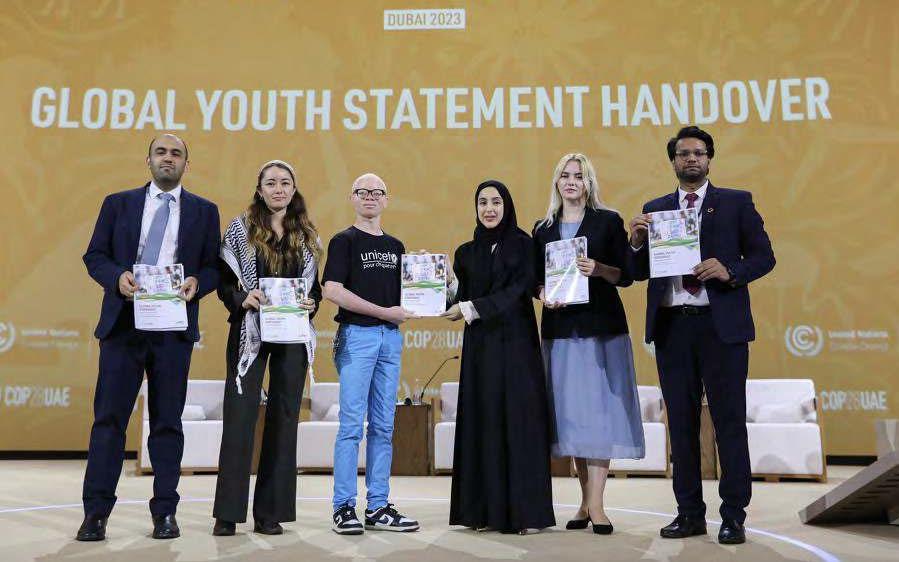
Throughout the first week of COP, engagements responded to the Presidency’s strong call for inclusive climate action and solidarity, highlighting the key roles of civil society, women, youth, local leaders, faith-based communities, Indigenous Peoples, companies, and those on the frontline of climate change, who are an integral part of the solution.
In particular, the key role of children and youth in climate action was highlighted. The first Youth and Education WCAS session placed children, youth and educators center stage. Throughout the week their power and passion were highlighted, including through the delivery of a strong set of policy demands through the Global Youth Statement, which was handed over to COP28 President Dr. Sultan Al Jaber, Youth Climate Champion H.E. Shamma Al Mazrui and UN Secretary- General António Guterres. Additionally, the YOUNGO youth network held a series of policy dialogues between youth and policymakers as part of the Second Mandated Youth Policy Forum to feed into Week 2 of negotiations. A Global Education Solutions Accelerator was launched to fast-track education transformation benefitting 2.1 billion people, and a $70M investment to build climate resilient schools in vulnerable
countries was announced by the Green Climate Fund, the Global Partnership for Education and Save the Children.
The first week also saw a historic presence of subnational leaders, with more than 500 mayors, governors and local leaders participating, including within the WCAS and the dedicated Local Climate Action Summit. The COP28 Presidency and Bloomberg Philanthropies announced the groundbreaking Coalition of High Ambition Multilevel Partnerships (CHAMP) Pledge, endorsed by 65 countries, committing to partner with subnational governments on the next round of NDCs and other climate plans and strategies. In total, nearly $500M was mobilized toward urban climate action.
On 6 December, the COP28 Presidency and UN Habitat also hosted the Ministerial Meeting on Urbanization and Climate Change, convening over 1000 participants, including Ministers of Environment, Housing and Urban Development from over 40 countries, and over 200 subnational leaders. The Ministerial reaffirmed support for CHAMP, enhanced access to climate finance for subnational governments, and concluded with Brazil announcing plans to further integrate local and urban climate action into the climate agenda at COP30. →
→ 4 December saw the first integration of Gender Equality and Finance Days to underscore the critical importance of resourcing women and girls in climate action. The COP Presidency unveiled the COP28 UAE Gender-Responsive Just Transitions & Climate Action Partnership, endorsed by 74 countries to mainstream women’s leadership, decisionmaking, and financing in the just transition required by the Paris Agreement.
Over 850 businesses and philanthropies participated in the Business and Philanthropy Forum on 1 and 2 December and announced $5BN in new funding to turbocharge the climate transition in emerging economies. Over 200 Small and Medium sized Enterprises, mainly from the Global South, joined to play their part in driving a step-change in the development and deployment of climate tech solutions.
The COP28 UAE Presidency launched the Net Zero Mobilization Charter to encourage the private sector to make and update net-zero emissions targets, underpinned by ambitious transition plans with regular updates. To date, there are over 200 global signatories to the Charter. On 4 December, the first Accountability thematic day was held, with sessions aimed at further accelerating private sector transition planning, including NDC contributions.
Key globaldecision makers provided recommendations for creating an equitable transition ecosystem through the adoption of netzero accountability standards and green policies.
Trade was also an officially recognized thematic day at the COP28 for the first time. The centrality of trade in achieving global climate targets was explored across six panels including a focus on finance, technologies, critical minerals and the role of trade in enabling development for the global south. The climate and trade high-level event set the stage for elevating the role of the international trade community in the climate policy ecosystem. The World Trade Organization,United Nations Conference on Trade and Development (UNCTD), DP World, and International Chamber of Commerce, collectively promoted the WTO roadmap of trade policy options for a just and ambitious global response to climate change.
Tech and innovation featured prominently in the first week. COP28’s Climate Innovation Forum on 1 December convenedglobal tech leaders to explore the development and scaling of cutting-edge climate solutions and breakthroughs, attracting approximately 250 attendees. The Technology and Innovation Hub stage featured 65 sessions and 215
speakersexploring the enabling role of technology, innovation & entrepreneurship in tackling climate change in a variety of engaging formats attracting almost 5500 attendees. COP Connect networking events brought together near 500 guests and the startup village in the Green Zone featured over 100 climate tech start-ups.
The Innovate for Climate Tech coalition was launched at the Business and Philanthropy Climate Forum, facilitated by the COP28 Presidency and anchored by Masdar City, Tencent, and Catalyst. It attracted 39 new partners.
COP28 held the first Space Agencies Leaders’ Summit on 5 December, hosting 20 international space agencies. The summit focused on enhancing data and resource sharing between established and emerging space nations, funding towards climate research initiatives, supporting climate monitoring and promoting sustainable pace operations by minimizing the environmental impact of space operations.
Outcomes across the thematic areas built on and enhanced the work under the Marrakech Partnership for Global ClimateAction, led by the UNFCCC High-Level Climate Champions, as demonstrated at the launch of their implementationroadmap of 2030 Climate Solutions. ■
The second week will see several important topics covered by the Presidential action agenda, including youth and education, nature and ocean and food and water systems.
On the negotiations, an approach to the political engagement by Ministers during the second week of the Conference is being finalized to effectively bring all outstanding issues to a successful conclusion. This is developed to help facilitate a balanced and equitable suite of outcomes that can effectively deliver a course correction, in line with the goals of the Paris Agreement. It emphasizes an integrated approach that encompasses all critical pillars: mitigation, adaptation, finance and the conclusion of the first GST.
To further bolster these efforts, Ministerial pairs were briefed on the
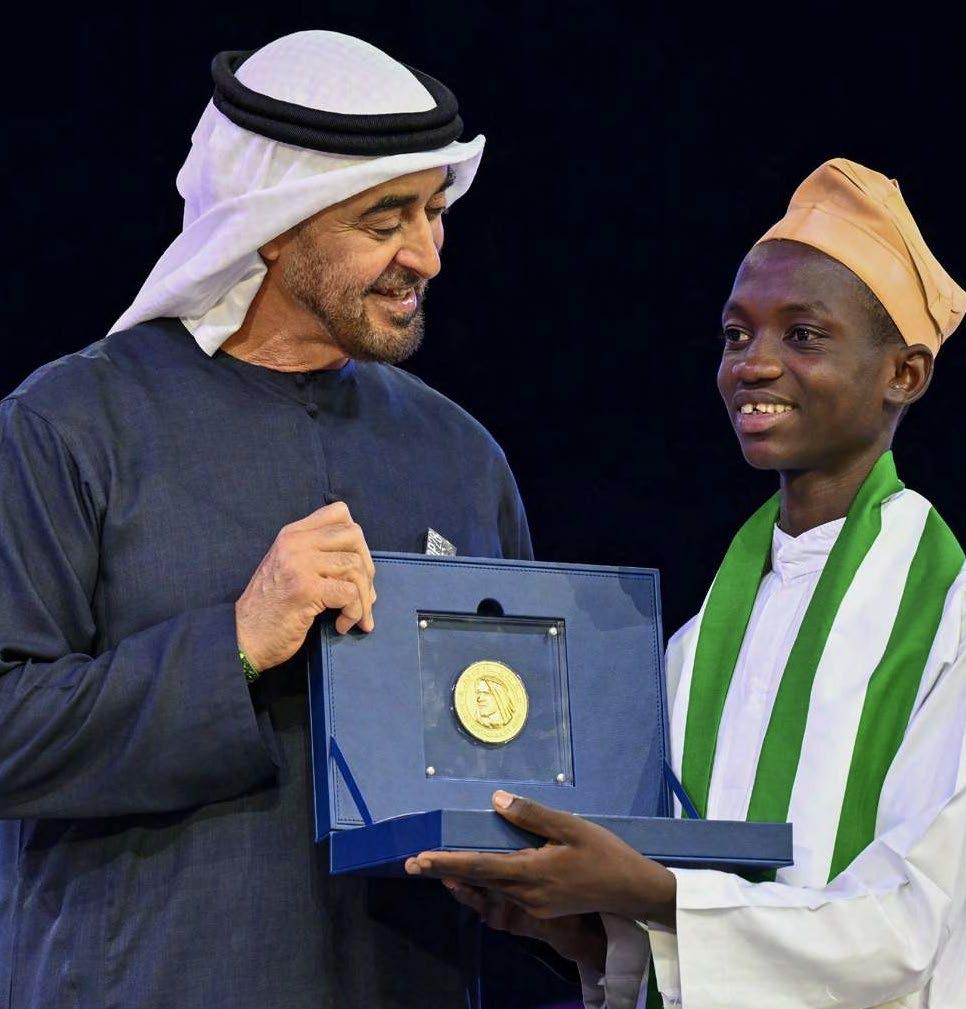
scope and approach for political engagement around different issues. This briefing informed and equipped them to take
forward their roles and responsibilities, as well as how they can actively contribute to the successful implementation of the strategy.
In week 2, Parties will need to reach across the aisle to work towards a compromise to collectively deliver a truly historic outcome. The Presidency has made a strong call to action for a Global Stocktake decision that lays the groundwork for the just energy transition that keeps 1.5 degrees in reach, while enabling that kind of action through adequate, affordable and accessible finance. The world needs a decision that makes a difference to people’s lives, livelihoods and ecosystems, with a concrete pathway to do so this decade, and a decision that is fair, based on the science and doesn’t mean developing countries have to choose between climate action and development. ■

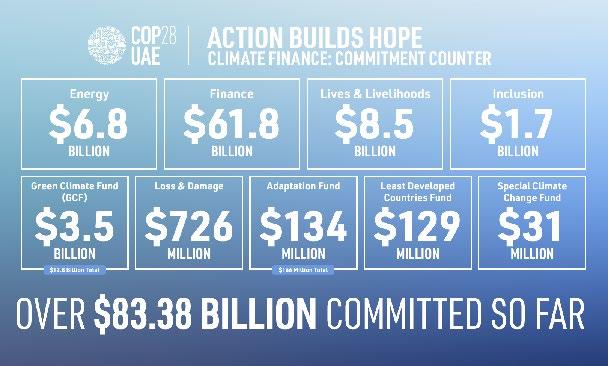
As the Ethiopian ambassador to the United States, I am enormously proud of the epic battle that Ethiopia is waging against a warming planet. As we get back to the hard work of combatting climate change in the wake of COP 24, I want to remind my colleagues across the globe that according to climate scientists, Ethiopia is one of the 10 most vulnerable countries in the world to climate change; and yet we as a nation have contributed very little to the industrial emissions that are now warming our planet at an alarming rate.
Desertification, which causes Ethiopia to lose more than 2 billion metric tons of arable soil and 230,000 acres of forest and woodland a year; locust swarms, that consume critically needed crops that could feed many more of our people; and malaria outbreaks, that kill thousands of our brothers, sisters, and children are all made immeasurably worse by global warming.
And yet, my government refuses to play the blame game, nor do we wait for the aid we desperately need to fight this battle. This year, Ethiopia became the first country in the world to ban gas and diesel-powered cars, in favor of electric vehicles. And we are rapidly expanding sources of renewable energy. We can now generate more than 60,000 megawatts of electricity a year from hydroelectric, wind, solar and geothermal projects.
In addition, we are implementing massive new forestry and agroforestry projects to

sequester the world’s carbon, feed our people more efficiently, and reduce the impacts of climate change. In 2019, Ethiopia planted 353 million trees in a single day, as part of the Green Legacy Project, setting what is believed to be a new world record. The total number of seedlings planted as part of Prime Minister Abiy Ahmed’s Green Legacy Project is expected to surpass 33 billion trees before the end of 2024.
Ethiopia has also signed a $40 million dollar agreement with the World Bank to help communities and local governments reduce carbon emissions and increase carbon sequestration through forest preservation and other environmentally
friendly land use techniques. Projects unded by this agreement are expected to reduce 4 million metric tons of carbon dioxide emissions by 2030. And we expect to generate an additional $60 million dollars in the next six years from private sector carbon credit projects as well.
These projects help us feed our people and generate additional export revenue. Over the last six years, agroforestry and sustainable land use projects organized by the Oromia Coffee Producers Union have generated more than a million euros through the sale of carbon credits, meaning that every cup of delicious, hot coffee – from the birthplace of coffee, Ethiopia – is not just good for the soul and the tastebuds. It’s good for the planet.
Ethiopia has also signed a $40 million dollar agreement with the World Bank to help communities and local governments reduce carbon emissions and increase carbon sequestration through forest preservation and other environmentally friendly land use techniques.
But Ethiopia should not have to go it alone. Each year, pollution created by the world’s industrial powers literally consumes the land we use to feed our people, by exacerbating the climate-driven effects of desertification, impacting irrigated croplands whose soils are often degraded by the accumulation of salts; and rain-fed croplands, which suffer from increasingly erratic rainfall and wind-driven soil erosion. Ethiopia is doing the work. I call on the global family of nations to roll up their sleeves and help us before it is too late for those of us who reside in the countries that suffer most from climate change, and then eventually for the rest of the world ■
Today’s leaders and organizations are grappling with greater divisions and contradictions that present barriers to change and lasting impact. By bringing diverse stakeholders and ideas together, inspiring confidence, and working beyond traditional boundaries, APCO builds the un/common ground upon which progress is made.
What are you grappling with? Contact us and see how we can help your team at: apcoworldwide.com
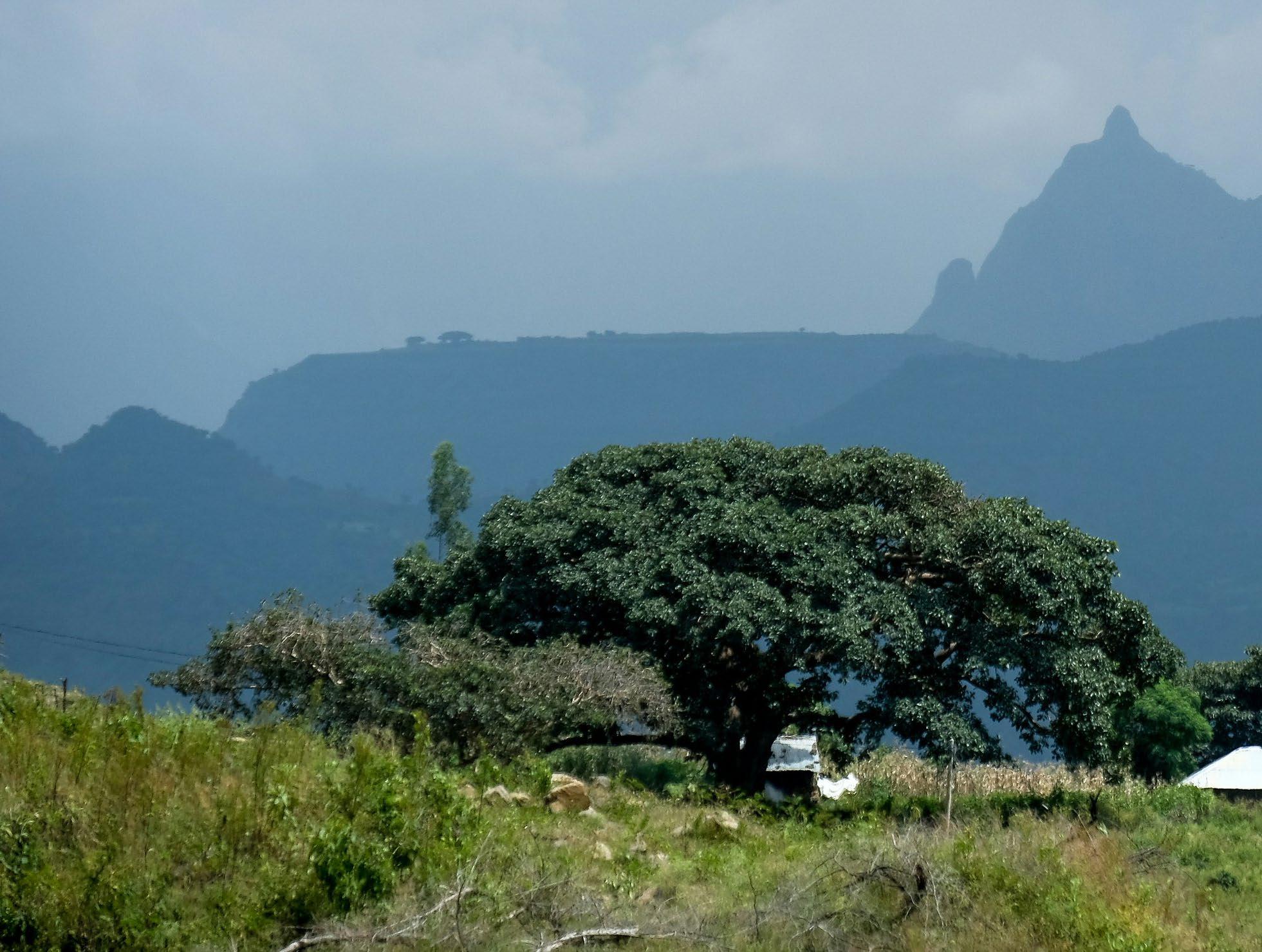
Ethiopia, holder of the world record for most trees planted in a day, is spearheading climate action to catalyze social and developmental transformations. This year, we restricted imports of gas and diesel cars for electric vehicles, boasting one of the greenest power grids globally. With a history of exceeding ambitious commitments, Ethiopia actively fulfils the goals of the United Nations Framework Convention on Climate Change (UNFCCC), the Paris Climate Change Agreement, the Agenda for Sustainable Development, and Agenda 2063: The Africa We Want. We remain dedicated to sharing success stories about our green legacy with the world, emphasizing our ongoing commitment to progress.
The Green Legacy initiative, launched
by Prime Minister Abiy Ahmed in 2019, represents our resolute effort to combat deforestation, reverse land degradation, and promote reforestation and afforestation nationwide. Beyond its impact on climate change, this initiative has directly helped alleviate poverty, enhance food security, and bolster economic development. By mobilizing over 20 million Ethiopians, we’ve created green jobs in forestry and related industries that have further stimulated economic growth while empowering local communities to become stewards of their natural resources.
With an expanded target of 6.5 billion new tree seedlings this year alone, this initiative transcends symbolism, serving as a tangible manifestation of Ethiopia’s dedication to mitigating climate change
and safeguarding its natural heritage for future generations.
One of the key objectives of the UN FCCC is to stabilize greenhouse gas concentrations in the atmosphere at a level that prevents dangerous human-caused interference with the climate system. With this initiative, we are actively contributing to this goal by sequestering carbon dioxide from the atmosphere and mitigating the effects of deforestation, which is a significant contributor to global greenhouse gas emissions.
Furthermore, the Paris Climate Change Agreement, adopted in 2015, aims to limit global temperature rise to well below 2 degrees Celsius above pre-industrial levels, with efforts to limit the increase to 1.5 degrees Celsius.

Ethiopia’s Green Legacy initiative aligns perfectly with the objectives of the Paris Agreement by enhancing carbon sinks through reforestation and afforestation activities, which are crucial in mitigating climate change and safeguarding vulnerable ecosystems.
Ethiopia’s Green Legacy initiative is not without its challenges. Ensuring the long-term survival and growth of newly planted trees requires sustained commitment, adequate resources, and effective management strategies. Additionally, addressing the root causes of deforestation, such as agricultural expansion and unsustainable land use practices, remains a complex issue that necessitates comprehensive solutions involving multiple stakeholders.
As the international community gears
Ethiopia’s Green Legacy initiative is not without its challenges. Ensuring the longterm survival and growth of newly planted trees requires sustained commitment, adequate resources, and effective management strategies.
when nations prioritize environmental stewardship and climate resilience.
However, it is also only a piece of the ongoing solution. I call on the global public and private sector to join us to identify, execute and expand efforts to mitigate and reverse climate change for those that are most vulnerable, and then eventually for the rest of the world.
up for the crucial COP24 meeting in Poland, Ethiopia’s green legacy stands as a testament to what can be achieved
In the face of unprecedented environmental challenges, Ethiopia’s Green Legacy reminds us that hope springs from action and that every tree planted today holds the promise of a greener, more sustainable tomorrow for generations to come. It is imperative that we rally behind Ethiopia’s visionary leadership and work together to build a more resilient and prosperous future for all. ■


Welcome to your private island home where magic and memories go hand in hand. Rooted in honoring the Fijian way of life, creating a world community, and preserving the environment - on Turtle Island it’s easy to imagine the world the way it should be.
The Island is powered by solar energy, produce is locally grown, and the accommodations are hand-crafted by Fijian artisans.
With just 14 villas, acres of serene forests and 12 private beaches, Turtle Island serves as an idyllic sanctuary for travelers seeking connection, community, culture, and consciousness.
When we think of paradise we often transport ourselves to a tropical island. A book in one hand and a cocktail in the other, while kicking back on a white sandy beach, inhaling the warm salty air and listening to the rhythmic musings of the beautiful blue ocean.
Islands in the Caribbean Sea, the Quintana Roo coastline in Mexico andpopular beaches along the Florida coast historically have earned the title of paradise.
Along with breathtaking beaches, this region boasts some of the most biologically rich marine environments in the North Atlantic Ocean, which includes extensive coral reefs, mangroves, seagrasses and thousands of species of fish and marine mammals. Each year, millions of visitors descend with the dream of enjoying a pristine environment, ripe for rest, relaxation and recreational sports such as sailing, fishing, snorkeling and diving.
However, since 2011 these precious coastal regions have come under threat from a 20 ton sea menace!
First noted by Christopher Columbus in 1492, the Sargasso Sea is the largest region of the North Atlantic Ocean, with an area of about 3.5 million km2. Sargassum, a brown pelagic macroalgae, or seaweed, has historically thrived in healthy quantities in the Sargasso Sea. It has provided critical support for a myriad of commercially viable, endangered and endemic marine species such as whales, sea turtles, frogfish, shrimp, tuna, swordfish and marlin. With a vibrant ecosystem, and an array of flora and fauna, the Sargasso Sea has been referred to as the “Golden Rainforest”. Because of its important biodiversity, the Sargasso Sea is protected by the Hamilton Declaration and overseen by the Sargasso Sea Commission.
To the bewilderment of everyone, in 2011 satellite imagery from NASA showed an explosion of sargassum growth in a new southern geographical location, creating what is widely referred to as, the Great Atlantic Sargassum Belt, or the GASB. Floating more than 5,000 miles from the west coast of Africa through the Caribbean Sea and into the Gulf of Mexico, the GASB is the largest and reportedly the most harmful algal bloom on the planet! Experts predict that during its most fertile months, the GASB contains an average of 20 million tons of toxic matter and it has caused a range of environmental, economic, and social problems, with implications for coastal communities, tourism, and marine ecology.
While the exact culminating factors that spurred the initial development of the GASB remain a subject for discussion, contributing factors that aid in the continued proliferation of sargassum have been identified as:
• Nutrient Influx: Agricultural runoff from the Congo, Amazon, Orinoco and Mississippi rivers.
• Dust from the Saharan Desert.
• Upwelling of nutrient dense water from the deep sea.
• Changes in natural ocean currents and wind patterns have pushed sargassum into areas where it was previously uncommon.
• Climate change provides an abundance of sunshine and warmer ocean temperatures are thought to facilitate the rapid growth of sargassum.
The GASBs magnitude causes migratory interference for native and non-native fish populations. Fisherfolk may find their regular catch is no longer plentiful or
available, while new varieties of fish and marine species may migrate into the area. Dr. Shelly- Ann Cox, Fisheries Officer, Barbados, notes that while there has been a decrease in flying fish and mature dolphin fish in Barbados, they’ve seen an increase in juvenile dolphin fish and small lobsters, which are normally uncommon.
Floating sargassum mats block essential sunlight, which is necessary for the healthy growth and development of coral reefs, seagrass and sea moss beds, and mangrove forests. These reefs, beds and forests not only help to shore up coastlines; they provide habitats for a myriad of marine species and aid in capturing carbon from the atmosphere.
Arriving seemingly overnight and smothering beaches at an accelerated rate, sargassum’s arrival requires a rapid response as decomposition begins within approximately 48 hours of making landfall. As it decays, sargassum changes the pH level of the water at the shoreline. Dr. Brian LaPointe, Research Professor at Florida Atlantic University’s Harbor Branch Oceanographic Institute, has been studying the changes and states that the resulting nitrogen/phosphorus imbalance causes additional stress to coral reefs and can lead to coral bleaching. “Dead zones” where decomposing sargassum sucks oxygen from the water are also common, leaving native plants and marine life struggling to survive. Sadly, it doesn’t stop there. Six of the seven sea turtle species are on the endangered species list and all are found in this region of the North Atlantic Ocean. Nesting sea turtles may have to travel miles to find a clean beach to lay their eggs, and incubating eggs are at risk of being crushed during beach clean-up. The sex of incubating sea turtles also may be altered, as sargassum strandings can change the temperature surrounding the eggs, a determining factor in the sex of the embryo.
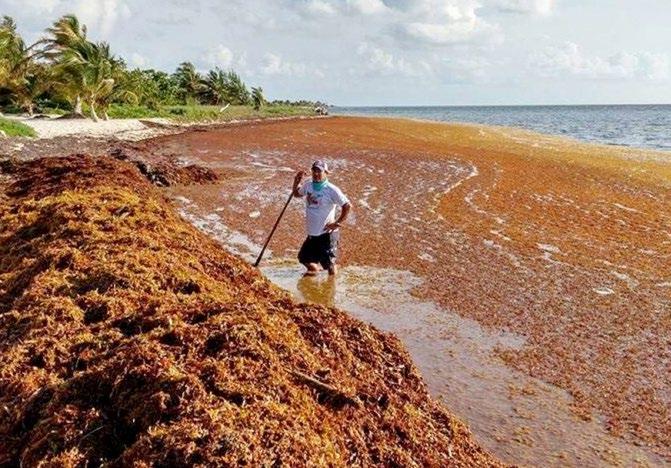
Once hatched, the journey out to sea and safety is thwarted. Hatchlings are at increased risk from sun exposure, disorientation and predators, as they inchmeal across mounds of washed up sargassum trying to make it to the ocean and safety.
As the GASB makes its 5,000+ mile journey, it absorbs carbon dioxide from the atmosphere, and toxins and heavy metals such as lead, arsenic and cadmium from the ocean. This is a favorable side effect, but sadly, collected sargassum is then often dumped on land in deep landfills. Further research has to be done, but this common practice raises the question of whether the potential now exists for these toxins and heavy metals to seep into the local groundwater.
Dr. Brian LaPointe, Research Professor at Florida Atlantic University’s Harbor Branch Oceanographic Institute, works with several islands across the Caribbean. He shockingly states, “they have literally
taken the beach to the dump”. This is not an exaggeration, heavy machinery, such as bulldozers, used over several years to remove sargassum, have caused extensive beach erosion. The loss of shorelines have lasting impacts to tourism, recreational activities and, of course, causes the natural loss of coastal habitats and can lead to flooding. Arriving seemingly overnight and smothering beaches at an accelerated rate, grown men can almost get lost in it. Removal needs to take place rapidly as decomposition begins within approximately 48 hours of sargassum making landfall. As it rots, it releases hydrogen sulfide, which has the unmistakable stench of rotting eggs, ammonia and methane, which cause impacts to human health and adds to greenhouse gas emissions. Tourists and local residents have reported an increase in headaches, nausea, rash, upper respiratory irritation, sneezing and an inability to concentrate. Dr. Dabor Resiere, Intensive Care Unit, University Hospital of Martinique, has been the lead author of several papers citing the potential for even more serious medical conditions such as cardiovascular, ocular and neurocognitive symptoms with prolonged exposure to hydrogen sulfide and ammonia. →
With a vibrant ecosystem, and an array of flora and fauna, the Sargasso Sea has been referred to as the “Golden Rainforest”. Because of its important biodiversity, the Sargasso Sea is protected by the Hamilton Declaration and overseen by the Sargasso Sea Commission.
→ Local residents have also complained of mental health stresses, as they are plagued with insomnia and are no longer able to enjoy their natural resources. A family day at the beach is hampered by the fly-infested mass on the beach, brown sludge at the shoreline and the unmistakable stomach turning stench. The corrosion of electrical appliances such as fridges, microwaves, AC units and jewelry have also been reported and are attributed to the off gassing of the decaying sargassum.
In 2015, the government of the Quintana Roo state of Mexico, hired 5,000 day laborers, working in four-hour shifts, to remove seaweed from more than 100 miles of beach. In tourist-haven Cancun, workers raked approximately a half-million cubic feet of seaweed which amounted to more than 1,000 truckloads.
“The greatest single threat to the Caribbean economy I can imagine”, Hilary Beckles, Vice Chancellor, University of the West Indies said on the issue of the sargassum influx.
According to the World Travel and Tourism Council’s 2019 report, the Caribbean is ranked as the most tourismdependent region in the world, with eight out of the ten most tourism-dependent countries located there. In 2022, $37.5 billion was reportedly generated from tourism alone. Tourism is the lifeblood of the Caribbean and with these statistics, it is not difficult to conclude that if tens of millions of visitors can no longer enjoy their vacations, over time the potential exists for a massive loss in tourism revenue with far-reaching, and potentially catastrophic results.
On a local, and much more personal level, fisherfolk will continue to experience a strain on their financial stability with:
• Fewer overall days at sea.
• Changes in available catch.
• Difficulty getting their boats through the sargassum mats.
• Increasing cost of repair to their boats and fishing gear because of sargassum damage.
Research is being conducted by the educational and scientific community, and a few private-sector companies are racing to develop solutions for valorization and

mitigation. Solutions being discussed include:
• Collect sargassum while it’s at sea. A costly endeavor, but one that mitigates beach erosion and several other issues associated with decomposing sargassum after it makes landfall. There are several companies that have developed specific boats, or re-engineered fishing boats, for open-sea sargassum collection.
• Remove sargassum from beaches by hand with rakes and carts, which reduces beach erosion and protects coastal ecosystems. This also provides employment opportunities for local residents.
• Remove harmful nutrients, then sink sargassum deep into the ocean. This sequesters carbon in the deep sea for hundreds, if not thousands of years. However, this also leaves questions about how this practice might impact the deep sea over the long run.
• Develop safe and sustainable onshore methods for storage and disposal.
• Valorize sargassum by repurposing it for industrial or cottage industry use, i.e. biofuel, plastics, fertilizer, paper and construction materials, such as bricks.
• Fund further research into the true root cause of the phenomenon to better understand the threat.
• Engage and hold accountable, specific countries and entities, whose practices aid in the development of the GASB.
• Anchor mesh barriers offshore to prevent sargassum from reaching the beaches, thus allowing safe collection out at sea.
• Implement wide use of SaWS - Sargassum Warning System, a system using data from NASA and developed by one of sargassum’s leading researchers, Dr. Chuanmin Hu, Professor, University of South Florida, to better prepare for major influxes.
Without doubt this is a geo-political issue involving nations on the African and South American continents, the United States, Mexico and independent Caribbean nations, as well as the Caribbean territories of countries of the European Union.
Experts agree that the The Great Atlantic Sargassum Belt isn’t going anywhere for the foreseeable future. Therefore, innovation and financial aid to support sustainable clean up, disposal and repurposing efforts are vital to help preserve the region’s future and to avert further crisis. Of the seventeen SDGs established by the United Nations, the impact of the Great Atlantic Sargassum Belt relates to at least seven, and thankfully the UN is working through the UNEP and UNDP across the region on the issue, but more needs to be done. It is critical that all stakeholders are engaged, these include:
• International governments, including those involved with the G7, G20 and COP
• Regional governments
• Tourism industry
• Scientific and educational communities
• Environmental agencies
• Private sector
• Local residents
Ultimately, we are one interconnected and interdependent global community, and therefore a menace to one, is a menace to all.
The author, Jenny Latchman-Atkins, is of Caribbean descent. She is passionate about exploring the effects of the Great Atlantic Sargassum Belt and has written a featurelength documentary “Sea Menace”, to explore the four pillars of impact: Ecology, Environment, Public Health and the Economy. To meet Jenny and hear more about the topic, watch the Sea Menace Sizzle Reel. ■
To support the making of this film, please contact her directly at jennyla@goodgoblinproductions.com

Brunnbäck is a small community with about 23,000 inhabitants located in the southeast of Avesta, a municipality in Dalarna province in Sweden. Brunnbäck is a beautiful place up on the hill with forest and the big Lake Dalälven that stretches 541 km.
In 1521, there was a historic battle between Sweden and Denmark (War of Liberation 1521-1523) where Sweden won over Denmark. This was a massive victory for Sweden and Gustav Vasa. At Brunnbäck, there is a big Stone as the symbol for the 1521 victory, and the people can go there and read this historical memory on site.
Hence the name of this historic Water from Brunnbäck and where our Water is coming from. 16th May 2023 it has been 500 years since the historic battle was in Brunnbäck Sweden , in this day 16th May the Swedish army hold a ceremony in Brunnbäck to the memories.
“ Today’s Sweden was born at Brunnbäck “ - Börje Forslund.
The Water is approved by the Swedish Livsmedelsverket, a Report issued by
Accredited Laboratory and Eurofins with a pH 7.8, and minimal with salt in the water. It is a Quality water and one of the best in Sweden.
My name is Rickard Nilsson. I’m 37 years old, and I am the CEO & Founder of Brunnbäck Sweden Natural Mineral Water AB. I was born and raised in Avesta and live 2,5 miles from

Avesta now with my family.
I founded Brunnbäck Sweden Natural Mineral Water AB on February 20th, 2022. We are growing slowly but at a good pace. We are marketing a lot and we are been seen in DAZN streaming Service with Brunnbäcks collaborations with Muay Thai For Life Gala, among many other things. My vision is to start selling this fine Water worldwide, and I will also focus on helping vulnerable people who need Water by donating at least a million litres of Water each year to them.
We need to start rethinking and doing the right thing other than profitability. The earth and we as a species must start working together and contribute to a better world on all fronts, such as storage, solar energy, and transport. Switch to Green Energy, but it must be allowed to take time and don’t make a quick decision.
After a while, we will see that the decision to take time was wise; however, we still need to move fast.So we need to take a decisive conclusion.

Our water Factory will be 100% powered by solar energy, and our Water will be transported and distributed to our customers by electric trucks or vehicles. We are going to sell our Water in Pet and glass bottles, but we are looking for better options for bottles and labels.
We will focus very much on making everything much better for the environment. If you who read this article feel and think like me that you want to make a difference in this world, I am looking for the right investment partners to help me start to build the Factory and sell this quality water worldwide.
I plan to launch the products to the market in Q4 2025. I want to invite my future investment partner to come to Sweden and Brunnbäck, and I will show you the location and the plans.
So you are most welcome if you are likeminded to me. I have had this vision/ call since 2013, and now is the right time to put Brunnbäck Sweden on the world map and help a better world. ■


In the vast expanse of our planet, where land meets sea, an extraordinary musical odyssey unfolds—a powerful harmonization of melodies and the secrets of the deep. Sounds of the Ocean, an immersive experience that combines marine life sounds, original music, poetry, dance, and visual art, grants its audience members a deeper connection with the ocean and marine life. This captivating fusion is not merely a testament to human creativity; it’s a vital call to action for preserving the oceans, Earth’s lifeblood. In this in-depth exploration, we venture into the heart of this revolutionary endeavor, guided by the visionary artist whose passion for music and ocean conservation has ignited a global movement.
The journey of our protagonist, the driving force behind Sounds of the Ocean, commences with a childhood steeped in musical curiosity. From an early age, Miller was filled with an unbridled curiosity to make sounds. He studied clarinet in the United States public school system where he realized that music had the ability to foster a sense of community and transcend verbal communication. Simultaneously, a deep connection with the ocean emerged during family vacations. Both of his parents were avid divers and during those family scuba diving trips Miller found a sanctuary of peace and serenity under the waves. These dual passions of music and
the ocean have since become the driving forces in Miller’s life, but it took going through a difficult time for his two passions to coalesce.
After witnessing the destruction of the ocean, the artist rekindled his relationship with music and discovered its therapeutic power. Miller explained, “It was during a transformative concert that the fusion of healing melodies and marine sounds came to be after a discussion with Dr. John Ryan, an eminent researcher from the Monterey Bay Aquarium Research Institute.” This encounter became the genesis of Sounds of the Ocean—a transformative auditory experience designed not merely for entertainment but as a therapeutic escape and a clarion call for conservation.

Sounds as Catalysts: The Power of Music in Conservation
The marriage of music and oceanic sounds is no arbitrary union; it is a deliberate choice rooted in profound psychology. Sound, as a medium, possesses unparalleled power. Through the artful composition, the audience is transported into the marine realm, where whales serenade, and dolphins dance. As Miller says, “When do we get the chance to be face-to-face with a humpback whale? For most of us, this will never happen. Our productions are designed with this in mind, to simply allow the audience to feel as-if the whales and dolphins are right in the room with us and we are swimming alongside these beautiful creatures.” This deep connection fosters empathy and

The impact of Sounds of the Ocean extends far beyond concert halls. Collaborations with a multitude of nonprofit and forprofit environmental organizations have fortified their mission. Esteemed partner, everwave, exemplifies the collaborative spirit.
understanding, stirring the very core of human consciousness. Studies have shown that such immersive experiences trigger profound emotional responses, nurturing a sense of responsibility and encouraging proactive conservation efforts.
The impact of Sounds of the Ocean transcends the boundaries of traditional conservation campaigns. At the heart of their immersive experiences lies a dual purpose: to inspire the audience by the wonders of the ocean and to mobilize them into action. World Oceans Week 2022 witnessed Sounds of the Ocean echoing through the streets of New York City, resonating with climate activists and conservationists alike. Even seasoned environmental advocates, deeply familiar with the challenges our oceans face, were astounded by the immersive experience, broadening their understanding of marine life and emphasizing the urgency of preserving the oceans’ tranquility and purity.
The impact of Sounds of the Ocean extends far beyond concert halls. Collaborations with a multitude of nonprofit and for-profit environmental organizations have fortified
their mission. Esteemed partner, everwave, exemplifies the collaborative spirit. Their innovative approach involves removing plastic from rivers before it reaches the ocean, a proactive step in mitigating plastic pollution. Sounds of the Ocean patrons actively contributed to this cause, with every ticket sold ensuring the removal of 1 kg of plastic waste from rivers in Southeast Asia.
In addition to their collaboration with everwave, Sounds of the Ocean partners with organizations like Oceanic Global, known for organizing world-class events prioritizing the ocean, including World Oceans Day at the UN Headquarters in New York City. In collaboration with WHAIA of the Wisdom Keepers Delegation, Sounds of the Ocean proudly supports indigenous stewardship of the ocean.
Furthermore, Sounds of the Ocean collaborates with Whale and Dolphin Conservation (WDC), an organization that pioneers programs emphasizing the interconnectedness of marine life and the urgent need to protect it comprehensively. WDC offers various initiatives, such as protecting whales from ship collisions and providing people with the opportunity to adopt a whale, thereby defending marine habitats effectively. →

The immersive presentations crafted by Sounds of the Ocean are not mere performances; they are meticulously designed experiences, strategically weaving sounds and visuals into a tapestry of emotion. The integration of technology to support mental wellness has been at the core of Miller’s work when he created Embodied Sounds in 2019. Embodied Sounds creates original music to support a collective wellbeing by building connection with the natural world through sound. Miller and his team believe that technology works handn-hand to build a healthy connection with nature. They started to offer immersive sound installations that use a combination f headphones and vibrational cushions which allows participants to tune out any background noise and feel the power of sound throughout their bodies. The immersive sound installations can be part of a live performance or a standalone listening session that supports rest, relaxation and a deeper connection with the element of sound. Through binaural immersive audio, spatial sound, fulldome projections, and wireless headphones, technology is harnessed not as a distraction but as a bridge connecting humanity with nature. The fusion of art and technology is not just a creative endeavor; it’s a
gateway to fostering environmental consciousness and inspiring collective action. Sounds of the Ocean’s impact is evident from several personal anecdotes from past participants. Miller will always remember one performance where they had a child with cerebral palsy attend a concert and it in his wheelchair in the front row. After he concert, the child’s parents came up to Miller and told him that they had never seen their son so animated and joyful as he was when getting to listen and see the whales. While this heartwarming story shows the personal impact of Sounds of the Ocean, Miller is looking into delving deeper into the physiological and neurological effects of their immersive experiences. This qualitative feedback from testimonials and reviews helps their understanding of the audience’s response, enabling them to refine their presentations continually.
Climate advocacy, especially related to oceans, demands unwavering dedication. The complexities of environmental issues, coupled with skepticism and indifference, pose formidable obstacles. Sounds of the Ocean addresses these challenges through mindful activism, embracing diverse perspectives while nurturing a collective sense of responsibility. Their approach is not confrontational but inspirational, gently urging individuals to introspect and consider small yet impactful changes in their lives.
Miller explains, “As we peer into the future, Sounds of the Ocean is poised on he precipice of innovation.” Their foray into augmented reality, set to debut in an upcoming app, promises to revolutionize immersive experiences further. Miller states, “By integrating AR technology, the audience will have the unprecedented opportunity to interact with marine life virtually, deepening their connection with the ocean and fortifying their resolve to protect it.”
In closing, the message from Sounds of the Ocean resonates like a sonorous hymn—a call for action echoing across continents. Preserving our oceans is not a choice; it’s an imperative. As the CEO of Whale and Dolphin Conservation, Chris Buttler-Stroud, astutely noted, “our planet’s delicate balance hinges on restoring ecosystems and reviving dwindling animal populations. Every rainforest needs its jaguars, every ocean its whales. By supporting initiatives like Sounds of the Ocean, individuals can become stewards of this delicate equilibrium.”
When individuals are moved by a powerful performance or a moving piece of art, they are more inclined to engage in proactive efforts. Sounds of the Ocean, by immersing audiences in the beauty of marine life, inspires action by encouraging people to support conservation organizations, participate in clean-up initiatives, and make sustainable lifestyle choices. In essence, activism through the arts is a catalyst for social change. Initiatives like Sounds of the Ocean not only amplify the urgency of environmental conservation but also empower individuals to become advocates for the planet. By harnessing the transformative power of art, these activists ignite a collective passion for a more sustainable future.
The ocean, spanning over 70% of our Earth’s surface, is not just a repository of life; it’s our lifeline. To safeguard it is to safeguard our very existence. The path forward is clear—reduce plastic consumption, engage in local clean-up initiatives, and support organizations dedicated to ocean conservation. Join the symphony for conservation, be part of the movement, and together, let’s ensure that the melodies of the ocean continue to echo through generations, inspiring awe, respect, and action. ■
































































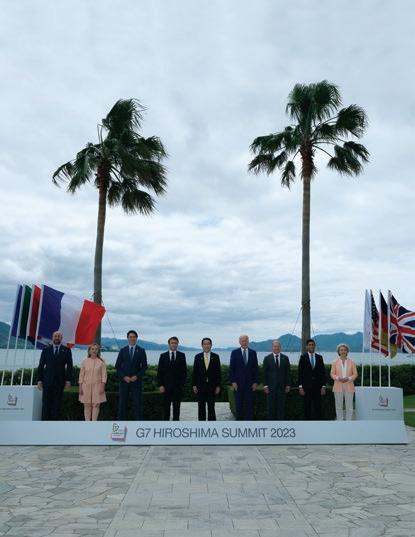
With beads of sweat running down his face under the hot Southern California sun, Mark Trebilcock struggled with the hard-packed clay soil and uneven slope on his hillside.
No matter what he did to grow the fruit trees and plants he wanted, the only thing growing in his yard were weeds and his aggravation. The soil erosion and inability to keep water at the roots were the main culprits. He had tried multiple store-bought products to mitigate the erosion and keep the plants hydrated, but nothing worked until he created a prototype in his garage that he began to test out on his yard. His prototype was
the first version of the Dirt Locker®, a hillside terracing device that saved water and stopped the persistent erosion. The Dirt Locker® can also reduce agricultural waste, plant mortality, labor for terracing or maintenance, and consumes waste plastics through recycling. When traveling in East Africa Mark saw the need for an agricultural product to help people grow their food in inhospitable terrain. During his trip through Rwanda and Uganda, Mark began to seriously consider the possibility of developing an international network for the Dirt Locker®, knowing that it could help
mitigate problems like plastic pollution, land availability, and unsustainable agriculture. He learned that in Rwandan culture, it is customary for families to subdivide the property to the children, generation after generation, inevitably leading to less land to a farm which creates a food problem when they are not able to grow enough to feed their families. In addition to the overpopulated land, non-farmable slopes, and erosion deteriorating the little remaining land, Rwanda has become dependent on outside sources for food instead.
He saw an even more dire situation when he went to Haiti as a volunteer

of Love A Child (www.loveachild.com). This organization has provided help to Haitians in job creation, healthcare, orphanage services, and teaching them agricultural methods. Sadly, deforestation appeared to be the root of many of the island’s issues, which have reduced rainforests to deserts, preventing life on land. Consequently, the soil runoff has also negatively impacted aquatic life. Early in the process development phase, Mark sent several DirtLocker kits to Haiti. There is a hope that they may be part of the revegetation solution for this impoverished nation once deployed.
The comments and feedback from expert landscapers bolstered his confidence to move forward. It seemed like a no-brainer that a product that converts non-arable land into a productive growing environment using scrap plastic had a commercial market. Over the years, Mark continued to tinker and improve the design. He had an opportunity to work on the product full time. He knew this was his opportunity to commercialize the Dirt Locker®.

Mark created a new configuration of the Dirt Lockers® where the pieces could be connected into a network that could be folded flat for ease of transportation and storage. The folded units can be pulled up onto a hillside and expanded out like an accordion. The expanded network is a collection of cells, where each cell is a flat terraced growing area used for growing plants or walking/maintenance access on the hillside once backfilled with soil.
The newly formed matrix of terraced cells created by the expanded Dirt Locker® system significantly reduces erosion by retaining water on the hillside for the plants while also maintaining the topsoil. This network of basins acts like a gravity-fed water filtration system that holds the soil while allowing excess water to cascade over to the next cell. The arrangement solves multiple environmental issues such as soil erosion, water use, rainfall/ agricultural runoff, the high mortality rate for plants on hillsides, and pollution since they are 100% recycled plastic. Finally, the connecting hardware was eliminated, further simplifying the assembly/installation process.
Raised in Miami, Florida as a teenager, Mark had a passion for gardening and growing food primarily due to his mother’s love for the same and her interest in unique fruit trees. His interest led him to start a small landscaping business although he had to transport his equipment by bicycle, sometimes miles away. The logistical obstacles he overcame as a young
entrepreneur motivated him to conceive and implement product/ process improvements. It seemed natural to pursue a degree in Industrial Engineering and Management Systems from the University of Central Florida.
Mark maintained his love of landscaping throughout the years, always trying to find solutions to gardening problems. He eventually left the flatlands of Florida and moved to California, where he continued pursuing his passion for gardening and his career in manufacturing excellence for medical devices. Mark’s passion for horticulture and landscaping hit a wall when attempting to grow on the arid, clay slopes of Southern California. It became clear that many people, homeowner associations, farmers, and gardening enthusiasts struggled to produce on slopes.
The creative problem-solving methods Mark developed that generated production efficiencies during his years in the telecom, medical device and biopharma industries were employed when Mark was learning how to grow in the mountainous, water starved, hardpacked rocky clay soil in Southern California. The current Dirt Locker® was born after several iterations on that original prototype, and years of evaluating materials, testing, trial, and error. After his experiences internationally, it became vitally important to Mark that the Dirt Locker® was developed so that it requires no special hardware, tools, or skills to assemble and/or install.
ENGINEERING
The product was developed so that the pieces can connect manually with no additional proprietary hardware. Additionally, regardless of its configuration, there is only one SKU in each assembly. Whether the product is assembled into a network of hundreds of pieces, or a ring for an individual plant, only one SKU is used. The only hardware used with the Dirt Locker are commercially available or easily fabricated rebar J-hooks for securing the network to the hillside during installation. The only tools required for installation are common to any landscape project. → BOTH THE MATERIAL SELECTION AND DIRT LOCKER® DESIGN
→ In addition to the simple assembly process, the Dirt Locker® is environmentally beneficial and safe to work around.
The Dirt Locker® is ecologically friendly in several ways, but at its core is constructed from 100% recycled, post-consumer waste, high-density polyethylene (HDPE). The Dirt Locker® is also food-friendly because HDPE is one of the few plastics approved by the FDA for food storage and preparation. As an example of the positive environmental impact, each Dirt Locker® saves on average the equivalent of 13 milk jugs from the landfill or oceans. In addition, the Dirt Locker® helps recover nearly 100,000 milk jugs monthly. The recycled plastic used in the fabrication of the Dirt Locker only adds to the environmental benefits while in use.
The overall efficiencies to the end-user are that the product does not require any special training, tools, or skills to use. Those efficiencies can help the user convert otherwise non-arable sloped terrain into terraced and agriculturally productive hillsides. In addition, the Dirt Locker® does not need the same labor intensity, infrastructure, or cost to install than traditional terracing methods require.
Having developed a product easy to manufacture and assemble, Mark was ready to launch the Dirt Locker® commercially in 2018. The product’s demand has grown exponentially, even though marketing is limited to YouTube videos, the www.dirtlocker.com website, Facebook groups, and word of mouth. Our customers have consistently bestowed generous compliments on the product and sales team. In addition, customers routinely comment on the ability of the Dirt Locker® to support the growth of plants in areas where they had previously been unsuccessful. Here are a few of the comments:
Bob B. Thousand Oaks CA: The product saved me 70% on my project over traditional solutions and looks better and will save water and plants.
Adam MD. North Carolina: Everyone in the neighborhood thinks the lockers are brilliant.
Thanks for all of your help!
Srinivas, Georgia: Thank you so much for the detailed response, the wonderful invention, and the service.
Gillian, Canada: I LOVE this product.
Deborah, Puerto Rico:
We will be planting more coffee plants inside of the next set of some Dirt Lockers®.
Dan G. Fallbrook CA:
I came across your product, and it is exactly what I need!
As demand for Dirt Lockers® grew throughout the United States and internationally, the machine used to manufacture the Dirt Locker® in Mark’s garage could not keep up. So Mark expanded his manufacturing capacity by reaching out to his plastics supplier. They had the experience and manufacturing capacity to keep up with demand. They also had the experience with the plastic so there would be no learning curve. Outsourcing manufacturing of the Dirt Locker® proved there are new prospects for the product, including manufacturing the product closer to the point of use, thus reducing carbon footprint through transportation efficiencies.
The Dirt Locker® went from concept to reality first with a scaleddown version using a 3D printer with the help of an online CAD program that allowed the interlocking terrace concept validation on a small scale. The scale models demonstrated the effectiveness of the Dirt Locker®, enhancing Mark’s conviction to create a fixture used with hand tools to fabricate the first functional full-scale units. The assembled “handmade” units made networks at his house in California and at his mother’s residence in Florida. These initial installations proved that the product was beneficial and worked as expected.
The first large Dirt Locker® project made from 300 Dirt Lockers® was pulled onto a hillside and backfilled with soil in one day. Mark enlisted the
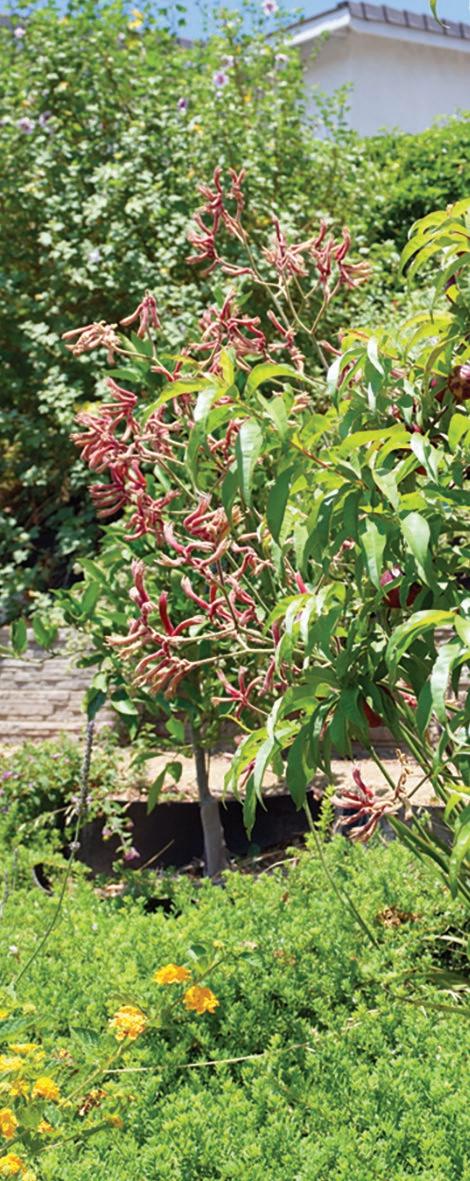
help of a local landscape company and entrepreneur and filmmaker Jon Schneider who created a multiple video of the entire installation and a local landscape company. Jon has since created a library of YouTube videos used for demonstrating the capabilities of the system and as instructional aids for the Do-It-Yourself installer. The five workers quickly assembled most of the 300 units in about 45 minutes after only 15 minutes of instruction.
The completed web of DirtLockers initially folded neatly on the sidewalk at the bottom of the hill was quickly expanded up the slope until it covered the face of the hillside. Next, the crew began attaching the final pieces where

the contour of the hillside warranted, and before lunch, the network of cells was getting backfilled with improved soil. With the cells filled, the individual terraces could now be safely traversed by workers, facilitating the planting process. The benefits of hillside access using the Dirt Lockers is both demonstrated and succinctly stated in the testimonial by customer Stormy C. on the Dirt Locker® YouTube channel.
“Something that the retention wall doesn’t have is steps with an option to walk up and have to access the plants. You are still going to have weeds and overgrowth that need to be maintained.” Stormy C. CA Once planted, the Dirt Locker®
terraced hillside flourished.
Approximately six months after planting the hillside, Mark’s neighbors, recalling the bleached lifeless slope, now commented on how much they appreciated its beauty and the enjoyment it brought to their daily walks. During the summer, when temperatures are frequently triple digits, the containment properties of the Dirt Locker® allowed water to penetrate deeper into the hillside, which helped the soil stay hydrated longer. The enhanced soil hydration encouraged the plants to flourish, improving the strength and stability of the slope with time, this was stated most poignantly by customer Karl B. of New York below.
THE DIRT LOCKER® WENT FROM CONCEPT TO REALITY FIRST WITH A SCALED-DOWN VERSION USING A 3D PRINTER WITH THE HELP OF AN ONLINE CAD PROGRAM THAT ALLOWED THE INTERLOCKING TERRACE CONCEPT VALIDATION ON A SMALL SCALE.
“A standard retaining wall is the strongest it will ever be on the first day that it is completed, whereas the Dirt Locker® system gets stronger over time as the plants root into the dirt which is what makes it strong. It’s a complete eco-system of plantings nd the Dirt Locker system that work together to hold back the hill.”
Karl B., NY
Mark worked tirelessly in all Dirt Locker’s® design, testing, installation, and manufacturing phases until he was ready to share it with the world.
His brother Norman, the owner of Trebilcock Consulting Solutions (TCS), a civil engineering firm in Naples, Florida (www.trebilcock.biz ), had some of his engineers help Mark with drawings and product evaluation. While developing the Dirt Locker® using different manufacturing methods, it was always evaluated for manufacturing in areas with the same availability to technology or skilled workers. For instance, in some geographies, complex machinery may not be realistic. However, a fixture and hand router are possible, especially when the pay rates permit labor-intensive industries allowing the Dirt Locker® to move manufacturing to new regions where it makes economic sense. We have only begun to realize all the benefits of this disruptive technology yet easily applied product. Our objective is to work with professionals globally to find other uses, benefits, and potential enhancements to the Dirt Locker®.


In our fast-moving world, two terms are always in the headlines: Digitalisation and sustainability. Both are not just trends, but also decisive factors that will shape our future. In the world of finance in particular, artificial intelligence (AI) and blockchain play a central role in promoting sustainable finance. But how exactly does it work?
Artificial intelligence and sustainability
Artificial intelligence, often simply referred to as “AI”, is a field of computer science that enables machines to mimic human-like thought processes. In the financial world, AI can be used to identify investment opportunities that are both profitable and sustainable. With the help of AI, banks and financial institutions can analyse huge amounts of data and find out which companies and projects offer the best opportunities to generate both financial profit and a positive impact on the environment and society.
Blockchain: more than just cryptocurrency
When people hear about blockchain, the first thing that comes to mind is Bitcoin or other cryptocurrencies. But the technology behind these digital currencies has the potential to go far beyond finance. Blockchain generally helps to bring transparency and trust to the financial sector by ensuring that every transaction is verified and immutable. This can be particularly useful when it comes to ensuring that investments are actually sustainable.
Why is this important?
The world is facing numerous challenges, from the climate crisis to social injustice. As the interface between investors on the one hand and capital recipients on the other, the financial industry has an important steering function and therefore the opportunity to exert a positive influence on these problems by investing in sustainable
projects and companies or launching corresponding products on the market. At the same time, digitalisation offers the tools to make these investments more efficient, transparent and trustworthy.
Blockchain and AI: at odds with sustainability?
At first glance, it may seem as if blockchain and AI are at odds with sustainability, especially when you think about the energy consumption of large blockchain networks or the resources required for advanced AI models. At least, this is the argument repeatedly put forward by critics. But in reality, these technologies can help to reduce energy consumption and utilise resources more efficiently. Blockchain, for example, can help to reduce paper consumption by replacing physical documents with digital contracts. AI can be used to analyse energy consumption patterns and make
suggestions to increase efficiency. These technologies are therefore not only compatible with sustainability, but can also help to promote it.
Why courage is needed now
As a banking industry, we are at a crucial point. The world is changing and we need to have the courage to embrace these changes - especially with regard to blockchain and AI. It’s not just about moving with the times, but also about offering our customers real added value. By integrating these technologies into our core business and developing new products, we can offer more efficient, secure and transparent services. Even though we are still at a very early stage and many things need to be tried out and experimented with blockchain, tokenisation and AI first, this is not just a gimmick - it shouldn’t be - but an investment in the future. Of course, courage also requires a willingness to invest in these technologies and take the risk of making mistakes. But only through such courage and the acceptance of mistakes as learning opportunities can we grow and develop as an industry.
Role and stance of the LBA
Digitalisation and sustainability are the two core pillars of our banking centre strategy, Roadmap 2025. We are deeply convinced of the importance and potential of increasing digitalisation and sustainability as well as digitalisation for sustainability. However, this is not easy, does not happen overnight and, of course, we want to do it “right”. We are therefore in a double transformation phase, so to speak. Why? Because we believe that these two factors have the power to fundamentally change the way we think about money and investments. However, this also means that sustainability and digitalisation are the two key competitive factors and will determine in the medium to long term whether a financial centre, a banking centre or an individual institution will still be competitive at all. In short, we see digitalisation and sustainable financing as the future of the financial sector.
DIGITALISATION AND SUSTAINABILITY ARE THE TWO CORE PILLARS OF OUR BANKING CENTRE STRATEGY, ROADMAP 2025. WE ARE DEEPLY CONVINCED OF THE IMPORTANCE AND POTENTIAL OF INCREASING DIGITALISATION AND SUSTAINABILITY AS WELL AS DIGITALISATION FOR SUSTAINABILITY.
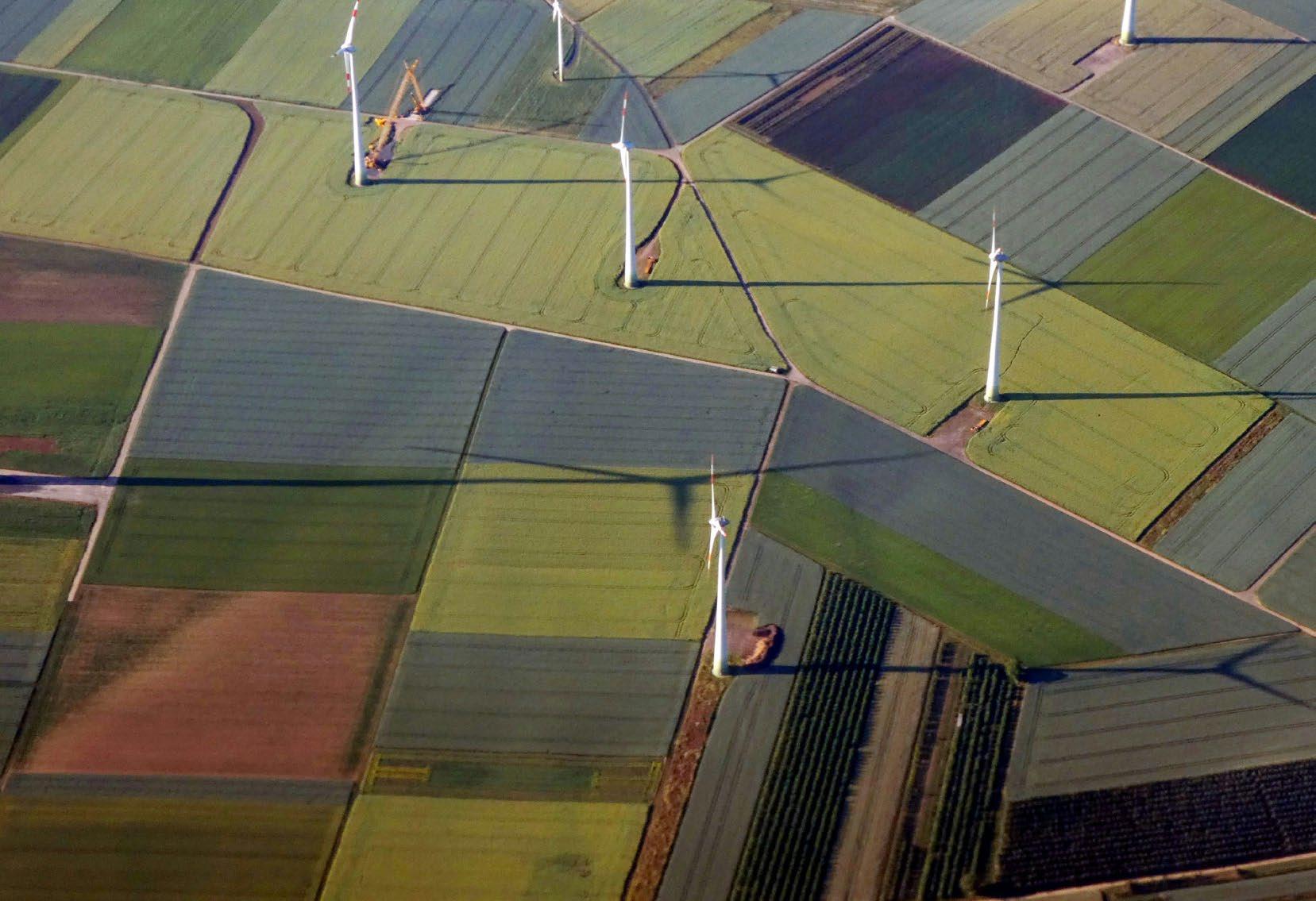
And that is precisely why we are involved in both areas at all levels at the Bankers Association itself and, above all, why we are looking for the connection, because ‘no sustainability without innovation and no innovation without sustainability’. And the same applies to the various projects we have launched in this area over the past 12 monthsfrom the climate-neutral non-fungible tokens (NFTs for short) to the various
About Liechtenstein Bankers Association (LBA)
collaborations in the blockchain and AI sector. These collaborations and projects in particular allow us to learn and experiment.
Overall, AI and blockchain have the potential to revolutionise the way we think about sustainable finance. We want to help ensure that our financial centre is at the forefront of this revolution and that our future is both digital and sustainable. ■
The Liechtenstein Bankers Association was founded in 1969 and is the voice of Liechtenstein banks at home and abroad. It is one of the most important associations in the country and plays an important role in the successful development of the financial centre. As a member of the European Bankers Federation (EBF), the European Payments Council (EPC), the European Parliamentary Financial Services Forum (EPFSF), the Liechtenstein Bankers Association is an important member of key bodies at European level and plays an active role in the European legislative process. Since 2017, the Liechtenstein Bankers Association has also been a member of the Public Affairs Council (PAC) with offces in Washington and Brussels, and since 2018, a member of the international network “Financial Centres for Sustainability” (FC4S). With the Roadmap 2025, the LBA has placed an even stronger focus on the two major topic «sustainability» and «digitalisation». As a consequence, the LBA joined the following two initiatives in 2021, each of which is a leader in its field: firstly, it has become an official supporter of the UN Principles for Responsible Banking and the Net-Zero Banking Alliance and secondly, it has become an affiliate member of the Canada-based Blockchain Research Institute (BRI), an independent, global think-tank dedicated to inspiring and preparing private- and public-sector leaders to be the catalysts of the blockchain transformation.
About LBA’s Roadmap 2025, the strategy for the entire Liechtenstein banking cente
The Roadmap2025 is the multi-year strategy of the Liechtenstein banking centre. It is all about “growth through sustainability and innovation”. Ongoing climate change is one of the greatest global challenges. We are the first generation to sustainably destroy our planet and probably the last to prevent it. The financing needed to achieve the Paris climate goals as well as the broader Sustainable Development Goals (SDGs) of the United Nations is enormous. According to PWC, the annual global investment required to achieve the SDGs amounts to 7 trillion US dollars. Currently, only one seventh of this is financed by the public sector. A substantial part must therefore come from the private sector. The financial sector, and banks in particular, can and must therefore play a central role in mobilising and channelling these financial resources. This means a great responsibility, but also brings with it a great opportunity. If we successfully accompany this transformation, we will create the necessary growth to continue to create prosperity. Increasing digitalisation has a huge potential to accelerate the needed transformation for the benefit of our future generations.
The German national COP28 in Dubai was a hard sell ever since it was announced during the last days of COP27 in Egypt the previous year. The time leading up to COP28 was fraught with stumbling blocks - namely around Loss & Damage, the continued approach to tipping points and a general mistrust of hosting a climate conference in the world’s largest petro-state. Expectations were low heading in and the media - both traditional and social - was apathetic. How could we be heading to Dubai for a climate summit
amidst another record-breaking year for climate disasters?
The short answer is that we cannot abandon the COP process, climate-affected communities need to be heard, represented, and have a place to negotiate their futures. For all the issues that COP may have, it still has an important purpose. International policy is slow and inherently benefits established member states with a vested economic interest. This is not new, but the COP process has slowly eroded this - on the sidelines of the summit you are seeing an
increasing number of representatives from all levels of governance, civil society, and industry from developing nations. Young people, entrepreneurs, seasoned diplomats, activists all side by side - COPs have become more inclusive and accessible, Dubai has been no exception.
Yes, COP28 saw the largest amount of fossil fuel lobbyists of any summit held so far, but it also had spaces like the Youth, CARICOM, and Ocean Pavilions which were important places for discussion, networking, and knowledge sharing.

Stages like the Island of Hope hosted voices from a variety of communities, all of which were keen to work collaboratively towards new goals and finding innovative solutions that could benefit their home nations. These conversations are having a real impact and are not tied to the negotiations happening in the Blue Zone. International diplomacy may be slow, but civil society at a regional level is moving as fast as it can.
Over the past few years, the voices of communities on the frontlines of climate change have become louder, routinely challenging the status quo that has often steered international negotiations. In the Caribbean, Barbados Prime Minister Mia Mottley has led ongoing call for improved climate finance pathways for vulnerable nations, while Grenada’s Simon Stiell’s leadership as the UNFCCC Executive Secretary on back-to-back COPs has seen advancements on Loss and Damage and a vocal support for a phaseout of fossil fuels. The Pacific has also seen its voice amplified in recent COPs. Tuvalu’s Simon Kofe gaining media attention over his address at COP26 held in knee-deep water and his country’s recent plans for digital nationhood, or most recently in Dubai by Samoan head delegate Anne Rasmussen’s interjection following the announcement of a final decision reached without the involvement of members of the Alliance of Small Island States (AOSIS).
This, in conjunction with an everlouder group of young people taking to the conference as observers, negotiators, and members of civil society, is making it harder for the status quo to ignore key climate justice and finance issues. While the text that emerged from Dubai has its set of loopholes and skeptical pledges, it pays to remember that the fruit of negotiations often represent the lowest common denominator rather than a true consensus. If there is a silver lining to take from the somewhat tumultuous ending of COP28 in Dubai, it’s that a shift in the baseline, no matter how small, is still a representation of larger change in the negotiation rooms - but that shift does not define the work already being done on the ground.
Regardless of the wording of the final decision, real progress happens on the sidelines of COP, it is taking place in
climate-vulnerable communities around the world, and it is being led by local stakeholders. Incremental progress is still progress, and it has been compounding ever since COP21 in Paris. Not every summit can yield historic developments like it did in 2015, but it is important that we remember that the legal jargon of COP decisions affects international policy, and we can take action without it - islands have been doing it for a while, as have most other developing economies around the world.
That does not mean we should be complacent about the increase in fossil fuel lobbyists, the slow pace of negotiations, or the political posturing of government leaders constrained by their term limits, but rather, we start to value the developments happening on the fringes of the summit itself. COP’s yearly negotiations are not the end-all when it comes to climate action, we must learn to capitalize on the progress being made elsewhere. We could look to modernize the process by making the summit a year-long process that would not
Regardless of the wording of the final decision, real progress happens on the sidelines of COP, it is taking place in climate-vulnerable communities around the world, and it is being led by local stakeholders. Incremental progress is still progress, and it has been compounding ever since COP21 in Paris.
have the entire focus squarely on one yearly individual event. So let us all continue to call for more ambition and action at an international level, but let’s also celebrate and highlight the developments happening in spite of it. ■
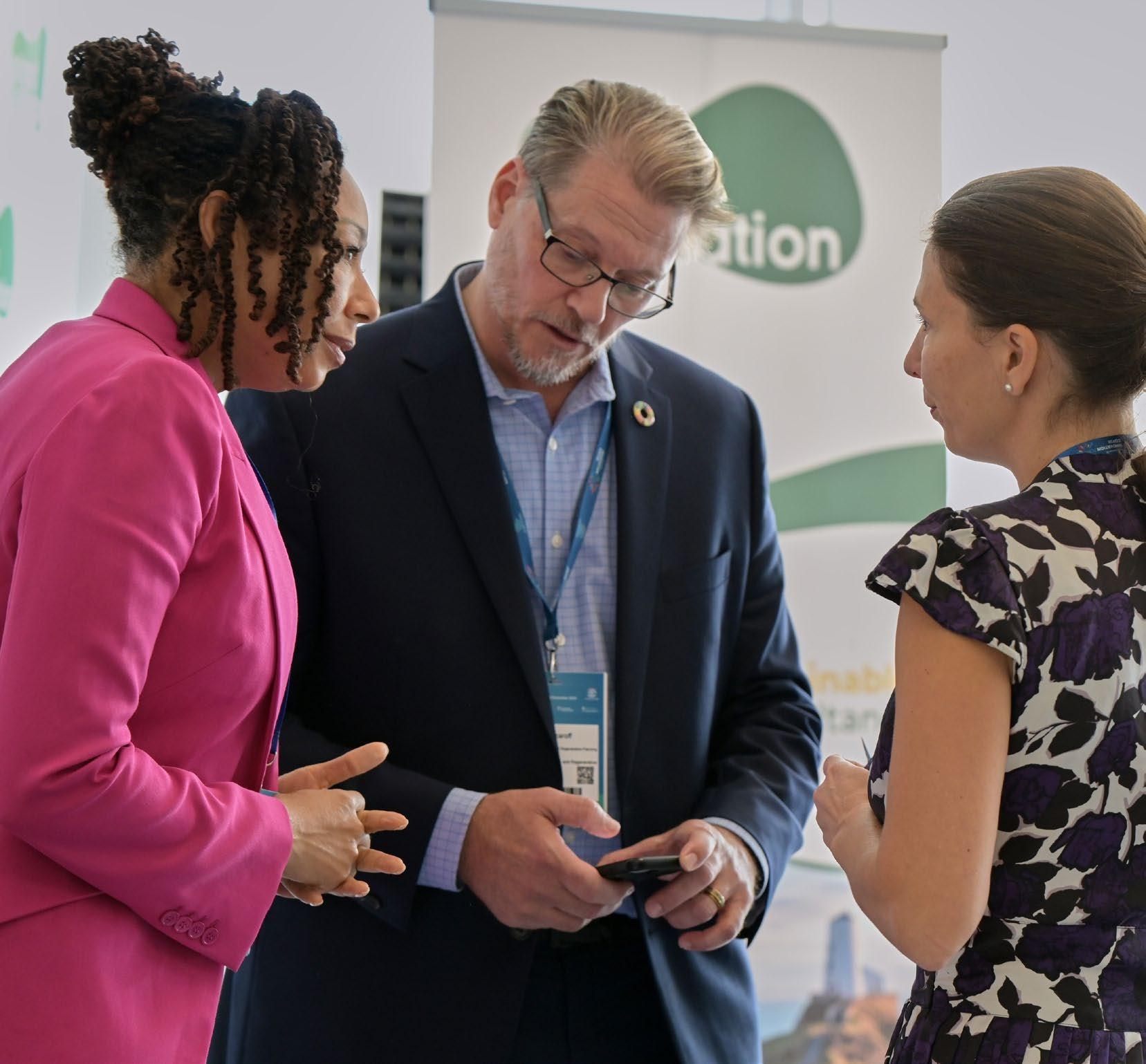
We can collectively help accelerate the rate of building renovation

In the European Union and the United States, major policies are defining efforts to reduce greenhouse gas emissions and achieve energy efficiency.
The European Climate Law, for example, establishes a goal of net zero greenhouse gas emissions by 2050 and includes legal requirements for EU countries to set intermediate targets for reducing emissions. In the United States, the Inflation Reduction Act commits to achieving a 40% reduction in economy wide GHG emissions by 2030.
As the momentum for achieving net zero economies increases, building renovation has emerged as a central emphasis due to several factors:
• Building operations, the building construction industry, and building and infrastructure materials generate 40% of annual global GHG emissions
• According to the US Department of Energy, residential and commercial buildings use about 40% of the nation’s energy for lighting, heating, cooling, and appliances while commercial buildings consume 70% of all electricity
• In Europe, the buildings sector consumes 40% of the continent’s energy demand.
• Building materials such as concrete, steel, and aluminum lock carbon emissions in place and contribute 23% of the total global CO2 emissions per year
• Projections indicate that the largest wave of building growth will occur from 2020 through 2050
Building renovation offers an environmental and economic way forward
Several methods exist for increasing energy efficiency and reducing the carbon footprint of commercial buildings. Design optimization based on reducing carbon emissions minimizes the use of materials that embody carbon and transitions to integrating sustainable materials or decarbonized conventional materials into building designs. Using recycled materials reduces the carbon footprint of buildings. Advanced connected and interoperable technologies allow equipment and
systems to communicate with one another and conserve energy while meeting the lighting, security, safety, cooling, and heating needs of residents. For example, Installing LED lighting systems and then connecting those systems to other building control systems reduces energy consumption and costs.
Upgrading buildings for reduced environmental impacts also produces a promising economic outlook for commercial property owners.
Renovations focused on green buildings that include replacing outdated lighting fixtures with connected lighting systems, installing energy-efficient HVAC systems, and using low-carbon building materials reduce energy costs. In turn, improving indoor environmental quality and sustainability promotes the health and well-being of employees and residents. Sustainable, human-centric workplaces attract tenants and respond to the expectations of staff returning to the office.

Green building projects produce higher economic returns
Certainly, a building renovation project requires an investment. However, improving the energy efficiency and occupant satisfaction of a property can yield a higher return-on-investment.
Several analyses of new green building and renovation projects compared to standard construction practices show a higher ROI within a shorter time span. Profitability increases through improved energy efficiency and decreases operating costs. The ability to attain healthy/green building certifications demonstrates the commitment to sustainability that tenants, clients, and employees seek.
Sustainable finance options offset |the challenges of acquiring the capital needed for green building and renovation projects. Blended financing allows owners to increase the scale of projects while controlling risk. Building owners may also implement renovation plans through innovative financing methods that include light-as-a-service

AS THE CONSEQUENCES OF CLIMATE CHANGE BECOME MORE APPARENT EACH DAY, THE LEVEL OF URGENCY—AND UNCERTAINTY—INCREASES. MITIGATING THE EFFECTS OF CLIMATE CHANGE REQUIRES COMMITMENT FROM EVERY INDIVIDUAL, CORPORATION, AND GOVERNMENT.
(LaaS), energy-efficiency-as-a-service (EEaaS), and energy services company (ESCO) models. Each addresses market barriers, enables energy efficient technologies through monthly payments rather than large up-front capital costs, and encourages owners to invest in energy efficiency without immediately receiving the benefit.
Mitigating climate change requires an immediate response and long-term planning
As the consequences of climate change become more apparent each day, the level of urgency—and uncertainty— increases. Mitigating the effects of climate change requires commitment from every individual, corporation, and government. While international policies set long-range targets for achieving net zero economies, efforts to reduce carbon emissions and energy consumption must continue and increase. As a result, construction companies must commit to replacing materials that contribute to emissions
sustainable building materials.
Encouraging this commitment begins with increased resolve at the corporate level to reduce emissions through green building renovations and new building designs.
Interoperable, connected technologies offer a solution for reducing greenhouse gas emissions and energy consumption. Within those technologies, LED lighting systems serve as the starting point through flexible design options, low operating costs, and excellent heat dissipation. The capabilities offered through LED lighting systems that connect with other building operations allow design teams to create sustainable office environments that appeal to tenants and occupants. Focusing on such critical solutions at COP28 can help accelerate climate change mitigation. ■
To learn more about how connected technologies align with global energy policies, read our white paper Good connectivity: A key to decarbonizing the building sector.



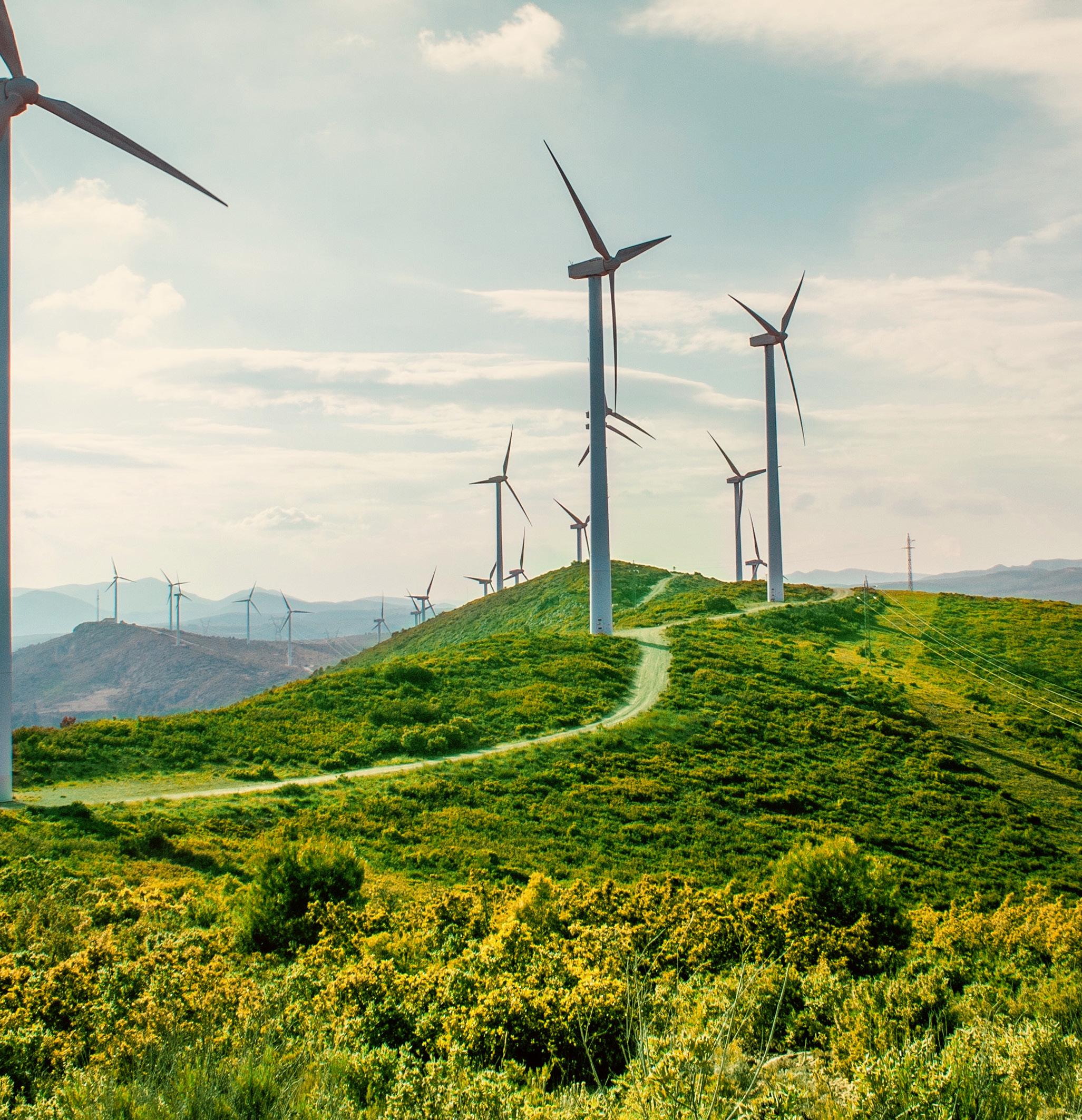
everything we do, we’ve identified three key global topics – climate change, circularity, health and wellbeing as guideposts for our efforts.
We recognize that no one can solve this challenge alone. Collaborating with customers, suppliers, academia and other stakeholders is fundamental to what we want to achieve. It’s about pushing boundaries and finding

to limit climate change and ensure the global temperature doesn’t rise more than 1.5˚C above pre-industrial levels – and are approved by the Science Based Targets initiative (SBTi).
For our own operations, we’re moving to renewable electricity and reducing our overall energy consumption. Across our value chain, we engage with our suppliers and develop sustainable
• Scope 3 downstream: the application and curing of our coatings accounts for 30% of our total carbon footprint, mainly due to coatings cured at elevated temperatures. VOC emissions make up 11% of our total footprint. We added this category to our SBTi commitment as VOCs are an important emission factor for the paints and coatings industry.

Scope 3 downstream: end-of-life to the carbon in our is released at the end accounting for 11% emissions.
target of reducing footprint in our own 50% (Scope 1 and 2), two enablers: increasing renewable electricity reducing the energy we by 2030 (versus 2018). absolute reduction perspective, Scope 1 and 2 reduced by 2018 baseline (absolute). 2021, we further emissions by 12% in We’re well on track reduction target for relative perspective, our at since 2018, while emissions reduced by 32%.
our carbon emissions operations (Scope 1 and amount of energy we committed to reducing energy consumption by (baseline 2018) and plan an ambitious 5% year-over-year reduction 2022, our absolute energy reduced 7% versus 2021, energy consumption compared with 2021, and versus 2018.
cumulative energy of improvement shutdown management installation. This helps us our performance strategy as we continue continuous improvement. programs in place, relative reduction target has been challenging, partly due to changes in our product and portfolio mix. For example, changes in our product portfolio mix include increased demand for products that take a higher energy intensity to produce. The current macro-economic environment has also impacted our volumes and therefore our relative energy consumption. In addition, the
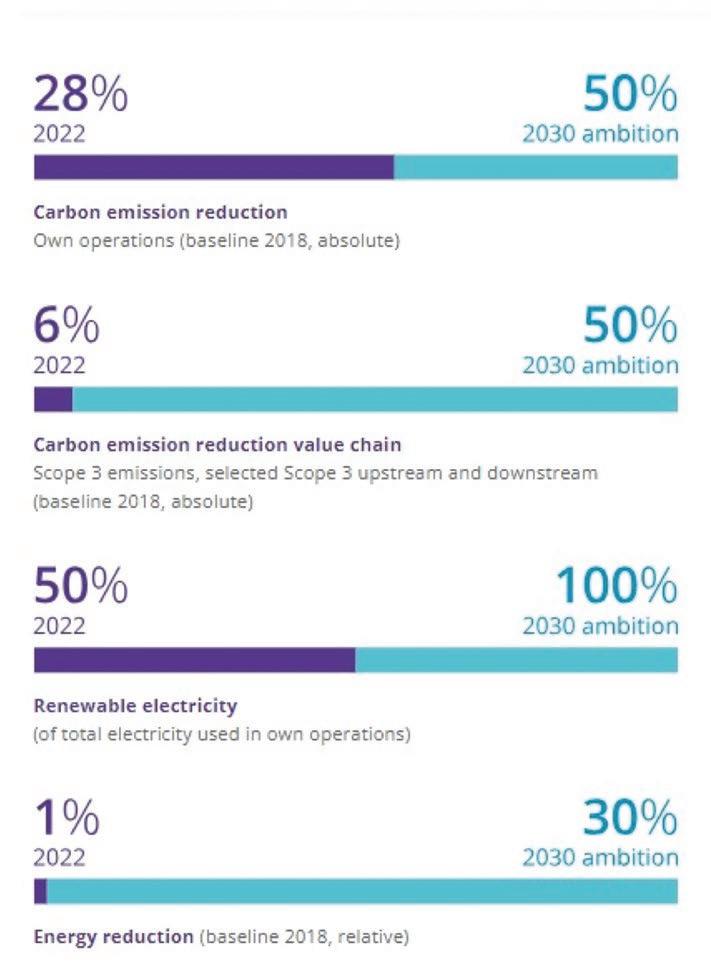
WE’RE AWARE THAT CLIMATE CHANGE COULD AFFECT OUR OPERATIONS, OUR SUPPLY CHAIN AND OUR CUSTOMERS. SO, IN 2017, WE COMMITTED TO BECOMING A CARBON-NEUTRAL COMPANY BY 2050.
VOC emission abatement systems and solvent recovery units we’re installing to reduce VOC emissions and waste are relatively energy intensive.
While an overall relative energy consumption reduction of 5% was not achieved, we’ve implemented many energy reduction initiatives. For example, our Hull site in the UK installed CEMA lighting, which reduced the lighting system’s carbon emissions by 70%.
And in France, a renewal of Montataire’s compressor room and a warehouse LED project have reduced annual electricity consumption by more than 1.8 GWh. We’re continuing to investigate targeted investment for energy reduction programs, refine our energy monitoring management and implement a renewed governance structure.
Our total percentage of renewable electricity was 50% in 2022, well on track towards our target of 100% by 2030 and already achieving our 2025 interim target of 50%.
During 2022, we continued to install solar panels at several sites and purchase renewable electricity with certificates of origin. Generating renewable electricity on site alleviates pressure on the electricity grid and further reduces our carbon footprint. In total, 53 of our locations now use 100% renewable electricity and 26 sites are using solar panels as a supplementary source of energy.
Our Izmir powder coatings facility in Türkiye completed a major solar energy project in 2022, with more than 2,300 panels installed. Similarly, our Songjiang decorative paints facility installed over 5,000 solar panels during 2022.
Three rooftop solar PV systems at AkzoNobel sites in Malaysia and Thailand have been commissioned by Cleantech Solar under long-term agreements where Cleantech Solar has funded, built, and will operate and maintain the systems throughout the term of the agreement.
Two of the sites are located in Chon Buri and Samut Sakhon, Thailand and the third site is located in Nilai, Malaysia. The combined 1.6 MW solar power plants saw 7818 panels installed across the industrial coatings sites and are targeted to avoid about 28,000 tonnes of CO2 emissions across the term of the agreement. The solar power plants has helped AkzoNobel progress towards its target in sourcing 100% renewable electricity by 2030 as part of its RE100 commitment.
The production of solvent-based paints and coatings causes emissions of volatile organic compounds (VOCs). These emissions are included in our cradle-to-grave carbon footprint. In our own operations, we achieved a relative 7% reduction versus 2021 in VOC emissions per ton of product, and a total reduction of 45% versus the 2018 baseline.
We’re reducing VOC emissions in two distinct ways. Firstly, we implement abatement technologies such as thermal oxidizers or activated carbon →


→ filters. Secondly, we optimize our footprint by concentrating solventbased production in more efficient or automated factories to altogether eliminate emissions. In addition, we’re also actively working on transitioning from solvent-based to water-based solutions where possible.
Example: Increased capacity for sustainable solutions
We’ve invested in a new production line for water-based texture paints at our Songjiang site in Shanghai, China –boosting capacity for supplying more sustainable products. The site is one of four water-based decorative paints plants in China and among our largest globally. The new 2,500 square meter facility will produce Dulux products for various markets, such as interior decoration, architecture and leisure.
Recent projects include introducing new solar energy systems and a more automated high-speed filling line.
“As our largest single country market, China has huge potential,” explains Mark Kwok, Director of Decorative Paints North Asia. “The new production line will help enhance our leading position in paints and coatings in China by expanding new markets and further driving us towards our strategic
ambitions.” China is increasingly focusing on energy conservation and emission reduction, which in turn is being reflected in the type of products customers want to buy. The production of low VOC, water-based paints will therefore need to keep expanding to meet this demand.
2022 Sustainable product solutions to address climate change
Energy efficiency: new low-curing powder coatings in the agriculture, construction and equipment market segment help our customers reduce energy consumption.
Reduced solvent emissions: we continued switching wood care and trim paints to water-based technology, which is making up more than half of our volume in Decorative Paints EMEA in 2022.
Circular solutions: we scaled up the use of bio-based renewable raw materials in our wood finishes for the furniture market.
Circularity: For AkzoNobel, the circular economy goes beyond recycling. It all starts with limiting the need to recycle. Therefore, we focus on zero waste, finding alternative sources for our raw
materials and repurposing and reclaiming materials. This commitment goes beyond our own operations. It’s a responsibility which stretches across the value chain. We work closely together with suppliers and customers, because collaborative innovation will play a crucial role in helping us to achieve our ambitions.
Paints and coatings make a vital contribution to extending the lifespan of substrates, which effectively means that circularity is built into the benefits they offer. Our products can make objects last longer, reducing the need for additional raw materials and resources, while also improving our customers’ productivity and reducing waste. Just think about how long buildings or cars would last without being coated.
We’re on a journey towards achieving 100% circular use of materials in our own operations by 2030. To get there, we’re focused on reducing the amount of waste and increasing the circular use of materials. In 2022, we achieved circular use of materials for 56% of our obsolete material and waste streams. In line with our strategy of reducing, reusing and recycling materials, our material optimization process focuses on

The amount of materials reused by AkzoNobel and third parties (reusable waste and by-products) divided by the total waste and by-products, provides the percentage of circular use of materials
diverting slow-moving and obsolete materials from incineration to internal reuse and third-party recyclers and outlets.
Over the last few years, we have managed to reduce our relative and absolute waste generation. While the disposal of slow-moving obsolete stock and legacy waste remains a continuous challenge, numerous waste reduction projects help to achieve the observed reduction. We’re driving various global programs, such as wash water recycling, solvent recovery units, and finding ways to avoid sending waste to landfill avoidance to further reduce our waste.
The bulk of our water use is for cooling (78% in 2022). This occurs at only a handful of our production locations in areas with a low water availability risk (assessed through the
Aqueduct tool). Water is also used as a raw material in paints and for cleaning. We concentrate our water consumption reduction efforts at our water intensive sites – which we define as a site that uses more than 15,000m3 per year, excluding cooling water. These sites are expected to meet our target of less than 250 liters of relative fresh water consumption per ton of product. As per our internal, best-in-class benchmark analysis, a site that consumes less than 250 liters per ton of product produced is considered to have “water reuse” measures in place. Currently 34% of our sites (42) meet the definition of a water intensive site, representing 76% of our total freshwater consumption. In 2022, 14 out of the 42 water intensive sites reached the target.

Recycled content in packaging
In 2022, we delivered towards our ambition to use at least 50% recycled content in the plastic packaging used by our Decorative Paints Europe business by 2025. Through collaboration with our packaging suppliers, we’ve been able to achieve up to 70% recycled content in our key packs without increasing the packaging weight or reducing its performance. In 2022, we updated most packs in the UK – our largest European market – and have further worked towards the roll-out in mainland Europe. Currently, almost one third of plastic packaging contains recycled content. We expect that to grow to more than two thirds of products in 2023, with the remainder to be changed in 2024.
Example: Paint the Future accelerates sustainable startup solutions
Three startups have signed letters of intent to continue working with us on sustainable business opportunities following our latest global Paint the Future challenge. The accelerator event was held in March, with the 2022 edition attracting a total of 245 submissions from 62 countries. The three winning startups were SolCold from Israel, Aerones from Latvia and the Czech Republic’s SprayVision.
SolCold’s solution is a sustainable, self-cooling coating based on antiStokes. It uses the sun’s energy to keep the inside temperature much cooler, without having to use any electricity.
Aerones brings a robotic solution to wind turbine maintenance. Their crawling robot allows technicians to safely and efficiently perform inspections, cleaning and repairs at height.
SprayVision’s solution brings a datadriven approach to optimizing spray application of paint, offering customers full control over the process. It helps to reduce environmental impact by saving material and improving quality.
Health and Well-being:
The health and well-being of our employees, customers, end-users →

→ and other stakeholders in the communities where we operate is very important to us.
2022 sustainable solutions for health and well-being: Customers and end-users benefited from several sustainable solutions launched in 2022, designed with safety, health and well-being in mind.
Reduce harmful substances: launched new food packaging coatings that are free from BPA, including Aqualure G1 50.
Anti-bacterial benefits: a new all-inone decorative paint rolled out in North and South Asia offering anti-bacterial protection due to its silver ion technology.
Safer handling: launched a new exterior wood finishes primer for high moisture resistant MDF, which is safer for users as it contains fewer substances of concern.
As we work towards our ambitious targets, we benchmark ourselves versus peers and industry. We annually review
About Akzonobel
the benchmarks we actively participate in, taking into account stakeholder preference, such as investors, suppliers and customers. We prioritize active participation in those benchmarks that help to drive continuous improvement and rely mostly on publicly available information. We’re proud that we’ve remained at the forefront of the paints and coatings industry throughout 2022, based on these ESG rating agencies and benchmarks.
• EcoVadis: We were awarded a Platinum rating in the latest review, positioning us in the top 1% of our industry.
• FTSE4Good: We were included in the latest FTSE4Good Index Series – that makes more than 15 years we’ve been included in this influential ranking.
• MSCI: We’ve received the highest possible rating (AAA) for seven consecutive years.
• Sustainalytics: We’re assessed as “low risk” and ESG top rated in our industry.
We reiterate that these ambitious goals cannot be achieved alone and invite like-minded partners and customers to join us on this journey. ■
We supply the sustainable and innovative paints and coatings that our customers, communities –and the environment – are increasingly relying on. That’s why everything we do starts with People. Planet. Paint. Our world class portfolio of brands – including Dulux, International, Sikkens and Interpon – is trusted by customers around the globe. We are active in more than 150 countries and have set our sights on becoming the global industry leader. It’s what you’d expect from a pioneering paints company that’s committed to science-based targets and is taking genuine action to address globally relevant challenges and protect future generations.
For more information, please visit www.akzonobel.com

Pamela Phua has been General Director of AkzoNobel Decorative Paints Vietnam since 2017. At the beginning of 2021, she was appointed to be Product Management Director, Decorative Paints - SESA, being instrumental in developing and maintaining a product portfolio that satisfies market demands and maximizes margins at competitive costs.
Before moving to head Vietnam Paints business, Pamela was the BU R&D Director & Global Director, Exterior Walls. In her 18 years stint in R&D, she has driven the business with new technology development and product implementation across the region, especially in Vietnam market and has successfully launched many innovative products including Dulux Weathershield / Powerflexx, Dulux Pentalite, Dulux Wash & Wear / EasyClean, Dulux Inspire/ Catylac by Dulux and Aquatech.
In her global capacity, Pamela implements the functional and production innovation strategy for exterior wall paint. She spearheads the RD&I functional excellence, standards and capability, and the efficient delivery of processes as the approved standards and processes across the globe.
Together with a special passion for sustainable development, she has led her teams to innovate paintings products and solutions through increasingly sustainable benefits for AkzoNobel customers and the environment. She also actively gets involved in sustainable activities in projects to create inspiring living spaces for local communities and to promote green architecture trends.
Pamela’s expertise and experience has been instrumental in the setting up of industry standards in Singapore. She is the President and Technical Chairperson for the Singapore Paint Industry Association and a management member in the Chemical Standards Council of Singapore. She contributed to the development of various Singapore Standards such as SS 345 (Specification for emulsion paints for decorative paints), SS500 (Specification for elastomeric wall coatings), SS150 (Specification for Emulsion Paints for Decorative purposes), SS 579 (Specification for water- based sealer for interior and exterior uses) and many others. Pamela currently leads Working Group for Fine Ceramics (for photocatalysis) and Waterbased Standards and participates in the Working Group for Energy Efficient Coatings. She is also an A*Star certified auditor for accredited laboratories in Singapore.
With a special passion for sustainable development, Pamela is actively involved in projects to create inspiring living spaces for local communities and to promote green architecture trends. She is an author for the G7&G20 summit publication advocating green developments. She is also a keynote speaker in United Nation climate Change Conferences.
Email: Pamela.phua@akzonobel.com Mobile: +65 90279663
Address: AkzoNobel House, 3 Changi Business Park Vista, #05-01 SDingapore 486051
Whether you’re seeking quality time with loved ones, or simply craving that feeling of the sand beneath your feet, our team are waiting to welcome you to our island homes. With five luxury resorts in Maldives and a beautiful beach retreat on the east coast of Sri Lanka, we’ll make sure that your dream vacation is well worth the wait.
sunsiyam.com

Sun Siyam Iru Fushi Maldives
Sun Siyam Olhuveli Maldives
Sun Siyam Vilu Reef Maldives
Sun Siyam Iru Veli Maldives
Sun Siyam Pasikudah Sri Lanka
Siyam World, Maldives
Transition financing again featured at COP 28 as an existential and one of the most challenging issues facing global transition. The emerging changes in multilateral development bank-climate finance and proposals for new platforms, such as the Energy Transition Accelerator, featured in discussions. Yet, the voices from the Global South, as well as the archipelagic island states, believe that more is needed and certainly with much greater urgency because dire climate impacts are becoming their daily reality.
The COP 28 Global Blended Finance Alliance roundtable took this agenda forward. Indonesia chaired the meeting and was represented by Alu Dohong, Vice Minister for Environment and
Forestry; Nani Hendiarti, Deputy for Environment and Forestry, Coordinating Ministry of Maritime Affairs and Investment and Cherie Nursalim, Special Advisor on Climate for the Coordinating Ministry of Maritime Affairs and Investment.
Indonesia has been a leader in driving action on transition financing.
• Tri Hita Karana Forum around the 2018 IMF-WB Annual Meeting in Bali catalyzed $10 billion for the SDGs
• Indonesia launched the THK Roadmap for Blended Finance in collaboration with the OECD, UID, and WEF around IMF WB Meetings in 2018. This Roadmap served as the foundation for the OECD to develop the G20 Blended Finance Principles.
• Indonesia established the first blended finance platform, SDG Indonesia One by PT SMI. SDG Indonesia One is a platform with an Investment mandate focused on developing large-scale SDG-linked infrastructure projects through the use of blended finance.
The importance of blended finance to address the funding gap for climate action reflects broad recognition of the role of blended finance. But, much more needs to be done. In welcoming delegates to the COP28 Global Blended Finance Alliance roundtable, Mari Pangestu, Indonesia’s Special Envoy to the G20 Bali Global Blended Finance Alliance, said that capacity-building programs and support networks with

the private sector to build bankable and transformative projects are a priority. New partnerships through south-south collaboration and better catalytic partnerships also need stronger handson support. Furthermore, training to improve data and standardization of capital mobilization towards EMDEs would be supportive of transition financing.
G20 Leaders voiced support for blended finance in their 2022 Bali Declaration. G20 Leaders supported strong global climate action, mobilizing financing, and technology transfer. The Leaders committed to help developing countries accelerate and scale investment for climate action. All recognize that there is still a significant financing gap if developing and emerging economies are to tackle climate change. But the financing gap, while significant, is equivalent to just a small fraction of global financial assets. The challenge is thus to incentivize investors to redirect a portion of their financial assets toward investment in climate action.
Reflecting this challenge, Indonesia spearheaded the inclusion of the G20 Bali Global Blended Finance Alliance in the 2022 G20 Leaders’ communique. The emphasis was on scaling up blended finance instruments for developing countries. The G20 Bali Global Blended Finance Alliance is needed to bridge the gap in SDG financing. Indonesia recognized that there remains a lack of coordination on the promotion of blended finance. To promote optimal operationalization and delivery of blended finance in developing countries, including LDCs and SIDS, G20 Leaders said that there is a need “ to engage a wide set of actors and build a global community of support. We acknowledge the proposed initiative of a new global institution by the Government of Indonesia on the Global Blended Finance Alliance that could serve as a global community of support to accelerate investment in climate action and sustainable development.”
The G20 Bali Global Blended Finance Alliance is designed as a platform to develop financial solutions involving
public and private stakeholders to address climate and other sustainable development issues. It will welcome partnerships with all stakeholders, including the private sector. Working in partnership with coalitions, the Alliance aims to reduce transaction costs by replicating learnings and building capacity within key institutions.
Unlocking capital for climate action is critical for a country’s ability to capture value from the transition. Yet most developing countries do not have funds allocated to help design and implement the right policies, partnerships, institutional structures and financing solutions for the transition. This means that decision-makers often fail to make the case for transition and are ill-equipped to link financing solutions to national priorities, climate targets, spending programs, budgetary constraints and policies to strengthen the enabling investment environment.
The Alliance aims to respond to this critical gap in institutional capacity by
working with decision-makers to tailor and implement transition finance blueprints, best-in-class blended structures and the right enabling policies to ensure it can access the long-term benefits which come from investing in climate action and the SDGs and unlocking transition finance; public, private and philanthropic capital –both domestic & international.
The Alliance aims to reduce the time and transaction costs of providing critical transition finance support. It can be operationalized with outsized impact due to the increasing focus on unlocking climate finance. It plans to work with other country initiatives including GFANZ/CFLI country platforms, the OECD, the WEF’s SDIP, the Blended Finance Taskforce’s Transition Finance Hub. These partnerships will ensure complementarity between the Alliance’s focus on financing sectoral pathways, enabling policy and access to sovereign transition finance and these transactional platforms. →
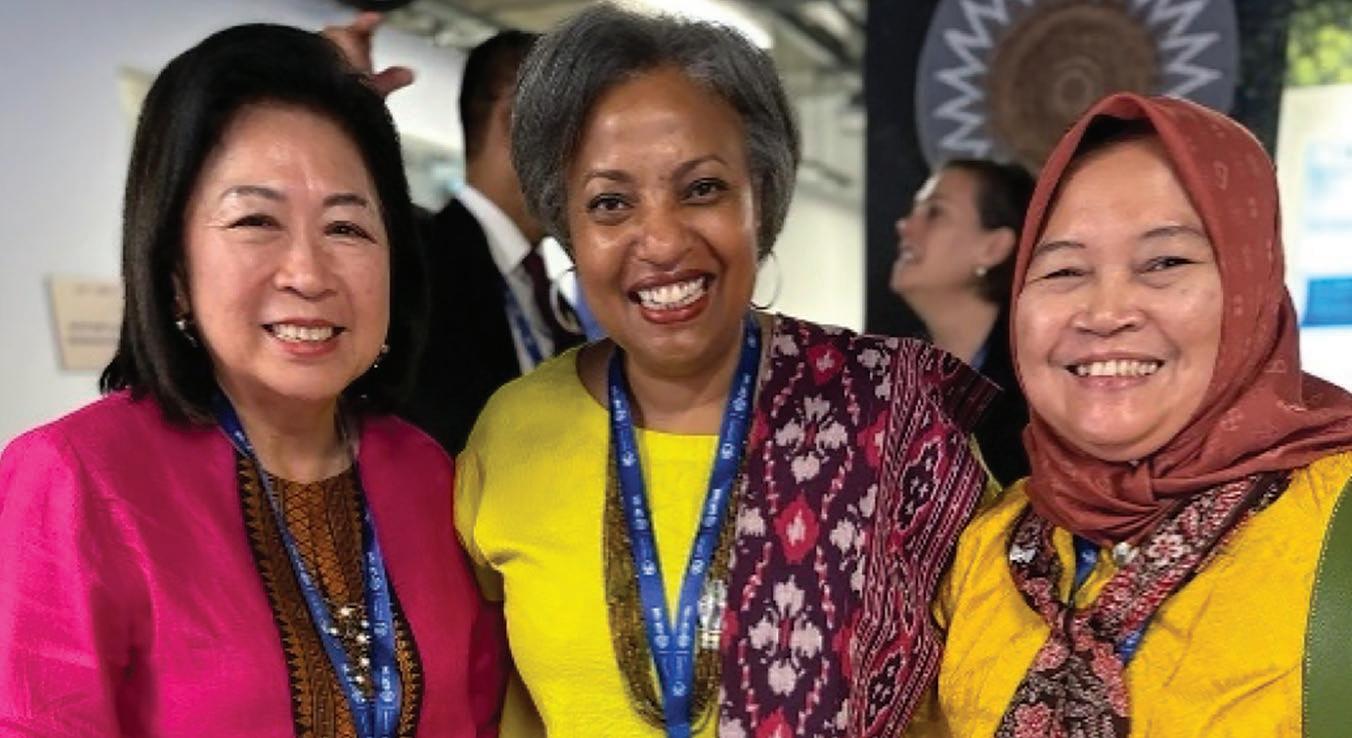
UNLOCKING CAPITAL FOR CLIMATE ACTION IS CRITICAL FOR A COUNTRY’S ABILITY TO CAPTURE VALUE FROM THE TRANSITION. YET MOST DEVELOPING COUNTRIES DO NOT HAVE FUNDS ALLOCATED TO HELP DESIGN AND IMPLEMENT THE RIGHT POLICIES, PARTNERSHIPS, INSTITUTIONAL STRUCTURES AND FINANCING SOLUTIONS FOR THE TRANSITION.
→ The G20 Bali Global Blended Finance Alliance will have important immediate tasks. These include facilitating policy development to accelerate the use of bilateral donor assistance/MDBs to mobilize funds from the private sector. Building capacity, knowledge sharing and best practices to reduce transaction costs with proven replication, knowledge and financial innovation. Building and supporting networks with the private sector that can accelerate pipeline project development, reduce risk perceptions, simplify transactions and support transparency with a view to enhance private sector involvement and ownership. Employ data and standardization to reduce risk perceptions and undertake more impact-related evaluation.
The Global Blended Finance Alliance roundtable at COP 28 included representatives from United States of America, Republic of Korea, Singapore, United Kingdom, and Denmark. The World Bank, Asian Development Bank OECD and the International Chambers of Commerce.
The Roundtable concluded that the G20 Bali GBFA will bring value add from facilitating policy development, share practices on G20 Principals on Blended Finance, how to accelerate bilateral assistance to design transition pathway, and country-owned design; capacity building – partnership with bilateral partners as well as through the learning process between developed and developing countries.
South-South collaboration, cocreation and acceleration are a key aspect of the G20 Bali Global Blended Finance Alliance. Countries have expressed interest to partner with the Alliance to accelerate South- South collaboration and co-creation to mobilize domestic and international capital to the global south. Examples of south-south of learning are Namibia’s request to Indonesia to help them create their SDG Namibia One Fund. Another is the Trilateral Forest Powers for Climate Partnership (IndonesiaBrazil-DR Congo) group launched last year, not least is the Just Energy Transition Partnership with IPG countries and GFANZ.
Domestic capital mobilization is a critical lever for climate action and South-South collaboration - especially to share policy innovations. EMDEs alone have an estimated ~$17 trillion under management - much of which could be deployed for low-carbon energy, clean transport and other sustainable projects. Creating a strong EMDE domestic capital collaboration could be a differentiator for the G20 Bali Global Blended Finance Alliance.
The Alliance can support South-South collaboration and co-creation but also South-South acceleration - moving faster to replicate success stories.
Uniquely positioned to scale blended finance mechanisms that work and build capacity to execute faster to unlock capital for people and planet, The G20 Bali Global Blended Finance
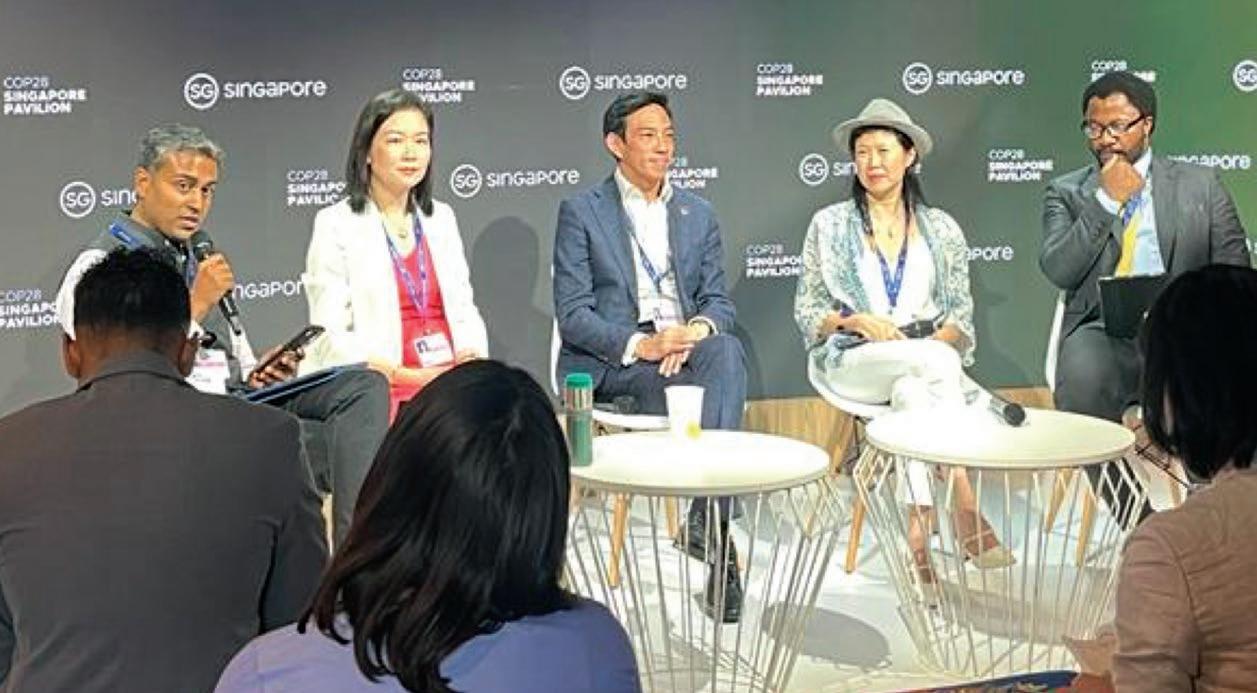
Alliance is an innovative and effective finance mobilisation accelerator that serves as a platform for private sector, philanthropy, and others. Success will come from focusing on structuring projects that take into account the local situation of the developing countries.
Indonesia is looking for the announcement of the new Secretariat and signing with initial member countries the G20 Bali Global Blended Finance Alliance in May 2024 around the 10th World Water Forum in Bali, Indonesia. ■

H.E. Retno Marsudi, Minister for Foreign Affairs of the Republic of Indonesia
While COP 28 marks significant milestone to unite, act and deliver, with a landmark move on the loss and damage fund, there is still much to be done.
First, climate actions at the national level must be strengthened. Just like Indonesia, to lead by example. We have enhanced our NDC to 31,89% unconditionally and 43,2% with international support.
Furthermore, we are committed to reaching 23% of renewable energy in our national energy mix by 2025. In the forestry sector, deforestation has reached a historic low of 104 thousand hectares in 2022. Moreover, we aim to rehabilitate our mangroves up to 600.000 hectares by the end of 2024.
Second, realizing support for developing countries is a prerequisite. The world cannot stop only at pledge. We are at a crossroads, and it is time to act.
Third, living the spirit of a just transition, which leaves no one behind, acknowledges differences in national circumstances, aligns with economic growth and empowers society.
Indonesia looks forward to collaborating with all parties to deliver a successful global climate agenda.













As the global community intensifies its efforts to combat climate change, the innovative approach of E-liability has taken centre stage. E-liability represents a paradigm shift in how organisations measure, report, and offset their carbon emissions. Developed by Professors Robert Kaplan (Harvard) and Karthik Ramanna (Oxford), E-liability is an approach to corporate carbon accounting that applies principles of financial accounting to allow organisations to produce real-time, accurate, and auditable data on their total direct and supplier emissions, and those for any of its products and services.
Chief LaurenE-liability enables organisations to continuously reduce their own supplychain emissions through innovations in operational and sourcing decisions by making emissions a factor in every business’s purchasing and investment decisions, like price or quality. E-liability accounting holds each business accountable only for its direct emissions and the actual upstream emissions embedded in the inputs it purchases from suppliers. This solves the problems of multiple-counting and guesstimates in current carbon accounting practices and allows organisations to produce real-time, accurate, and auditable data on cradle-to-gate emissions for any of
its products and services.
Over the past 12 months, several industry leaders have been early adopters of the E-liability approach, obtaining and leveraging carbon information from suppliers and their own operations to improve their own carbon footprints and offer customers the opportunities to improve theirs.
A Southeast Asia-based global tire manufacturer, Giti Tire, was the first to pilot the E-liability approach. Launched in G20 Bali and published in Harvard Business Review, Giti engaged E-liability to calculate the total emissions to produce a standard passenger-car tire, a product that is both crucial to the
global economy and, given its high carbon-footprint, and one where emissions-reduction excellence will be essential to fighting climate change.
Giti Tire collaborate with BMW and Volkswagen and auto cluster to outreach suppliers to learn how to source low-emission, high-durability materials that reduces fossil-fuel usage over a car’s lifetime operations.
Similarly, Heidelberg Materials, one of the world’s largest cement producers, has successfully piloted E-liability principles, leading to enhanced visibility into its emissions across various production stages. Cement production is a major contributor to global warming, responsible for up to 8% of global CO2 emissions. Heidelberg wanted to explore ways of reducing its contribution to that number. Focusing on the dominant contributors to cement-related emissions, Heidelberg used the E-liability algorithm to calculate the actual carbon content from current cement recipes, production processes, energy purchasing, and materials sourcing, and provided its customers with information on product-level emissions.
Tata Steel and Hitachi Energy have also made significant strides, utilising E-liability to bolster their commitment to sustainability and align with global climate goals. Tata Steel, which is part of India’s largest conglomerate Tata Group, analysed the carbon content of steel produced through various methods and used the E-liability methodology to differentiate what is effectively a commodity product on emissions grounds. Hitachi Energy worked with three tiers of its supply chain to analyse the E-liabilities of electrical transformers. The case study, published in November 2023, describes the fascinating insights into the copper supply chain and cradle-to-gate emissions of Hitachi products discovered during the course of the pilot.
Pilot studies illustrate how companies can implement the E-liability framework to green their supply chains and operations, using accurate, real-time carbon accounting to effectively manage their environmental impact. The E-liability Institute was established in November
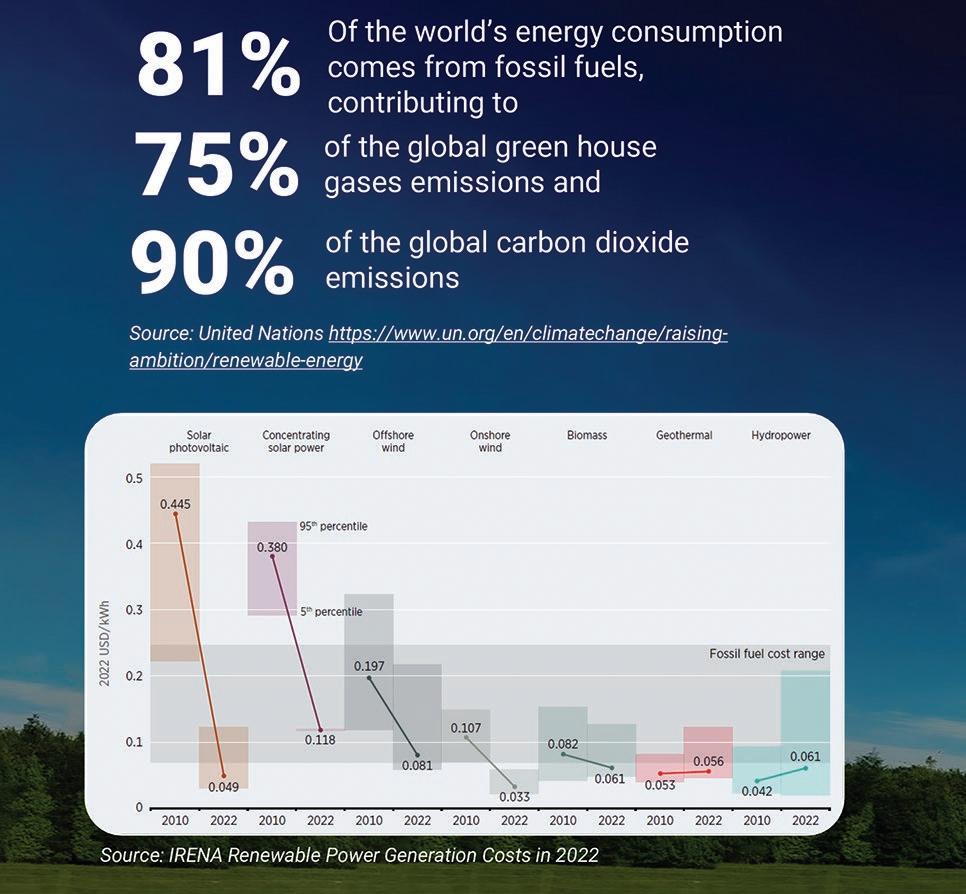
OVER THE PAST 12 MONTHS, SEVERAL INDUSTRY LEADERS HAVE BEEN EARLY ADOPTERS OF THE E-LIABILITY APPROACH, OBTAINING AND LEVERAGING CARBON INFORMATION FROM SUPPLIERS AND THEIR OWN OPERATIONS TO IMPROVE THEIR OWN CARBON FOOTPRINTS AND OFFER CUSTOMERS THE OPPORTUNITIES TO IMPROVE THEIRS.
2022 to support organisations that are piloting adoption of the E-liability method. Looking ahead, 2024 holds the promise of even more ambitious E-liability pilots, driving emissions reduction and decarbonisation innovation worldwide.
The significance of E-liability extends beyond individual corporate commitments. The Institute also seeks to catalyse the broader ecosystem of policymakers, regulators, standard setters and investors to urgently upgrade the global standards for carbon reporting and to drive decarbonisation innovation. The implementation of Carbon Border
particularly in Europe, highlights the need for accurate carbon accounting on a global scale. E-liability, with its ability to provide real-time and verifiable emission data, becomes a linchpin in the successful execution of policies like CBAM. As nations and organisations strive to meet ambitious climate targets, E-liability emerges as a beacon of hope, offering a tangible solution for measuring and mitigating carbon emissions. ■
Robert S. Kaplan, Karthik Ramanna, and Stefan J. Reichelstein, Getting a Clearer View of Your Company’s Carbon Footprint, Harvard Business Review, April 03, 2023
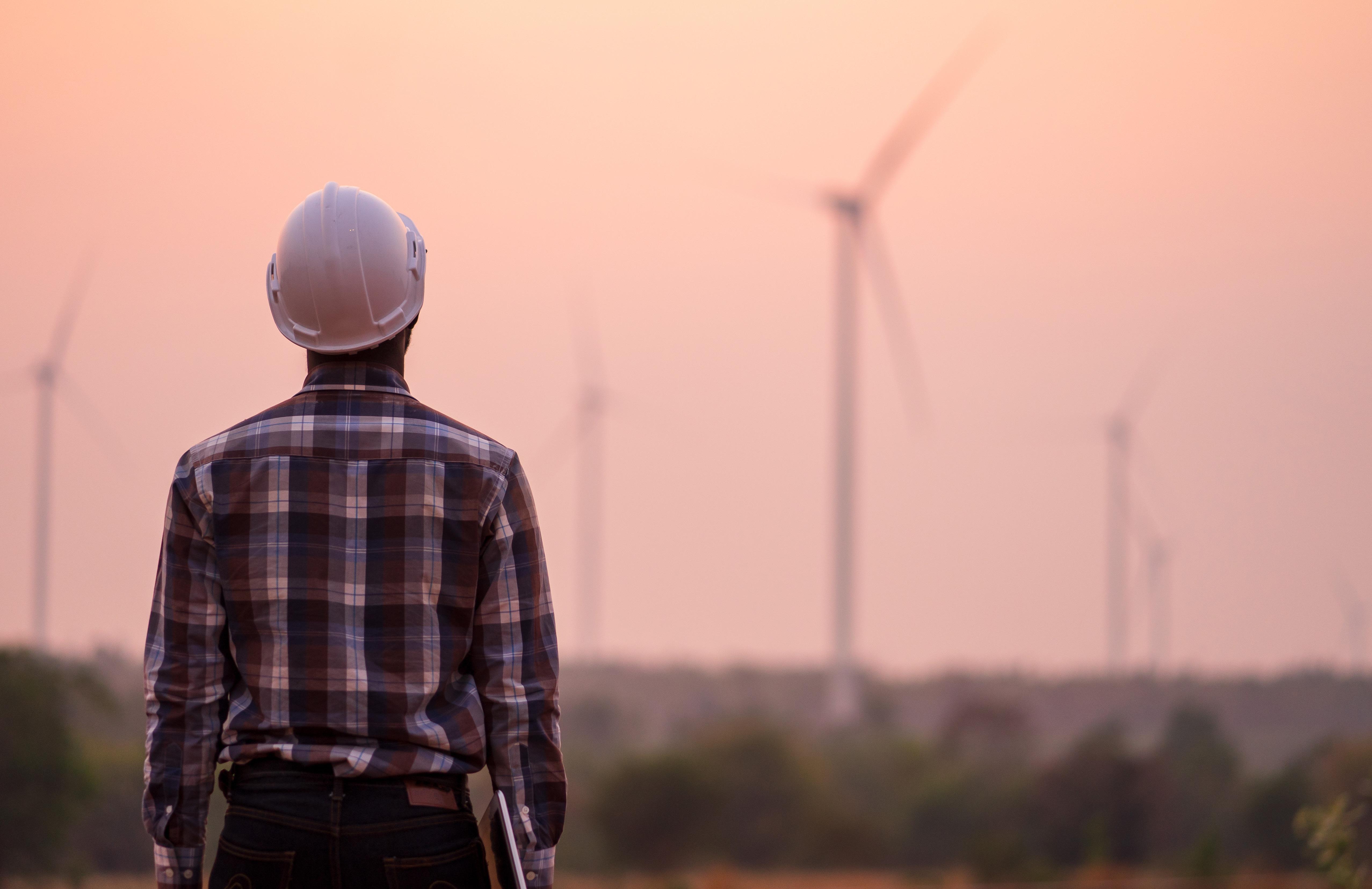

The Global Infrastructure Hub is a not-for-profit organisation and a knowledge hub for advancing the delivery of sustainable, resilient, and inclusive infrastructure.
Formed by the G20, we collaborate across the public and private sectors to produce data insights, practical tools, and programs that help our stakeholders create positive impacts through infrastructure.
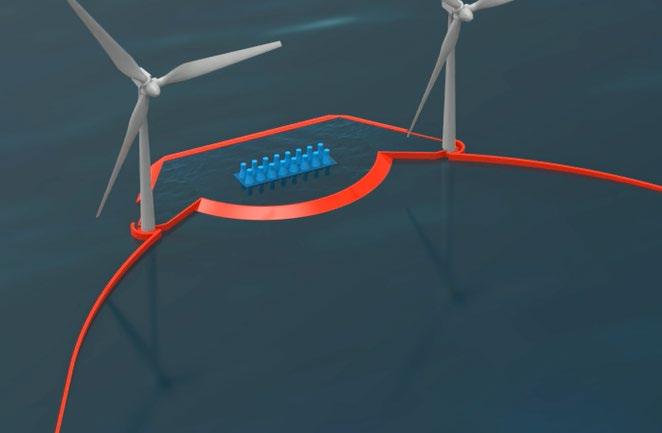
In just a few decades, companies engaged in some kind of technology, concept or solution dealing with the environmental impact of how we produce, live and consume have sored. That’s obvious to anyone. According to Statista.com, the global market for clean energy technology was USD 326 billion in 2023 and the global waste recycling market was an estimated USD 58 billion in 2022. These markets are expected to grow considerably over the coming years.
With the constantly growing focus on reducing carbon emissions, developing sources of clean energy and reducing, reusing and recycling waste, it only makes good sense for our world to support the innovation and expansion of any such technologies serving these purposes.
Supporting innovation is happening on many levels. For early stage R&D initiatives, grants from national governments, the EU, the EDA (US) and the like are available, combined with the inventors’ own funds and

efforts, and supplemented by the occasional private funding on business angel level.
The challenge for large-scale cleantech innovation is the gap they fall into when having completed the innovative developments and having tested the solution on pilot plant or demonstrator level. They are ready for the next step, setting up or building a full-scale version of their technology – often what they would call their MPV (Minimum Viable Product). They are now often outside the scope of
support from the various grant sources, but still not at a level where the first version full-scale technology is proven to be commercially viable – making the professional investors reluctant to get on board.
Three cases of large-scale cleantech projects with this challenge: FIRST CASE:
The problem for the world is building renewable energy capacity as fast as possible and at the same time ensuring cost-efficient production, to reduce the carbon footprint from the traditional sources of energy generation. One of the key constraints for building capacity is location, having enough surface space available. The obvious place to look is offshore – ample ocean space is available. So it is with good reason, that floating wind is experiencing a surge in interest and test deployments. Add ocean energy to this, and we certainly have deployment space worth exploring. The

key focus for successful exploitation is on optimising the efficiency of the energy technologies, securing access to grid connection etc. targeting how to reach an acceptable cost per kWh for society.
IRENA (International Renewable Energy Agency) estimates that the wave energy potential is some 29.500 TWh per year, more than the total global electricity consumption (estimated to be around 22.500 TWh in 2022; Statista.com). Combining wave energy with wind energy could double the energy potential within the same exploitable surface area. Now we’re exceeding an energy potential of more than twice the global electricity consumption.
Wave Dragon is an offshore floating platform converting waves and wind energy into electricity. It offers some of the largest unit sizes in the offshore arena, featuring capacities from 3 MW to 38 MW per unit, which equates to one unit being able to generate enough electricity to power from

Through this development process, the technology has been pivoted several times, and with a recent pilot plant operation, EnviraBoard is now ready with the 3rd generation technology.
worldwide every year. More than half of the raw material for this is coming from recycled sources.
During the production process, using the recycled waste as raw material, around 30% of the mass entering production ends up as waste, so now a secondary waste. EnviraBoard has developed a proprietary and patentable technology to use this secondary waste as raw material to produce high-quality and versatile building boards for the construction industry. Using this secondary waste as raw material, instead of disposing of the waste via incineration, which seems to be a commonly used disposal method of several possibilities, the process offers a significant reduction in the carbon footprint. The EnviraBoard boards themselves offer properties and qualities which exceed many of the commonly used building boards.
Industry sources suggest we may have up towards 10.000 paper mills in the world of which a few thousand operate with a recycling facility – hence they have this costly waste disposal problem with their secondary waste.
2.000 homes up to 30.000 homes. Wave Dragon is highly scalable and connecting several units creates utility-size power plant capacity.
Some EUR 15 million has been invested in the development, and the next step is the construction of a 3 MW commercial power plant unit. This being Wave Dragon’s MVP, the showcase of what customers would buy – is this considered completion of innovation and technology development? Or is it the first step into the commercial arena? Many private investors say this is technology development, and many grant providers say this is commercial development!
The problem for the world is dealing with huge volumes of waste resulting from newspapers, magazines, cardboard and similar paper and packaging products. According to BIR (Bureau of International Recycling), more than 400 million tonnes of paper and cardboard are produced
During the years of developing the EnviraBoard technology some EUR 20 million has been consumed in the process. Through this development process, the technology has been pivoted several times, and with a recent pilot plant operation, EnviraBoard is now ready with the 3rd generation technology. The next step is building a full-scale factory to produce the building boards. The factory will be EnviraBoard’s MPV and the showcase to the world, and what customers would buy – is this considered completion of innovation and technology development? Or is it the first step into the commercial arena? Many private investors say this is technology development, and many grant providers ay this is commercial development!
The problem for the world is dealing with huge volumes of plastic and glass waste. More than 500 billion PET plastic bottles are produced every year. Papiro’s mission is to reduce the impact of plastic and glass food and beverage packaging by introducing a recyclable and compostable natural fibre bottle. Mismanaged plastic waste threatens the biosphere and contaminates food chains. In addition, the production of plastic and →
→ glass relies heavily on fossil fuels. Papiro uses renewable, plant-based materials to produce beverage containers and closures compatible with paper and compostable recycling streams. The Papiro solution is patented, and the process can be adapted to different plant-based fibre types, taking advantage of local sourcing of raw materials, and implementing local bottle production, minimising transportation costs.
The Papiro development activities are ongoing at DTU (Technical University of Denmark), and funding so far has been grants and university support, besides the significant efforts and contributions from the team engaged in the development activities.
When R&D has been completed at university level, the natural next step is building a full-scale factory to produce the sustainable bottles. The investment to build such a factory is so far estimated in the range of EUR 20-30 million. The factory will be Papiro’s MPV and a showcase to the world, and what customers would buy – is this considered completion of innovation and technology development?

Or is it the first step into the commercial arena? Many private investors say this is technology development, and many grant providers say this is commercial development!
The shared challenges
Common for the 3 outlined projects, as for many other large-scale cleantech innovations, is that they share the gap they are faced with. The gap between growing out of the innovation and development phase and reaching the commercial stage –but without having proven to be commercially viable with the full-scale technology – a gap which requires funding at the level of EUR 20-30 million for many of such large-scale cleantech initiatives.
The challenge is, that funding for the first full-size entity is beyond what venture capital providers typically invest. Private equity finds the capital need and the investment level interesting, but mainly wants to invest in revenue generating businesses. Industry players tend to focus on project and production development and categorise such investments more as a technology development. So that’s the gap to be closed!
Nothing is black or white – Some funders in the market will take a punt and support the large-scale cleantech developments. But it comes with significant efforts and resource allocation for the cleantech innovators, to overcome this challenge, identify the funder and close the gap.
The need for a twodimensional business model
Another commonly shared challenge for his kind of large-scale cleantech development is the need to focus the commercial development on a two-dimensional business model.
They need one business model and strategy for selling the output from their production, whether that is kWh, cubic meters, square meters, kilograms, tonnes, litres, pieces, or other units.
Then they need a second business model and strategy for succeding with selling their production plant/set-up – and here they are faced with the many delights of very diverse international environments when it comes to the regulatory conditions.
Expanding large-scale cleantech companies internationally Cleantech companies have to operate in the zone between taking a professional
commercial approach to developing their business with a focus on the bottom line –and at the same time being hugely impacted at national policy levels; the national and local regulations, required approvals, environmental impact assessments, needed consents etc. All this comes at a huge expense in time and money, not only from what is required of knowledge and manpower internally but often the need to hire local expertise in the form of consultants and advisors, to navigate the local complexities. Different countries have different regulations, standards, and procedures that must be followed, making it challenging to replicate a success achieved in one market to another market. Many local factors such as energy infrastructure, waste recycling culture, consumer behaviour, support mechanisms and economic conditions all play a role in how cleantech companies succeed in particular markets.
To address this hurdle, cleantech companies must as traditionally done when internationalising, conduct thorough market research, including understanding the local demand for their products, consumption behaviour, and identifying potential competitors. All this leads back to the funding gap as outlined – The diverse regulatory environments, and the long time it often takes to make headways within the complexities of regulations, means that more money is needed earlier on to account for these long sales cycles and market penetration times. Hence the gap is getting deeper with more money needed up front.
Cleantech companies are paving the way for a cleaner, sustainable future. As consumer awareness continues to increase and demand for clean products, solutions and technologies rises, even greater growth in the cleantech sector will be the result. Across the world, it is often experienced that the mindset and approach of professional investors are fairly similar and a company seeking to raise funding is faced with good consistency in the due diligence questions they are met with. Once you got the documentation and foundation in place as a company on a fundraising mission, you are reasonably well-dressed to engage with investors regardless of their geographical location.
On the policy side, on national and regional levels, incentive programs, tax breaks, capital grants, and revenue subsidies are made available to support the development and deployment of clean technologies. However, there are significant complexities around what is offered and how to qualify for the support, and the minute we look across different jurisdictions, the regulatory environments and the consent and compliance processes differ immensely. What is urgently needed is a much stronger focus on aligning these policy mechanisms cross-boarders, to facilitate a faster and more efficient development and buildout of large-scale clean technologies. As much as regional and national interests often tend to support “companies in our own backyard”, we are all on the same side of the table when it comes to mitigating any
negative impact of production and consumption on all levels in our societies.
Simplification of the policy foundation would ideally comprise three areas:
1. Capital grant support with high levels of funding for the innovation activities. (Grant support is often seen from as low as 30% up to 50%-70% and only in a few selected cases 100%. More substantial support will facilitate reduced innovation times).
2. Long-term stable revenue support for innovations ready to step into the gap-phase. (Revenue support will offer financial predictability. From investor perspective, when they engage in due diligence, only technologies which appear to be
commercially sound and viable would get funding – hence saving tax-payers money by not offering capital grants in the gap-phase of the technology development, reducing the risk of supporting questionable technologies).
3. Aligning the regulatory environments between countries, will significantly facilitate a less complicated geographical expansion of good sound large-scale cleantech technologies. No doubt, this is the major hurdle to tackle.
Is all this utopia? For many cleantech companies, it is! But to the benefit of us all, this is the direction we need to move in. The world is changing – fast! So hopefully experiences of the past will not be the way of the future! ■

 Ilham Aliyev PRESIDENT OF THE REPUBLIC OF AZERBAIJAN
Ilham Aliyev PRESIDENT OF THE REPUBLIC OF AZERBAIJAN
As the host of COP29, Azerbaijan is in an active phase of preparation for this global event. We have less than one year for preparation. So, we are doing all our best in order to deliver good results.
Being elected by unanimous decision as the host country for COP29 is really a big honor for us. We consider it as a sign of respect from the international community to Azerbaijan and what we’re doing, in particular, in the area of green energy. Definitely, it’s a huge responsibility because we not only need to organize a good event but also deliver good results. I think that Azerbaijan’s international connections and active involvement in different international organizations will allow us to build bridges or strengthen bridges, and solidarity between the countries of different continents.
I mean that we have held the chairmanship of the Non-Aligned Movement for several years - for four years - a movement that unites 120 countries. We were elected by unanimous decision, and our chairmanship was extended by unanimous decision for one year. During our chairmanship, we established very fruitful relations with many members of the Movement. Our chairmanship coincided with COVID-19. So, we acted in a very responsible way and provided humanitarian, financial, and technical assistance to more than 80 countries. So, this international platform, I hope, will allow us to engage countries of the Global South in the common agenda. At the same time, relations with many European countries are also developing successfully. With nine EU members, Azerbaijan signed or adopted agreements and declarations on Strategic Partnership.
So, saying that, I hope that these international connections will allow us to strengthen solidarity. That’s mainly what we need. We need finance. We need solidarity, and we need shared responsibility.
As a country rich in fossil fuels, Azerbaijan is a member of the OPEC+ platform. I think that this is also an additional advantage. Because we think that a country rich in natural resources, particularly oil and gas, should be at the forefront of those addressing the issues of climate change. So, these different layers, I think, will create a good spirit of solidarity and will allow us to reach our goals. As we were elected as the host country of COP, the main focus of some media outlets was on our energy portfolio and energy background. I have always said that having oil and gas deposits is not our fault. It’s a gift from God. We must not be judged by that. We must be judged based on how we use these reserves for the development of the country, to reduce poverty and unemployment, and on what our targets are with respect to the green agenda.
Our oil and gas will be needed for many more years, including in European markets. In 2022, the EU and Azerbaijan signed the Memorandum of Understanding on Strategic Partnership in the field of energy, and our natural gas supplies to the European Union are growing. This was the request of the European Commission. We responded positively to that. Currently, half of our natural gas exports, specifically 12 billion cubic meters, are going to the European Union market. Based on the mentioned Memorandum, our exports to the EU should reach 20 billion cubic meters by 2027.
We all understand that this is a sign of responsibility of Azerbaijan in this geopolitical situation. Because we are largely investing in increasing our gas production. Because Europe needs more gas from new sources. At the same time, our green agenda started to materialize prior to being awarded COP29.
We have already started huge projects for green transition with our foreign partners and investors. This year in Azerbaijan was declared he “Green World Solidarity Year”. Only this year, the groundbreaking ceremony for power stations will be held, allowing us to produce 1300 megawatts of solar and wind energy. By the end of 2027, we hope and actually assured - because contracts have been signed – that we will have 2000 megawatts of green solar and energy operational. There will be nine power stations, and by 2030, an additional 10 solar and wind power stations will produce 5000 megawatts (five gigawatts) of electricity. Using this potential, we will largely substitute our gas consumption for electricity production. As for the volumes, I think that at least an additional five billion cubic meters of gas will be exported to Europe. So, it’s actually a win-win situation. We have created a very good investment climate. All these green energy projects I mentioned are financed by foreign investors.
Azerbaijan just provides its infrastructure and a very friendly investment climate. We will save a lot of natural gas, which Europe needs. At the same time, we are currently in the final stage of a feasibility study to build integrated transmission lines from Caspian offshore wind farms to Europe, including a subsea cable under the Black Sea. This will allow Azerbaijani green energy, a volume of four gigawatts, to be exported to Europe. Our proven reserves of offshore wind energy are 157 gigawatts. So, this is an illustration of the potential.
For many years, wind has caused certain discomfort for Baku inhabitants, but now wind energy will generate a lot of activity, cooperation, partnership, and will strengthen energy security. So, my final point is that energy security should definitely be treated as a matter of national security of the countries.
There should be no discrimination. As the head of a country rich in fossil fuels, of course, we will defend the right of these countries to continue investments and production because the world needs it. But at the same time, countries with fossil fuels, as I have already mentioned, should be among those demonstrating solidarity with respect to issues related to climate change.
“Being elected by unanimous decision as the host country for COP29 is really a big honour for us. We consider it as a sign of respect from the international community to Azerbaijan and what we are doing, in particular, in the area of green energy.”












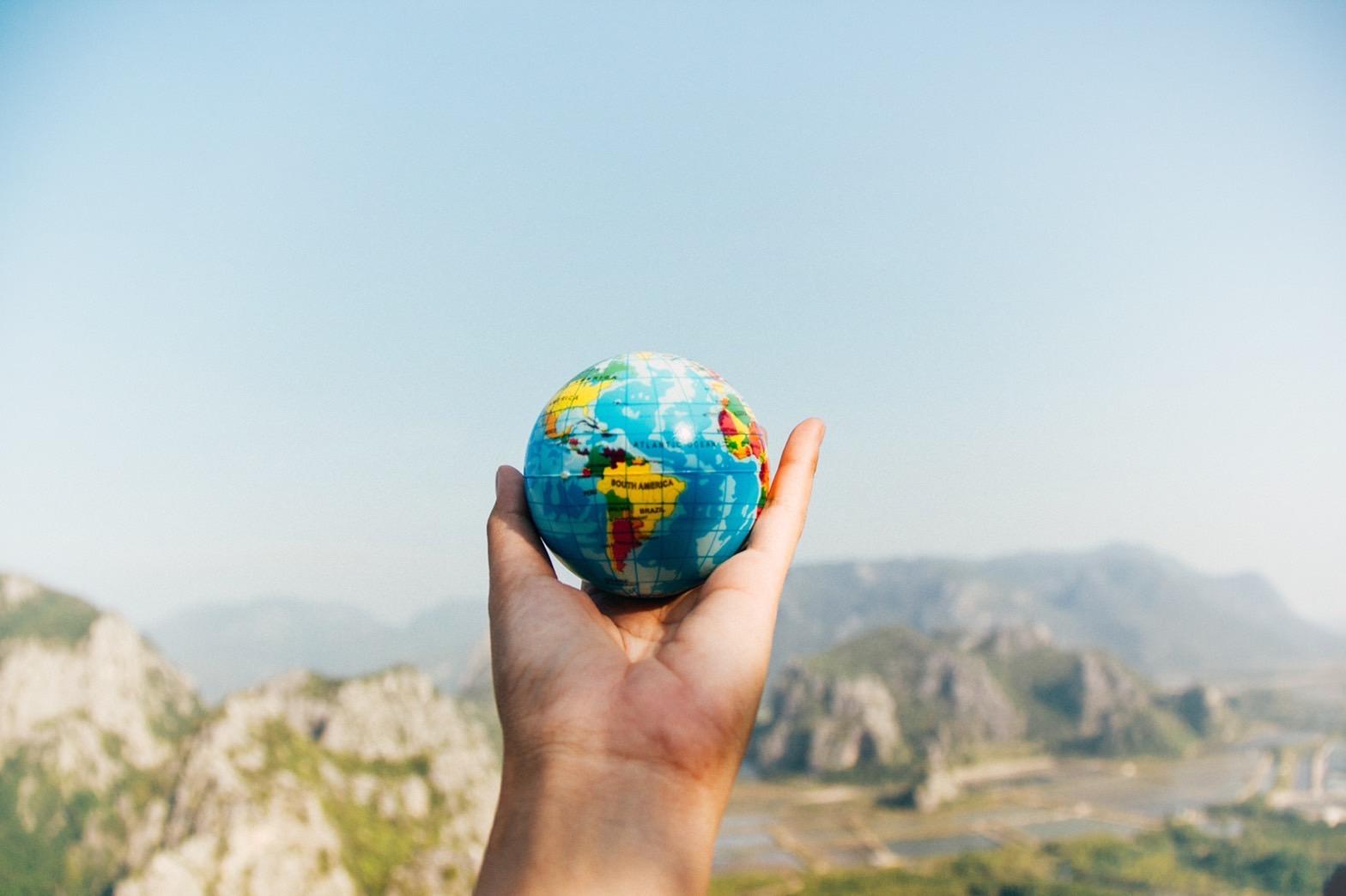
Real actions from all of us are needed to achieve the SDGs by 2030. UNIPLAT presents so everyone—regardless of their country, race, religion, economic situation, etc—can contribute to the initiatives of bringing a bright future to this world.



